PART 3
EXPRESSING A CULTURAL IDENTITY
Wood Studs, Stucco, and Concrete:
Native and Imported Images
David Gebhard
California architecture has enjoyed an international renown since the early years of this century. A mention of California and its architecture brings to mind the work in Northern and Southern California of the 1920s through the 1950s of such modernist "name-brand" designers as R. M. Schindler, Richard J. Neutra, Lloyd Wright, and William W. Wurster. California's peculiar social and physical environment also inspired a number of nonregional figures—Bertram G. Goodhue, Frank Lloyd Wright, Eric Mendelsohn, and Louis I. Kahn—to design some of their most significant buildings within the state.
European and American architectural journals after World War II regularly discussed and illustrated the designs of the Bay Area architects Joseph Esherick and Charles Moore, and, in Southern California, John Entenza's Arts and Architecture Case Study House program elicited widely admired examples of modernist design. The work of Frank O. Gehry, Eric Owen Moss, and others, moreover, now garners as much attention worldwide as their modernist predecessors did from the twenties through the fifties.
In architecture the impact of the state's traditionalists has been as impressive as that of the modernists. The work of traditionalist architects like George Washington Smith and Wallace Neff firmly established the Spanish Colonial revival nationwide in the 1920s. And America's love of period revival was firmly asserted in the residential work of such California architects as Paul R. Williams, Gordon B. Kaufmann, Reginald D. Johnson, Roland E. Coate, and Gardner Dailey.
How these and other California architects have dealt with the relationship between structure, materials, and imagery constitutes yet another important contribution to twentieth-century architecture. In their writings about this relationship, these architects evoked images as complex and often as contradictory as their modernist and traditional architectural images.
In its August 14, 1936, issue the Los Angeles-based magazine Southwest Builder and Contractor published an excerpt from a talk given by Leicester B. Holland of the Division of Fine Arts, Library of Congress. Himself an architect, Holland wrote often on architecture during these years; he was a highly articulate opponent of modernist architecture, then emerging.[1] In his 1936 talk, he addressed the relation between the objective, functional element of architecture and the nonmeasurable aesthetic element:
To the mathematician 6 + 2 amounts to just as much as 5 + 3; to the architect it may be considerably less; while 4 + 4 may total up to a great deal more. Why it should be that the whole is something so much greater than the sum of all of the parts I cannot say, except that architecture is an art, and that is the nature of art.[2]
Holland equated mathematics, his frame of reference, with what is rational, objective, and measurable in architecture.
Holland was thinking not only of the game the modernists were then playing with the illusion of function and the fact of aesthetics, but of the whole European-American tradition of hiding aesthetic decision behind the notion of utility and function. From the late nineteenth century on, the architects of California not only participated in this game with great delight but also developed new ways to play it. Holland's reference to mathematics and the mathematician should be translated into those aspects of architecture which are measurable and factual—such architectural elements as structure, materials, construction technology, and a building's mechanical core as well as the response of a building and its site to the specific environment and the social, political, and economic conditions of the time.
The nonmathematical element in architecture—more important to Holland than utility and function—is the design of buildings, architecture as "art": the aesthetics of proportion and scale; the use of past architectural images; the use of architecture and siting to create illusions of place and connections to other places, distant in location or remote in time.
The creation of illusions of contrast and contradiction has always been part of architecture and became a staple of California architecture. Particularly in Southern California, architects seized the opportunity not only to project buildings onto a site but also, through the symbols embodied in architecture and landscape architecture, to transform a whole landscape. The illusions could be far-reaching. The first concerted effort in Southern California to transform buildings and the landscape into something specific to the place was the mission revival episode (ca. 1890-1920). Clients and their architects and landscape architects looked to the late-eighteenth- and early-nineteenth century mission churches of California for an image. Their romantic view of the missions and of mission life often verged on fantasy, but then fantasy often is far more "real" than reality itself.
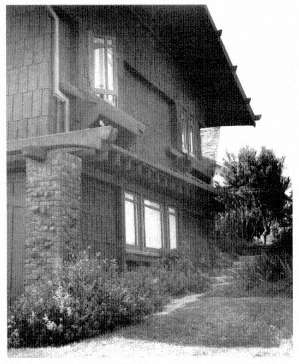
Figure 50
Albert Walker and John Vawter, architects,
Frank C. Hill Bungalow, Los Angeles, 1911.
By about 1915 direct reference to the architecture of Mexico and of Spain had replaced the mission image. In the 1920s the whole of Southern California seemed about to be transformed into a new, much improved, Mediterranean world. The interest of both the public and the architectural community in the Mediterranean/Hispanic image continued into the 1930s with the Monterey revival and on into the present with the California ranch house. From moment to moment, certain exotic elements were incorporated into the Mediterranean/Hispanic revival, such as forms and details derived from the pueblo or Santa Fe style of the American Southwest, the pre-Columbian of Mexico and Central America, and the Islamic of southern Spain and North Africa.
The built-in complexity and even contradiction in the architectural manipulation of image and place are apparent in the history of the bungalow in Southern California (Fig. 50). While some elements of the bungalow had tenuous precedents in the traditional architecture of the state (the nineteenth-century Anglo board-and-batten ranch houses and the earlier patio-oriented Hispanic adobe dwellings), their prime source was the East Coast shingle houses, to which were added occasional references to traditional Japanese architecture.
In the quasi-desert of Southern California these wood frame houses made no sense. The lumber to build them came from Northern California or Oregon, and only their
wide overhanging roofs (and the planting of non-native vegetation) protected their exposed wood members in the dry, hot climate. Yet once introduced, these one- and two-story bungalows quickly seemed to imply that they were native to the place. With remarkable rapidity, the California bungalow became not only a national but also an international fashion.
In writing and talking about the bungalow and other images associated with California, architects and promoters argued that each of these Southern California styles developed, not because of aesthetic decisions, but because of purely logical, rational, and "mathematical" considerations. They pointed out, for instance, the logic of using cement stucco or concrete, claiming that these new materials both mirrored the past and spoke to the present needs of the region. They also referred to the informal life of the Southland, noting that this affected the arrangement of spaces and led to a breakdown in the distinction between indoor and outdoor spaces.
One of the best ways to see how Southern California played the game of the mathematical and nonmathematical would be to analyze the results of concrete construction, introduced in the first four decades of this century. What was the relation between the measurable, logical, and mathematical elements of this new structural material and their expression?
There are two ways to approach this question. The first is to look at the factual expression of materials, structure, and mechanical systems—to read how a building is put together; what its features and components are; and what plumbing, heating, and cooling systems are used. We can note how the building is to be used and how it responds to these utilitarian requirements. The second approach is to examine how the forms, surfaces, and details of a building symbolize what is measurable and utilitarian about it. For example, the thin structure of two-by-four-inch wood stud construction would be apparent to a viewer in the building's detailing.
Architectural history illustrates that a readable representation of the mathematical, factual, or symbolic is almost impossible. This has proved the case in most buildings constructed in this century, for although some materials and structures can be made apparent—say, the structural grid of a steel frame building—others cannot. The modernists were never able to solve the difficult problem of declaring a building's function. Thus designs for a public meeting hall, a commercial structure, or a multifamily unit seem always to turn out looking the same (architects have admitted their failure to articulate function by frequent recourse to signage).
The mission revival style and the bungalow, the first two self-conscious regional developments in California, illustrate the near-hopeless entanglement of fact and image. To be successful, a building in the mission style should convey the feel of masonry architecture (of adobe or rough fieldstone held together by lime mortar). While a few adobe structures have been built in California in the twentieth century, most mission revival buildings were not adobe. Instead, the revival had recourse to modern technology: a wood stud frame, hollow terra-cotta tile, or concrete was covered over with stucco, symbolically suggesting a relationship to the historical forms.
Symbolism—of materials, structure, and the arrangement of exposed building de-tails—was a paramount theme of the California bungalow. Bungalow designs, ranging from the high-art versions of Charles and Henry Greene to the modest speculative dwellings of builders and development companies along many streets, delighted in playing the game of architectural symbolism. Exposed heavy timber members were often used throughout the building, as posts to hold up the roofs of porches or as projecting rafters to support the broad cantilevered roofs. In one way or another this use of exposed timbers was structurally fake. There was no need for timber posts of the size that was used. Nor did exposed rafter ends generally reflect the actual roof rafters, for they were normally attached as outriggers (the real rafters were modest timbers, 2 × 6 or 2 × 8 inches).
Inside these bungalows a proliferation of exposed wood members hints that we are seeing structure, but in most instances we are not; the wood is applied to the surface, hiding the actual structural members. Openly presented dovetail and pegged joints exist more often than not as symbol, not as fact. All this material and structural symbolism was effective in establishing the character of the bungalow. It was a problem only when morality in architecture became an issue, as when the Arts and Crafts movement pretended to argue for the "honest" expression of materials and structure.
In Southern California the give-and-take relationship between the mathematical and nonmathematical elements of architecture can be pointedly illustrated in the designs of Irving J. Gill. Over the years Gill has been presented as an early pioneering exponent of modernism, an architect in love with the technology of concrete.[3] His work has often been compared to that of the Viennese early modernist Adolf Loos. Indeed, in their common striving for a demanding puritanical simplicity, they have a strong kinship.[4]
Gill's experience with technology (the mathematical) demonstrates that his primary concern, like that of most exponents of the Arts and Crafts movement, was the symbolism of technology more than the fact. Gill's fascination with the new technology was essentially romantic. As Esther McCoy noted in her 1960 classic volume Five California Architects , Gill "was to bring concrete to the architectural importance of stone."[5] As an architect he coupled his focus on aesthetics with a desire that his building reflect what he conceived as the character of the region, in his case Southern California—both its environment and its history and myth.[6]
One new material that intrigued architects from 1900 on was concrete, especially its possibilities for use in domestic architecture.[7] Concrete, it was felt, would replace wood and both brick and stone masonry. Its potential was endless. It could be used for gravestones, for birdhouses, for ornamental dog kennels, as well as for concrete ships and large apartment buildings.[8] Francis S. Onderdonk, the engineer and advocate of reinforced concrete, wrote in 1928 that
the picturesque term "Liquid Stone" may have for many of us a shockingly unreasonable sound. Nevertheless it does express a combination of qualities that is to be found in cast
concrete. . . . When we add to this stone like result the reinforcing ribs of steel to carry our tensile stresses, we have indeed a material and method which may easily create a revolution in the architectural world.[9]
The potential of the new material was explored nationwide from 1900 through the 1920s. Thomas Edison spent a number of years trying to produce an inexpensive monolithic concrete house.[10] Concrete was employed by both traditionalist designers and the avant-garde. Frank Lloyd Wright experimented with concrete in several of his early-twentieth-century Prairie houses and in such monuments as the Larkin Building in Buffalo, New York (1904), and the Unity Temple in Oak Park, Illinois (1906).[11] Wright's fascination with concrete led him in the teens and twenties to develop textured concrete block, which he used in such buildings as the Midway Gardens in Chicago (1913) and the German Warehouse at Richland Center, Wisconsin (1915), and then in a series of concrete and concrete-block houses in the Los Angeles area, built from 1917 to 1924.
A number of buildings by traditionalist architects were technologically even more innovative than Wright's. The Beaux-Arts-trained New York architect Grosvenor Atterbury developed a complex method of manufacturing large-scale precast concrete panels for many of his buildings at Forest Hills Garden on Long Island from 1909 to 1913.[12] Cass Gilbert, the designer of New York's Gothic Woolworth Building, employed monolithic reinforced concrete to create a dramatic cubist play of forms and surfaces in the group of buildings he designed in 1918 for the U.S. Army Supply Base in Brooklyn, New York (Fig. 51).[13]
Concrete, and especially reinforced concrete, had been used for buildings and structures on the West Coast since the 1880s. Its early use in Northern California by Ernest L. Ransome has long been known and recognized.[14] Less well known was its introduction to Southern California, where from the late 1870s on it was employed for buildings ranging from powerhouses to meeting halls.[15]
Trade and technical journals published on the West Coast after 1900 contain numerous articles and advertisements advocating concrete construction. According to the architect Harris C. Allen, before 1930 concrete had emerged as a logical mode of construction exceptionally well fitted to "a style which now fairly [can] be called 'Californian,' [a style] based upon the traditional and appropriate Spanish-Colonial architecture of early California and Mexico, and finding much of congenial inspiration on the Mediterranean shores of Italy, France and Spain."[16] Concrete walls, covered with stucco or left exposed, were seen as a twentieth-century continuation of the traditional California architecture of the missions and adobe houses (Fig. 52).
Companies such as the Pacific Concrete Machinery Company produced the "Hercules" machine to mold block while the Concrete House Building Company constructed entire poured-in-place buildings.[17] These monolithic buildings were al-
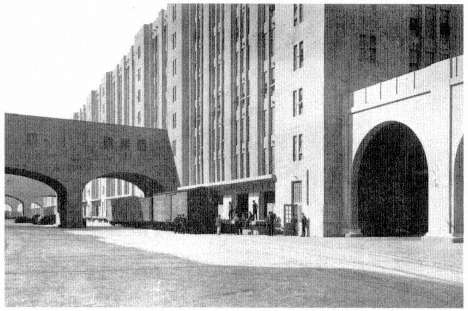
Figure 51
Cass Gilbert, architect, U.S. Army Supply Base, Brooklyn, 1918.
Photograph from Architectural Forum , January 1921.
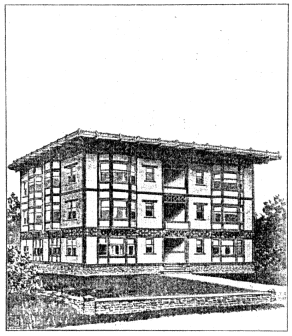
Figure 52
Henry L. Wilson, architect, "Design for a
Concrete Apartment House," Los Angeles, 1910.
Photograph from Concrete , April 1910.
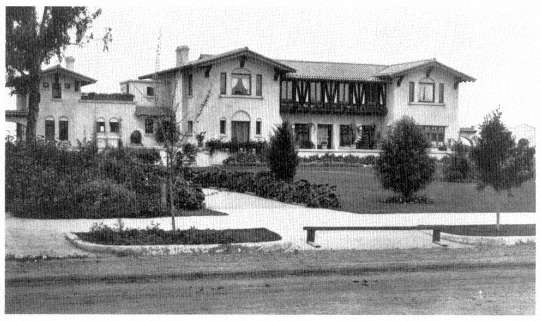
Figure 53
Opposite: Charles E Whittlesey, architect, Barttlett
(Mrs. J. W. Walker) House, Los Angeles, 1906. Photograph
from Western Architect , November 1912.
ways far more expensive than structures of wood, hollow tile, or steel. In Southern California, its early use was restricted to commercial and industrial buildings and a few single-family houses for the upper-middle class and the wealthy. The architect Charles E Whittlesey avidly promoted concrete construction (Fig. 53), using it in many of his hotels, railroad stations, and large houses in Los Angeles.[18] Other famous architects of the L.A. scene, Myron Hunt, Elmer Grey, and Arthur B. Benton, also designed concrete residences prior to 1910.[19]
One reason for the high cost of reinforced concrete construction was the need to erect wood or metal forms and then dismantle them after the concrete had been poured. Inventors, engineers, contractors, and architects proposed a wide array of solutions to this problem. Precast concrete blocks, of a size workers could handle, were one solution. Another, used by the engineer E. Duryee for his own 1909 house in Los Angeles, was the movable slip form. "Enough [forms] were used to build one foot of wall around the entire building and they were raised one foot daily after the first pouring."[20] In his J. Wesley Roberts House on Berkeley Square, Los Angeles (1910; Fig. 54), the architect B. Cooper Corbett used prebuilt reinforced concrete panels for his forms. It was noted that "these will not be removed but will become part of the permanent structure furnishing the finished surfaces."[21]
Still another method of erecting concrete walls was the lift-slab technique. A patent for one of its most widely known versions was issued in 1908 to Robert H. Aiken of
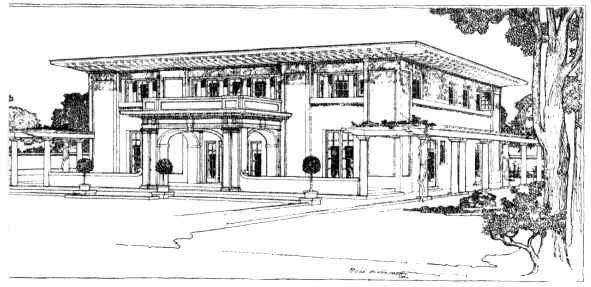
Figure 54
Above. B. Cooper Corbett, architect, J. Wesley Roberts House, Los Angeles, 1910.
Photograph from Southwest Contractor and Manufacturer 4 (January 1, 1910).
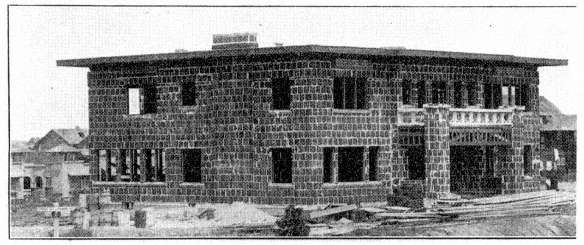
Figure 55
H. M. Patterson, architect, W. R. McIlwain House, Los Angeles, 1909.
Photograph from Southwest Contractor and Manufacturer 4 (November 13, 1909).
Winthrop, Illinois.[22] Thomas Fellows developed a variation on the Aiken system in Los Angeles in 1910 and used it to construct a low-cost demonstration house.[23] Fellows had the modular wall units cast horizontally on the ground; afterward, they were lifted into place by a mechanical crane. The interior side of each slab contained a row of eyebolts, through which a steel rod was inserted connecting each of the slab units. The narrow vertical space containing the eyebolts and steel rod was then grouted in.
On the West Coast, especially in and around Los Angeles, architects and engineers involved in concrete construction were eager to develop an economically viable system of hollow-wall construction. It would help to solve moisture problems, as well as those of heat loss and gain. By the early 1920s a myriad of solutions had been proposed (Fig. 55), ranging from the early Pelton Concrete Tile wall to the elaborate Hillman system, which was marketed by the Monolithic Hollow Concrete Form Corporation.[24]
"Concrete is not merely a product of raw materials," the structural engineer Homer M. Hadley wrote in 1931; "it incorporates the contractor's workmanship, the engineer's ideas of proportion and manufacture; the architect's conception of final shapes and forms."[25] Though Irving J. Gill's buildings were often cited as innovative technological (mathematical) applications of reinforced concrete, his real concern, as he himself made apparent, was the aesthetic realm "of final shapes and forms," coupled
with the stern morality associated with the Arts and Crafts movement and an intense interest in developing a new twentieth-century regionalism out of California's past.
Gill's use of concrete in fact had much more to do with appearance than with the latest technology. In a 1914 article on Gill's architecture, the writer Bertha H. Smith noted that Gill "had chosen concrete as his medium of expression. . .. To an incorrigible modern, the choice of concrete is a natural one."[26]
In a Gill building, it is almost impossible to discern the actual structure. Like many other architects throughout the country (especially in California), Gill used hollow terra-cotta tile blocks, sheathed in thick cement stucco, for many of his designs through the 1920s.[27] In some instances, such as the 1907 Laughton House in Los Angeles, the walls were entirely of hollow terra-cotta tile blocks, reinforced horizontally and vertically at key points by steel and concrete. After 1910 Gill often laid out a concrete frame and in-filled it with hollow tile. Finally, for several of his more expensive dwellings, like the well-known Dodge House in Hollywood (1916) and the Clark House at Santa Fe Springs (1919-22), he employed solid reinforced concrete walls and concrete floors and roofs.
Since all these walls were sheathed in stucco outside and plastered inside, a viewer cannot discern the actual structure, which looks like solid concrete. Similarly, the floor in his structures is always colored concrete. But in some cases it consists of a thin layer of concrete (held together with a wire mesh) poured over a wood floor; in others, it is a reinforced concrete slab.
The myth of Gill as an avant-garde technological innovator was perpetuated by many who wrote about his work in the teens and by Esther McCoy and others in the late 1950s and early 1960s.[28] McCoy pointed to Gill's early use of the Aiken lift-slab technology in the Banning House in Los Angeles in 1912 and in the large La Jolla Women's Club building of 1913.[29] In 1912 Gill purchased the patent rights of the bankrupt Aiken Reinforced Concrete Company and formed his own Concrete Building and Investment Company. But the Aiken lift-slab system turned out not to be very useful in concrete construction, and Gill did not employ it much after 1913.[30] It was technically difficult to carry out (Fig. 56), and its cost exceeded that of even normally expensive concrete construction.
Though Gill's structures had the look of modernist technology, his real interest was a purist's approach to design. In 1913 the editors of the Independent magazine caught the essence of his thinking in an article entitled "Concrete Curves and Cubes," describing him as "a Western architect who had deliberately limited himself to the cube, the hemisphere, the rectangle and the segment of a circle."[31] An article on his 1910 Lewis Court in Sierra Madre described his work in similar terms: "Although the houses are little more than cubes, they are set in such a way that they do not offend the eye, and their square towers cut into the blue sky of California with picturesque severity."[32]
No matter how often Gill and his supporters wrote and talked about technology (the mathematical) and about the virtue of pure forms, for viewers these buildings
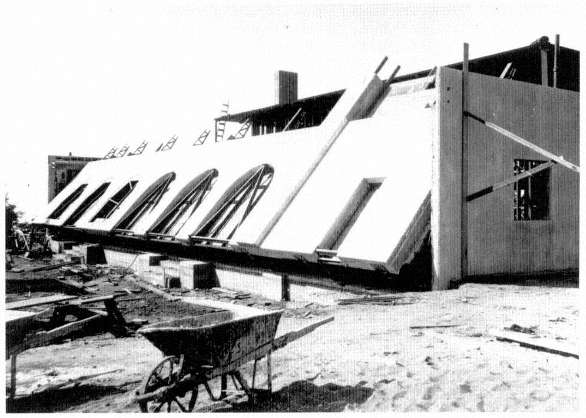
Figure 56
Above: Irving J. Gill, architect, Aiken system of concrete construction, Scripps Recreation
Center, La Jolla, California, 1914-15. Photograph courtesy Architectural Drawing Collection,
University of California at Santa Barbara.
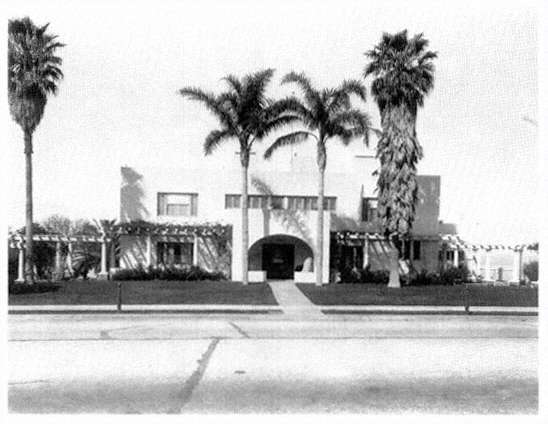
Figure 57
Opposite: Irving J. Gill, architect, Ellen B. Scripps House, La Jolla, California, 1914-15.
Photograph courtesy Architectural Drawing Collection, University of California at Santa Barbara.
carried references to the past and to the region. In relation to site and in the romantic contrast between rich foliage and white stucco walls, Gill's work fit in easily among the varied revivals of the time: mission, Spanish, and Mediterranean (Fig. 57). The English artist Maxwell Armfield, who encountered Gill's architecture in La Jolla, California, wrote, "He has ingeniously used his materials to include in its design shapes that recall the Spanish adobe building of the district without in any way copying their distinct method."[33] Gill was quite self-conscious about his relationship to California's past. In a 1916 article he noted that
California is influenced, and rightly so, by the Spanish Missions. . . . The Missions are a part of its history and they should be preserved. . . . The facade of the San Diego Mission is a wonderful thing, something that deserves to be a revered model, something to which local building might safely and advantageously have been keyed [Fig. 58].[34]
While Gill's "gospel of the beauty of use, and the use of perfect simplicity" set him off from many other California architects of these years, still he shared with them more
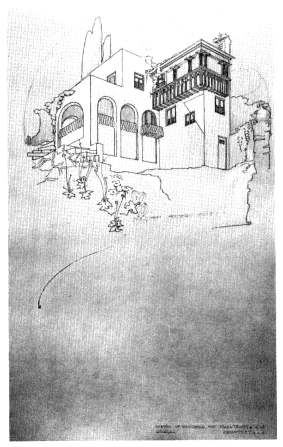
Figure 58
Irving J. Gill, architect, Lee and Teats House, San
Diego, 1912. Photograph courtesy Architectural Drawing
Collection University of California at Santa Barbara.
points of common interest than of dissimilarity.[35] His hide-and-seek game with reinforced concrete structure; his interest in pure form, "the source of all architectural strength"; and his references to the past have also characterized the work of almost all the architects who practiced in the Southland from the late nineteenth century to the present.[36]
The gamesmanship of expressing or hiding the nature of a structure and its material s was also an essential ingredient of the avant-garde California designs of Frank Lloyd Wright, Bernard Maybeck, R. M. Schindler, and Richard J. Neutra. Wright, in his textured concrete block houses of the early twenties in Southern California, let his viewer know that the walls were of modular block, but he carefully concealed the structure of double walls tied together with metal, and he provided no clue whatsoever to the structure for his floor and roof planes. Maybeck's work—his Anthony House in
Los Angeles (1927), for example—sometimes made the use of concrete structural forms apparent, but usually did not. As avowed modernists, Schindler and Neutra cultivated the illusion that structure in their buildings exemplified the latest technology, but in truth this was only partially the case.
The hide, show, and tell character of structure in California's architecture continues in the present work of postmodernists and deconstructionists. Whereas Gill and other earlier California architects provided strong clues to the structural form of a building, for postmodernist architects like Frank O. Gehry, the Morphosis group, Eric Moss, and others, structure (and materials) are delightful playthings and nothing more. Here and there the postmodernists vary the structure they employ, but always for aesthetic reasons, not to reflect or even hint at how a building has been put together.
Again addressing the nonmathematical nature of architecture, Leicester Holland wrote that
one may reasonably aim at expression of construction rather than exposure of construction, for certainly all objects in nature express their construction, though it is rarely literally exposed. . . . A quiet chat with an anatomical convive, lolling, as it were, in his viscera, would be very difficult for me.[37]
And so it was with the use of reinforced concrete in Southern California architecture. Its use in a building might indeed be revealed, but the final design of the structure ("the whole is sometimes much greater than the sum of all the parts") has always had more to do with a concern for form and historical reference than with the mathematical and technological ideals of modernist functionalism.[38]
Early Modernism in Southern California:
Provincialism or Eccentricity?
Bram Dijkstra
An encounter between Lorser Feitelson and Edward Hopper in the mid-fifties pointedly illuminates the price an artist must pay for not living in New York City. "Jesus," said Hopper, startled at seeing Feitelson, "I thought you had died somewhere way out in California a long time ago!" "I did," replied Feitelson, "but I wanted to be buried in New York, so they shipped me back here."[1]
To the East Coast art establishment the West remains, even today, a frontier of oddness and incoherence, a world of holy rollers and sand castle artisans whose works, like dreadful revenants, appear from time to time in New York galleries to help convince the world of the inherent sanity of Manhattan, Inc.
The juju of place has ruled the American art world throughout the twentieth century. An uncritical admiration for everything Parisian made critics genuflect until 1950, and since then an equally odd critical conviction that merely being in New York confers talent, grace, and sophistication upon an artist has guided most of our arbiters of taste.
Moreover, by 1920 the stylish had come to regard the urge to paint nature as an impulse of endearing, almost folksy, eccentricity. After all, the European leaders of modernism had roundly proclaimed the primacy of art over nature. The California impressionists, who were, in fact, doing their best work around this time, seemed therefore to many East Coast observers to be largely out of touch with current reality. But if the cliff dwellers of New York had come to regard a concern with the beauty and the dangers of the natural world as quaint and out-of-date, West Coast artists, whether they lived in isolated deserts, or in the coastal hills, or even in the ever more densely populated canyons of Los Angeles and San Diego, still had to cope with nature on a daily basis.
In 1920 conventional forms of landscape "composition," the human intellect's traditional method of taming the wilderness, unquestionably still reigned supreme in Southern California. According to Arthur Millier, the area's leading art critic of the
twenties and thirties, seventy percent of these landscapes were bought by tourists as souvenirs.[2] But although the art market in California continued to be dominated by an imagery that celebrated the particularities of the western landscape in a largely orthodox fashion, the artists who supplied this market were not necessarily more provincial than their colleagues on the East Coast. Most, indeed, had come from the East Coast and the Midwest and were, by 1920, at the top of their profession. Often they had left behind them substantial reputations in their move to California.
The term "provincialism" suggests a narrow, formulaic approach to artistic expression—a dislike for those who diverge from the norm. Artists who choose to go their own way on the basis of a conscious choice among options are not provincial but eccentric. Critics, usually a rather conformist lot, are often unable to recognize the merits of work that diverges from the prevailing cultural norms. By insisting on a narrow interpretation of whatever happens to be the reigning conception of normalcy in art, such critics often prove to be the true provincials.
I stress this rather obvious point because the word "provincial" crops up constantly in discussions of the art produced in Southern California prior to 1950. The members of the eastern art establishment were by no means the only culprits in this pattern of dismissal. The younger California artists of the twenties and thirties complained just as bitterly about the "provincialism" of their older colleagues and about the lack of taste of the Southern California public in general. The generation of 1950 did the same.
In reality, however, the range of styles pursued by the artists of Southern California from at least 1915, the time of the Panama-Pacific International Exposition, to the present was no more provincial than anywhere else in the United States. Still, there was a significant difference in attitude between the painters who settled in Southern California in the period before the Second World War and those who might be seen as representative of the East Coast establishment. What distinguished them from the typical New York artists of this period was their fierce desire for personal independence and their disdain for the competitive infighting that had already become characteristic of the East Coast art environment.
It was as true during the twenties as it is today that artists who yearned for national fame must make their careers—or at least exhibit regularly—in New York. However, if you were a loner, if you saw the wide-open spaces of the West as the raw materials of the imagination rather than as a depressing range of empty bleachers in the vast stadium of potential fame—you might move to Southern California and settle in some (then still) outlandish place such as San Diego, Cathedral City, or Santa Monica. In such regions of true cultural isolation, a host of nonconformist artists settled during the first few decades of this century, determined to do their own thing—all the while, of course, muttering self-servingly about the miserable provincialism of the general public.
Lorser Feitelson, for instance, had this to say about the Southern California environment of the late twenties and early thirties:
For the few artists that were serious, when they came out here, they had no audience, no patronage, and if they liked it out here, they'd better paint for their own satisfaction! So they did their best work, because there was no competition. They didn't walk along Fifty-seventh Street or the equivalent, or rue Boetie in Paris or rue de Seine, to "see what is going on," or look in the art columns to see what is fashionable now, or who's getting the works, who's being lauded. It just didn't exist. You really had to love art. Therefore, you did the things for your own satisfaction, you worked on the same damn thing year in and year out until you got something to your satisfaction. And it ended there. This was the situation here. Therefore, we never had an art community like up in San Francisco.[3]
Hans Burkhardt, too, was well aware that, then as now, "you had to live in New York to get into the clique." Even though he knew that "you could be the greatest artist out here" and still be forgotten, he chose to settle in Los Angeles in 1937, finding in the relative isolation of his new environment an answer to the domestic and artistic confrontations of his New York years.[4]
For Edward Biberman the contradictory combination of personal isolation, wide-open spaces, and the developing cosmopolitanism of Los Angeles was an enticement rather than a detraction. "New York in the Thirties," he remarked, "was obviously a much more active area for the art experience than California." But Biberman was not looking for support groups: "By the time I decided to move to California, the very absence of what I had begun to feel as a kind of incestuous quality pervading the art scene in New York—the very absence of that in California became a plus factor." Biberman, in other words, was determined to escape the seemingly paradoxical pressure toward conformity always present among those who desire to be part of the "cutting edge" in art: "I was, very frankly, not interested in whether or not there were California painters whose work I admired. I was really much more interested in my feeling that this was for me a time of stocktaking, a period of gestation and the presence or absence of a large body of spectacular talents really didn't enter into my thinking.".[5]
Stanton Macdonald-Wright was driven by similar motives to settle in Southern California. In 1934 Arthur Millier was able to report that this early champion of synchromist abstraction had resettled in Santa Monica because "neither Europe nor the East Coast pleased him anymore. He hates New York.".[6] Macdonald-Wright, who moved restlessly between the poles of abstraction and realism, and who was as fascinated by traditional Asian forms of visual expression as by the Parisian avant-garde he had been a part of in the 1910s, had arrived in Los Angeles in 1919 thoroughly disgruntled by the New York establishment's unwillingness to be converted to the gospel of synchromism. Tired of "chasing art up the back alleys of New York," he "departed for the nut state," his good friend Thomas Hart Benton remarked in his 1937 memoir, An Artist in America , voicing the cultural establishment's prevailing opinion of California..[7]
Among the host of artists who settled in Southern California during the twenties and thirties, there were quite a few who did so because they found isolation congenial. These were artists who looked to their art, not to the art world, for support. Independent souls, they were clearly "eccentric." Born, bred, and trained in Europe, on the East Coast, or in the art schools of the Midwest, and usually keenly aware of what was being done by the most experimental painters of their time, they could hardly be accused of provincialism.
According to these loners there was even a significant difference between Southern California and San Francisco. Some were taken aback by the Bay Area's tendency to replicate a cultural scene they had deliberately chosen to escape. Lorser Feitelson, for instance, insisted that he had decided to live in Los Angeles rather than in the Bay Area because the close-knit art community in San Francisco reminded him of New York. He liked the fact that if you wanted to visit other artists in Southern California, "you had to take two or three days—one live[d] over here, another one very far in the opposite direction. Very few knew each other, or if they did, they never saw each other."[8] Though Feitelson overstated the diffusion of the actual art community of the region, his remarks indicate that many Southern California artists had clearly made a conscious choice to isolate themselves from their peers. Those who wanted to be part of a regional art community tended to gravitate toward the Bay Area.
The opposite was true for the determined "eccentrics." Even a San Francisco-born artist such as Helen Forbes early showed signs of restlessness within the framework of Bay Area art. Like most ambitious younger American modernist artists she had made a pilgrimage to Paris, where she had studied with André Lhôte. But unlike most she did not settle down easily in her native city afterward. Instead she often went in search of wild nature—painting in the Sierras, in Nevada, or in the mountains of Mexico. During the thirties, as a Works Progress Administration (WPA) artist, she returned time and again to Death Valley, painting its sensuous, anthropomorphic formations in a manner all her own (though stylistically related to the earth forms of Georgia O'Keeffe, as well as those of the Canadian Lawren Harris). Part of the time she would work, holed up alone in a ramshackle deserted inn, far from the art community of San Francisco, and part of the time she would spend in the Bay Area, an active member of the art community there and a co-founder of the San Francisco Society of Women Artists.
Dorr Bothwell, born in San Francisco in 1902 and brought to San Diego when she was nine, returned to the Bay Area to study art and subsequently followed a complex international trajectory quite similar to that of Helen Forbes, finally settling in Joshua Tree—but escaping to Mendocino for the summer. During the late thirties she painted remarkable, often haunting, enigmatic dreamscapes, and her abstract works on paper caught the attention of East Coast critics in the mid-forties.
Agnes Pelton was another of these notable eccentric itinerants. She was born in Germany of American parents, was trained in Europe, and exhibited at the Armory Show in 1913. She came to the Southland after another complex international travel
pattern. Arriving in California in 1931, she settled in Cathedral City, where the desert became the raw material for many of her eerie, surrealist, organic abstractions.
To settle in Southern California as an artist, then, you had to be, as Feitelson emphasized, quite sure you could live with your own art. It took self-confidence, independence, and an adventurous spirit to move here during the twenties and thirties, and the work of artists gifted with such characteristics was not likely to be dull and provincial. Our critics' preoccupation with New York-centric, and very narrowly defined, conceptions of American modernist art has left many of us with the mistaken impression that California's artists did not enter significantly into the realm of modernist experimentation until after the Second World War. But the artists themselves, by refusing to relinquish their independence of spirit, clearly also helped undermine their chances for wider recognition. A disinclination to self-promotion is as unprofitable in art as in business.
The year 1920 is an arbitrary but convenient dividing point between periods in American art. If the New York Armory Show of 1913 was a major influence on younger painters, so, for Californians, was the Panama-Pacific International Exposition of 1915. Though the art exhibited in San Francisco was considerably more conservative than that of the Armory Show, the fauvist pointillism of the Italian divisionists and the bravura brushwork of an international host of postimpressionist painters gave young California artists plenty to think about. But it took time for that influence to be digested.
By 1920 a new orientation toward visual expression, shaped by modernist concerns—though today not necessarily recognized as "modern art"—had become the norm among younger American painters. Influenced by the principles of abstraction, but rarely focusing on abstraction for its own sake, these painters continued to emphasize the expressive potentialities of content. The artists of Southern California appear to have been particularly receptive to this hybrid of styles.
In 1920 the modernist branch of the art world in New York was, in fact, all abuzz with discussions of the paintings of Rex Slinkard, a young Californian, son of a rancher in Newhall, who had died of influenza in New York City in 1918 at the age of thirty-one, while awaiting troop transport to Europe. Knoedler's was showing his work, and Marsden Hartley had already written a stirring memorial to the passing of this "ranchman, poet-painter, and man of the living world."
Slinkard, who had trained with Robert Henri, developed a lyrical, semiabstract form of symbolist painting in which he blended suggestions of music and dance into figural compositions. In Slinkard's paintings volume and outline alternately separated and blended to accentuate Wagnerian episodes of libidinal yearning. The highly original visual qualities of these works were effectively captured in Hartley's erotically charged description of Slinkard's method, written to accompany the Los Angeles Museum's 1919 memorial exhibition:
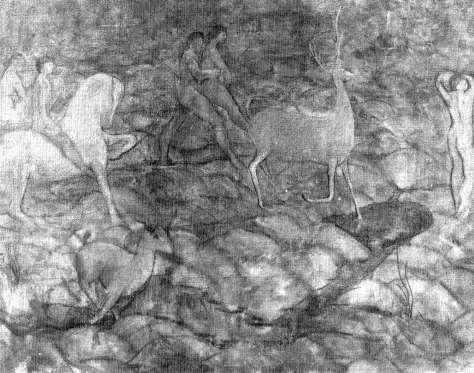
Figure 59
Rex Slinkard, Young Rivers (Riders) , ca. 1916. Oil on canvas, 38 × 51½ in.
Stanford University Museum of Art, Estate of Florence Williams.
He felt everything joined together, shape to shape, by the harmonic insistence in life and in nature. A flower held a face, and a face held a flowery substance for him. Bodies were young trees in bloom, and trees were lines of human loveliness. The body of the man, the body of the woman, beautiful male and female bodies, the ideal forms of everyone and everything he encountered, he understood and made his own. They were all living radiances against the dropped curtain of the world. He loved the light on flesh, and the shadows on strong arms, legs, and breasts. He avoided theory, either philosophic or esthetic. He had traveled through the ages of culture in his imagination, and was convinced that nothing was new and nothing was old [Fig. 59].[9]
Slinkard's sensuous perception of the material world sets the stage for an understanding of the visual preoccupations of most of Southern California's independent
modernists. The first exhibition of the Group of Independent Artists of Los Angeles, held in February 1923, included, as a tribute to Slinkard's influence, a number of his works, as well as paintings by Stanton Macdonald-Wright, Nick Brigante, Charles Austin, Boris Deutsch, Peter Krasnow, Edouard Vysekal, and Morgan Russell, all of whom shared Slinkard's concern with the intermodulation of color, form, and content. Each made the visual field of the painting into a celebration of all the senses. Each resolved the technical problems involved in such a project in markedly different fashion, and with variable success, but the attempt, already noted by Marsden Hartley in Slinkard's work, to make the body and the landscape coextensive, and to make each into a sensuous reflection of the other, is common to all these painters.
This pursuit of the tactile-visual correspondences between the human body and its material environment is expressive of a predilection for topographical anthropomorphism quite common among the painters of California—a fascination that need not surprise us, given the state's natural beauty. But the postwar modernist critics, with their insistence on "pure art," on an art that was to be "nonobjective" and uncontaminated by recognizable forms, tended to denigrate such "materialistic" concerns.
The self-declared post-Armory Show modernists were by no means the only immigrants to California tinkering with the boundaries of the traditional modes of representation. The state's primal natural environment drew many whose work defied all forms of categorization. Foremost among these was Charles Reiffel, who settled in San Diego during the mid-twenties. Emphatically a loner and an original, he fits the characteristics of the early-twentieth-century Southern California art refugee perfectly. Only someone compelled by his art and unimpressed with public acclaim would abandon a major East Coast reputation at the age of sixty-four to live in the dry, and during the mid-twenties still thinly populated, canyons of San Diego.
In the ten or fifteen years before his arrival there, Reiffel had gained his East Coast reputation as a tempestuous and idiosyncratic, fiercely independent postimpressionist landscape painter, whose work had become a familiar presence at the Corcoran biennials, the National Academy exhibitions, and the yearly American painting shows of the Art Institute of Chicago. Conservative critics hated his work, but the more adventurous ones championed him and compared him favorably to such much younger figures as Ernest Lawson, George Bellows, or even Vaclav Vytlacil, a young Turk thirty years his junior, who was to become a major presence in the Abstract American Artists organization of the thirties. In the March 1922 issue of Vanity Fair , Peyton Boswell had appended an appreciation of Reiffel's "happy combination of talent," on exhibition at the Valentine Gallery, to his glowing review of an exhibition of recent Italian landscapes by André Derain at the Brummer Galleries in New York.[10]
Reiffel's work of this period inspired lively debate among exhibition goers, and he was cast as the American van Gogh—whose work was indeed one of Reiffel's major inspirations. Traces of it can still be found in such major works of his San Diego period as his Morning, Nogales, Arizona of 1928. This work typifies Reiffel's method. In it, the
landscape comes alive with elemental power. Vermicelli-like strands of paint rush and splash thinly but insistently over the canvas, creating uncanny suggestions of sentient tensions, not only in plants and trees, but even in the inanimate forms of buildings, mountains, rocks, and soil. No doubt, Edgar Allan Poe would have loved Reiffel's work.
True to the fate of the loner painter seeking the lure of nature and a personal vision in Southern California, Reiffel's status as a national figure in the world of art declined the moment he moved to San Diego, although he continued to paint many brilliant canvases there, making the southwestern landscape lope and surge with suggestions of elemental movement and an ominous, almost preternatural, tension. The wealthy middle-class citizens of San Diego who would have been the potential buyers of his work did not understand the meaning of these strange masses of paint turned into undulating waves of primal matter, and during the depression years Reiffel, notwithstanding the welter of official awards and prizes which had been—and continued to be—bestowed upon him, descended into a state of abject poverty.
In his late years, rescued from starvation only by the existence of the WPA's various art support programs, he painted numerous rolling "bodyscapes" of the hills around San Diego, and such moody masterpieces as Rainy Evening (1937; Fig. 60) in which dense rain and lingering clouds transform the usually-too-hot concrete, brick, and asphalt of a parched city into the shimmering membrane of a restless organism bent on overpowering whatever might be merely human. Such paintings were commentaries on Reiffel's own tempestuous yearning. They are documents of his stoic yet unquiet sense of his own isolation from the rest of civilization. His restricted palette, dominated by blues and greens and yellows, combined with his fascination for long, seemingly uncontrollably trailing tendrils of organic form, has often caused his work to be naively misread as itself uncontrolled or "unsophisticated," even though the artist intentionally used paint and texture in a fashion directly in anticipation of the postwar concerns of the abstract expressionists. He apparently experimented (much as Knud Merrild did in Los Angeles a few years later) with a form of "drip-trail" abstraction well before Jackson Pollock. These abstractions were included in the 1942 Reiffel memorial exhibition at the San Diego Fine Arts Gallery but have not resurfaced since.
The narrow redefinition of what was "modern," and what not, that took hold in this country after World War II has, until recently, precluded serious reexamination of Reiffel's work, as well as that of many other stylistically eccentric American painters of the period between the wars. The postwar modernist aesthetic thus succeeded in trivializing the achievements of many strikingly independent and experimental artists whose work happened to be conceptually and stylistically incorrect within the context of the new criteria.
The experimental mood of the artists of the early twentieth century had, in contrast (as can easily be verified by the very wide spectrum of styles exhibited at the Armory Show), expressed itself through a broad-based, and stylistically variegated, set of skirmishes against the technical conventions of academic realism and its insistence
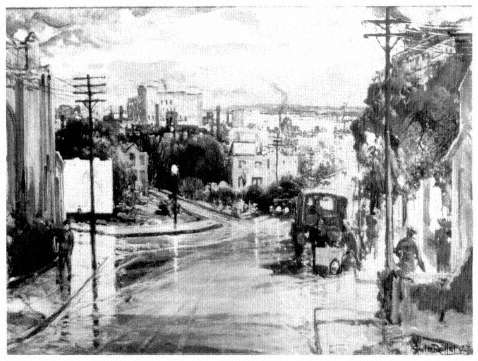
Figure 60
Charles Reiffel, Rainy Evening , 1937. Oil on board, 36 × 48 in.
Charles and Estelle Milch collection, San Diego.
on "pedagogic content"—on the facile depiction of "philosophic" subject matter expressive of middle-class values. Among these early modernists, the exploration of raw emotion in its most essential forms, through the innovative use of paint, color, and content (through figural expressionism, in other words, instead of abstraction for its own sake), was as frequently considered an integral part of the revolt against tradition as the notion that art should exist merely "as art." However, the move away from traditional forms of representation very early brought with it also the beginnings of the exclusivist mentality that was to come to full prominence after the Second World War. The remarkable early flowering of the Stieglitz group in the American cultural consciousness, and its continuing (and almost certainly still exaggerated) position of absolute prominence in our histories of American modernism, is a dramatic case in point.
But loners traditionally have been more important in the flowering of American art than movements and cliques. The early American modernists are very much a part of that tradition. It is therefore by no means surprising that some of the best among them
recoiled from the incipient dogmatism of the New York art world of the years between the wars.
As Feitelson, Biberman, and others have emphasized eloquently, these motives brought an unusual number of self-defined loners to the as yet culturally undefined reaches of Southern California during the earlier decades of this century. Some painters whose work is not in tune with the prevailing fashions are lucky enough to be able to survive in the more competitive art centers. Their work may subsequently, as the fashion changes, catch the attention of critics or dealers who have the power and the will to bring them to national prominence. Other artists have learned to promote their own work vociferously to gain the interest of those who are able to lead them to fame. Some artists are able to tolerate the conditions of the art marketplace; others cannot. Whether they are able or unable to do so has in itself nothing to do with the inherent quality of their work—but clearly artists who stay in the art centers, or who have been lucky enough to find a Stieglitz or a Clement Greenberg to promote them, have a much better chance of ending up in the histories of American art than those who, like Reiffel, are driven by personal demons and an all-pervasive preoccupation with the demands of their art. In consequence women and men who choose to pursue their work in outlandish isolation (such as that represented by Southern California's prewar art environment), almost inevitably end up being ignored by art history. The critics, unable to categorize their work, extrapolate from that a lack of direction or sophistication, and reward them consequently with casual dismissal.
During the twenties and thirties there were several other painters in California who, like Reiffel, were loosely associated with impressionism but whose work actually blended divisionistic techniques, fauvist color, and a modernist concern for essential form. Among these perhaps the most influential was Clarence Hinkle, who, having been appointed in 1921 as one of the first instructors of painting of the just-opened Chouinard School of Art in Los Angeles, became a mentor to such major California regionalists as Millard Sheets, Phil Paradise, and Phil Dike.
Though Hinkle was uneven, his best paintings tended toward an integration of broad, rhythmic patterns of line and bright fields of color. Often, at least in the manipulation of paint, they proved to be a good deal more adventurous than those of his students. His Laguna Beach (1929) gains authority from a superbly integrated architecture of color and ground, and a contagious delight in the calligraphic potentialities of line.
Another painter whose links with the California impressionists are at best rather tenuous is Thomas Lorraine Hunt, who was born in Ontario, Canada. Hunt painted complex ideograms of mood, which turned what would have remained ordinary land scape scenes in the eyes of lesser talents into visual messages about the links between the natural environment and our states of mind. Hunt was able to turn the scratch dab, and dash of the brush into a language of elemental equivalences between nature and the emotions. In a painting such as Fog in the Harbor , the heavy, dark tones of
boats and their shadows become the matrix upon which bright strokes of paint flash abstract points of color to countermand the pall of stasis established by the weight of the fog. In his broadly painted Grape Arbor , horizontal bands of paint are cross-hatched with dark stakes and a spare grape-stalk vermicelli that overtakes the top quarter of the painting to undermine the potential artificiality of the horizontals with a chaos of organic dribbles, dashes, and gobs of paint. It is a remarkable example of Hunt's ability to turn essential form into a passionate dialectic between the values of color and ground. Works such as this, with their evident concern for the abstract interaction of color, movement, and mood, show Hunt to have been, like Reiffel, in search of painterly principles not unlike the visual language that was to be codified as abstract expressionism in the postwar years.
The 1920s were a period of consolidation and reconsideration in American art. The avant-garde's move, during the 1910s, into experiments with cubism and related forms, and the pure color abstraction of Stanton Macdonald-Wright's synchromism, had attracted the attention of most of the talented younger painters. These proceeded—not to imitate these styles to the letter—but rather to adapt them to their own purposes. Clearly the younger California painters were as knowledgeable about the varieties of early modernism as their East Coast counterparts. Elements of fauvism, postimpressionism, cubism, and futurism pervade their work. Sometimes their experiments were indeed clearly "cutting edge," as in the case of Ben Berlin's work of the early twenties, which forms an interesting analogue to the visual music of Kandinsky, and carried such dada-inspired titles as Vudu Futhmique and Owngz . The same is true of Boris Deutsch's ventures into the realm of organic abstraction in works such as Rock of Ages —shown, like Berlin's paintings, at the first exhibition of the Los Angeles Independents in 1923. Berlin's whimsical pencil-drawn Portrait of that year is an excellent example of these experiments (Fig. 61).
Newly rediscovered styles, about which the artists might first have read in such magazines as the International Studio, Arts , or Parnassus , also influenced the work of the American painters of the twenties and thirties. Thus, along with adaptations of the work of Cézanne, Gauguin, Picasso, and Braque, the younger Californians absorbed lessons from the work of Giotto, El Greco, and the Mannerists. The word "primitivism" lost its association with the notion of "technical inadequacy," imposed on it by the academic artists of the nineteenth century, and came to stand for expressive spontaneity. African and Asian art and the folk art of Western Europe and America were finally being taken seriously.
If we accept the term "modernism" as descriptive of an aesthetic of formal experimentation, and "postmodernism" as representative of the eclectic reinterpretation and synthesis of the results of such experimentation, in conjunction with the exploration of stylistic impulses taken from earlier styles of art, we can easily identify the period of the twenties as the first postmodernist era in American art.
The eclectic tonality of the art environment of the twenties was further enhanced
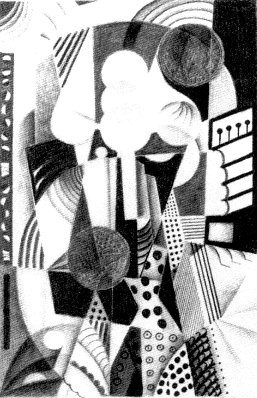
Figure 61
Ben Berlin, Portrait , 1923. Pencil with embossing,
7 11/16 × 5 in. Private collection. Photograph
courtesy Tobey C. Moss Gallery, Los Angeles.
by the activities of numerous immigrant artists. They brought with them the expressive traditions of Russia, Eastern Europe, Scandinavia, and Italy and added these to the welter of styles that characterized the American art of that decade. One of the most striking results of this eclectic mixture of styles is the linear expressionism of a group of New York and Chicago immigrant painters. It is a style that to a certain extent overlaps with the cooler, much less impassioned—and hence more purely "modern"—preci-sionism of Charles Sheeler, Charles Demuth, and Georgia O'Keeffe. But where the latter group was primarily concerned with the shapes and outlines of the city or the forms of nature, the work of the linear expressionists also focuses on the psychological dimensions of the human figure. Their work resembles precisionism in its pursuit of hard-edged, stylized delineations of natural and architectural forms.
This linear expressionism is strikingly characterized by the early work of Peter Krasnow, which insistently explores the interplay between flattened volumes and line.
Krasnow was born in the Ukraine and immigrated to the United States when he was seventeen. In Los Angeles, in 1925, three years after his arrival there, he painted a strikingly expressive portrait of an elderly man. The "kinetic properties" of the semicubist, semi—three-dimensional work of Albert Gleizes, with its emphasis on "shifting and moving volumes," that had much impressed Lorser Feitelson and numerous other young American painters at the Armory Show, would seem to have impressed Krasnow as well. In this expressionist portrait, for instance, fiat planes of color are bounded by hard-edged patterns of line and molded into casual simulacra of three-dimensionality by perfunctory shading. But Krasnow's line seems unwilling to maintain its integrity as a marker of separation between visual entities: a mountain abruptly becomes a chair, which turns into a blanket in support of an old man's body. The folds of the man's clothing have become a gauze that reveals the tuberous musculature of his ebbing flesh. There is a harsh, disconcerting element of cynicism and doubt in the face of this man. It leaves us with the impression that his sense of the meaning of being may be as disequilibrious as his pose and his semisunken, off-center position in the image.
The lower right corner of the painting is virtually a separate still life, emblematic of unquiet resignation, echoing in this respect the mood of existential doubt that courses through the entire painting. Had Krasnow continued to paint in this vein he would undoubtedly have become a central figure in the history of prewar Southern California art. Unfortunately, Krasnow's restless eclecticism led him to try his hand at so many different styles and modes of visual expression that he ultimately failed to gain a truly significant voice in any, except when, in his later years, he developed a densely patterned, kaleidoscopic style of abstraction—works that are brilliantly executed and as intricate and intriguing as oriental rugs, but with primarily a decorative, rather than an expressionistic, emotionally focused, intensity.
The precisionist tendency dominant in the American visual aesthetic of the twenties had actually arrived quite early in Los Angeles in the work of Henrietta Shore, who was born in Toronto, Canada, and was trained in New York and London. From 1915 until 1920 she lived in Los Angeles, but even after she moved to New York, she returned to California every summer, and in this manner she maintained a very active presence in the local art world until at least 1928, when she settled in Carmel. An effective, though still relatively conventional Los Angeles cityscape of around 1918 shows the manner in which the local contact between nature and the city may have suggested the "precisionist" linearity of industrial architecture to her. It was, in any case, a linearity she rapidly proceeded to incorporate into her work. A nude she painted the following year already strikingly combines line and volume in a linear expressionist fashion. The subtle molding of the background in this painting brings to mind the tonalities and shading of O'Keeffe's landscapes of the same period and helps to establish the sharply delineated sensuous weight of the figure in the foreground. Helena Dunlap is thought to be the subject of Shore's resplendently erotic scrutiny in this painting.
Shore was a close friend of Dunlap, another Los Angeles painter who was considered
a modernist by her contemporaries. Dunlap, a few years Shore's senior, tended toward postimpressionism in her work. Like so many other Americans of this period, she had studied with André Lhôte in Paris. Together with Shore she was given a two-person show at the Los Angeles Museum in 1918.
During the early 1920s, Shore continued to explore the expressive properties of simplified form in works that emphasized sharply delineated contrasts of color and line. Her Waterfall of 1922 is a remarkable example of her adventurous experiments of this period, which by 1927 had yielded to an equally adventurous hard-edged organic surrealism in such paintings as California Data , in which she surveys the sensuous qualities of the state's floral wealth.
The twenties and thirties produced an array of superb women painters whose work was often at least as rich and imaginative as that of their male counterparts, although one is hardly likely to discover this from a casual reading of the histories of American early modernist art, which seem to hold to the proposition that Georgia O'Keeffe was the only woman worth consideration in the field of painting during the period before 1945. Among these largely forgotten women painters, Belle (Goldschlager) Baranceanu figures prominently. Born in Chicago a few months after her parents' arrival there from Rumania, Baranceanu trained at the Minneapolis Art Institute and the Art Institute of Chicago. She came to live in Los Angeles in 1927 and 1928 and, after returning to Chicago, finally settled in San Diego in 1933.
Baranceanu was strongly influenced by the linear expressionism of Anthony Angarola, a leading Chicago modernist of the twenties whose student she had been. However, she soon developed a personal style emphasizing the juxtaposition of fiat fields of color and strongly accentuated, essential line. Her work was considerably less busy, less three-dimensional, and more concerned with color values than his. Baranceanu had an uncanny ability to reduce the forms and structures of the material world to their sensory essence. In early works, such as her Leaf-Bud of 1925, she brought her work close to abstraction. Leaf-Bud combines the close-up sensibility of O'Keeffe's flower studies of the same period with a forceful interest in the abstract compositional properties of color, plane, and line.
But Baranceanu's love for the essential shapes of nature made her turn away from complete abstraction and toward the creation of carefully organized compositions, which in controlled sequences of line mapped the volumes, hues, and textures of sensuous experience. Equally adept at landscape, figure painting, and still life, Baranceanu brought her determinedly modernist yet very personal sense of style to bear upon The Yellow Robe , a portrait of her sister painted in Los Angeles in 1927 and shown that same year at the Los Angeles Museum's annual American Painters and Sculptors exhibition (see Plate 7). In this composition, the regal figure of the sitter gains strength and authority from carefully balanced horizontal and vertical rectangles of complementary color, which with only minor further simplification could have led the painter to a Mondrianesque exploration of pure geometric abstraction.
The following year Baranceanu exhibited a view of Los Angeles from the hilltop house in which she lived at the time, close to downtown. From Everett Street is remarkably European in sensibility, although Baranceanu never visited Europe. There is a striking stylistic affinity between this work and some of the angular, stylized, flattened cityscapes Egon Schiele had been painting during the 1910s. Since there is no indication and little likelihood that Baranceanu was familiar with these works when she painted From Everett Street , the similarity is most likely due to a correspondence between the visual sensibilities of the two painters rather than to direct influence.
From Everett Street is part of a splendid series of paintings and lithographs of Los Angeles created by the young painter during her sojourn there in 1927 and 1928. These works vary from Cézannesque explorations of the landscape as a series of receding planes to brilliantly colored industrial images such as her study of a brick factory in Elysian Park, whose subject matter parallels Charles Sheeler's explorations of the geometry of the American workplace. Other works in this series, such as Sunset Boulevard at Everett Street , bring an angular poetry to the streets of the city, and in Hollywood Hills Baranceanu pits the tensions of nature against the encroachment of city life by making patterns of color and form interact in a manner reminiscent of the organic semiabstractions of Arthur Dove.
During the thirties, strongly influenced by Diego Rivera, Baranceanu became San Diego's foremost mural painter, a figure of diminutive physical stature who boldly designed and executed gigantic visual narratives virtually single-handedly. This left her little time for easel painting, and thus her later work in this medium is relatively rare. Since her mural work was of necessity site specific, her art was rarely seen beyond San Diego, but in that city she was without doubt the most influential modernist presence until after World War II.
Baranceanu's paintings of 1927 and 1928, focusing on Los Angeles's Everett Street region, prefigure the expressive concerns to be found in the justly celebrated Angel's Flight of 1931, by Millard Sheets. This painting is one of the quintessential American urban images of the depression decade. But Sheets's flirtation with linear expression-ism was regrettably brief, apparently not predating 1931 and giving way to a more decorous—and more decorative—form of stylized regionalism as early as 1933.
In Angel's Flight the extraordinary interplay of fiat urban surfaces and an almost infinitely receding "abstract" pattern of perspectival planes helps to give the figures in the foreground a remarkably sensuous three-dimensionality. Unfortunately, examples of this expressionist-realist phase of Sheets's art are rare. Sheets was too "civilized," too much a tourist in the natural world, one is tempted to add, to be able to sustain the expressive intensity of Angel's Flight . In certain of his later paintings, as in the stately, somber rhythms of Abandoned (1934), he was still able to recapture the remarkable balance between form and content he had achieved in Angel's Flight , but he soon aligned himself with the artificial, patronizing populism of regionalist painters such as Thomas Hart Benton and moved inexorably toward the often cloyingly decorative qualities of his work after 1945.
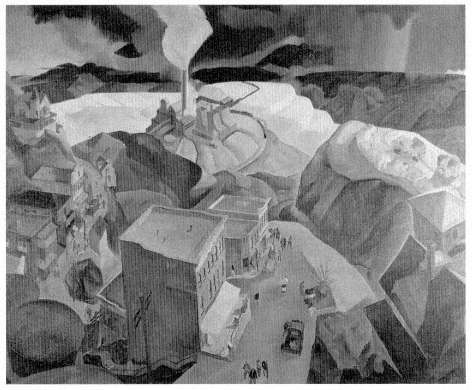
Figure 62
Phil Dike, Copper , 1937. Oil on canvas, 30 × 40 in. Phoenix Art Museum.
The linear expressionist quality lingered a bit longer in the work of some of Sheets's closest compatriots and followers at Chouinard. Paul Sample, Barse Miller, Phil Paradise, and especially Phil Dike (see Fig. 62) all did a great deal of work during the thirties that seems to have found its initial inspiration in the stylistic qualities of Angel's Flight .
Among the numerous artists who earned their living by working in the motion picture industry, some developed distinctive personal styles that often remained geared to the visual requirements of the movies even while attempting to break through the medium's oppressive demands for "realistic" imagery. The work of Warren Newcombe is particularly remarkable in this respect. He had studied painting in Boston under Joseph De Camp, and started out painting portraits in a style not unlike that of his teacher. By 1920 he was in Hollywood. His work moved through a phase in which he painted fuzzy symbolic landscapes similar to those of Claude Buck toward a Matisse-
inspired sense of line. By 1931 he had developed a strikingly individual, self-consciously antiacademic manner of painting landscapes, using flat planes of color and broad, heavy outlines to turn scenes seen from what would otherwise be a rather ordinary perspective, into wonderfully sinuous, semiabstracted dreamscapes. In these works echoes of the styles of Rockwell Kent, Marsden Hartley, Charles Reiffel, and even Vincent van Gogh bounce off against Newcombe's amusing sense of the organic world as the backdrop for a cosmic movie. Edward Weston described Newcombe's art perhaps most effectively: "He has emotion as well as intellect; he feels deeply the American scene. Into his canvases go exhilarating vitality, joy of life, intense drama. Essential forms rise starkly stripped, or swirl with energy. Color vibrates, is alive."[11]
Another figure who came to prominence in California during the depression years was Ejnar Hansen, who, after having lived in the Midwest since 1914, moved to Pasadena in 1925, where he painted startling character studies of tormented or eccentric men and world-weary young women on the edge of disintegration. These paintings, which capture much of the neurotic tension of modern life, are among the finest examples of twentieth-century portraiture. Hansen's extraordinary series of paintings documenting the physical decline of the important art critic Sadakichi Hartmann presents a chilling record of an intellect forced into gradual capitulation to the agonies of a decaying body.
Like many other early-twentieth-century American painters who had found their inspiration in modernism, Hansen almost completely abandoned the flattened, linear elements of expressionism in his work of the later thirties. Instead he began to explore a broadly painted yet quite accessible and "populist" imagery, very characteristic of the realist tendency in thirties art. This latter tendency was represented in California by a wide variety of poetic realists, including Emil Kosa, Jr., Edouard Vysekal, Sueo Serisawa, Everett Gee Jackson, and Dan Dickey.
Within the present context it is clearly impossible to give all the California artists who contributed to the adventurous modernist atmosphere of the interwar years the attention they deserve. I have deliberately moved away from discussing the work of major figures such as Feitelson, Macdonald-Wright, and others who have been invoked time and again by writers steeped in postwar critical values as proof that faint traces of "good" modernism could actually be discerned in Southern California even before 1950. The still relatively obscure artists I have chosen to feature here represent a selection that, though by no means arbitrary, could easily have been restructured to feature several other groups quite as deserving of our attention. A focus on Feitelson and his entourage might have been the subject of another approach. The Arensbergs, their Los Angeles circle, and the importance of their collection to the progressive artists of the region would have represented a more traditional focus.
In truth, the early modernist art of the area represents an embarrassment of riches. The work of Arthur Durston, who was a major formative influence on Morris Broderson, is always intriguing. His paintings of women stoically contemplating land-
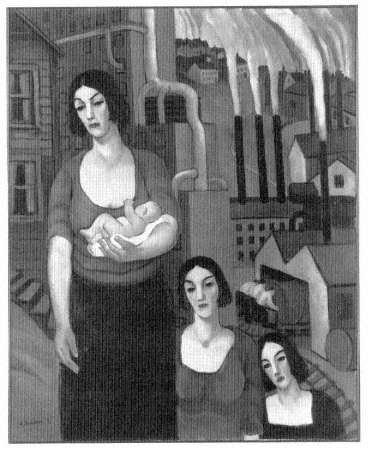
Figure 63
Arthur Durston, Industry , 1934. Oil on canvas, 50 × 40 in. National
Museum of American Art, Smithsonian Institution, transfer from
U.S. Department of Labor.
scapes ravaged by devastating floods and his Industry of 1934 (Fig. 63) give to average people the static, monumental dignity of the principals in a Sophoclean tragedy. Durstoh's paintings are exemplary of the manner in which some of the painters of the thirties were able to conjoin social commentary with modernist formal considerations.
Knud Merrild in his flux paintings of the forties, such as Flux Bouquet and Sidereal Parturition (Fig. 64), played on the viewer's tendency to turn abstract matter into "representation." The controlled accidents of paint-in-flux that formed the basis for his compositions take on a semblance of the essential forms of nature's flora and fauna in a reversal of the process Reiffel had used to turn his elemental earthscapes into near abstractions by exploiting the visual correspondences between our sense of what constitutes landscape and the organic suggestions always inherent in loosely controlled strands of paint.
Helen Lundeberg, in such paintings as Plant and Animal Analogies (see Plate 8), her dreamscapes of the mid-thirties through the forties, and her painting Microcosm and
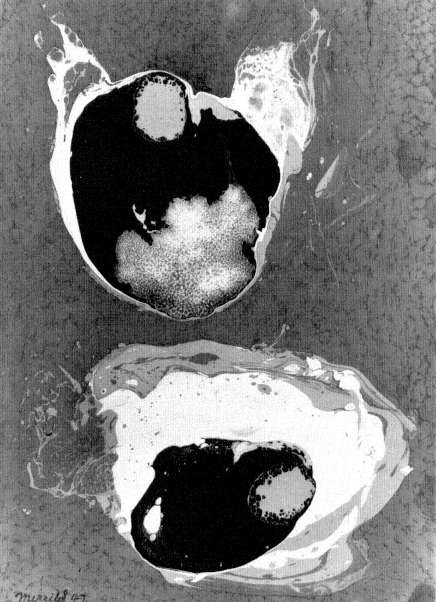
Figure 64
Knud Merrild, Sidereal Parturition , 1947. Oil flux on Masonite,
20¾ × 15¼ in. Photograph courtesy Tobey C. Moss Gallery, Los Angeles.
Macrocosm (see Fig. 13), produced some of the best images of myth and mystery art can hope to offer us, while the perfection of her Self-Portrait of 1933 is enough to startle any viewer with its ability to turn reality into a realm of magic.
Philip Goldstein had, well before he became Philip Guston, become expert at combining surreal and expressionist imagery. His documentation of fascist violence and its attendant human suffering in the extraordinary Bombardment of 1937-38 is a superb example of the visual complexity the California painters were capable of bringing to their work. In a similar fashion, Hans Burkhardt was able to portray the nightmarish dimensions of war in a manner that shocks, yet adds to, the viewer's humanity. Surreal, yet all too real, his paintings of the forties are among the world's most chilling evocations of the brutal carnage of the Second World War: the bloody screams of anger of a gentle soul (see Plate 5; Figs. 15, 16).
Much the same can be said of Boris Deutsch, who was able to capture the panic, anguish, and exasperation many felt when it became clear that the war had ended only to plunge the world into a new "cold war" of emotional terrorism. This is "What Atomic War Will Do to You," Deutsch told his viewers (Fig. 65).
Paintings such as these emphatically demonstrate the inaccuracy of the frequent assumption that before 1950 all West Coast art was "soft" and mired in sunlight fantasies of easy living. In fact, even painters such as Edward Biberman, who dealt with the everyday particularities of the social environment of Southern California, were often able to evoke complex emotional responses by combining realistic imagery with a modernist sensibility. Biberman was a visual poet, his work a West Coast analogue to that of Edward Hopper. At his best he turned Southern California's perpetual impulse toward an all-inclusive eclecticism—an abiding lust after visual stimuli—in upon itself.
Biberman, the Philadelphia-born son of Russian immigrants turned American industrialists, surely was the quintessential postmodernist, painting effectively in a style he had invented long before the conceptual framework for that style had even been conceived. He was able to evoke the various moods of Los Angeles in a sequence of paintings that expressed his anger at the region's casual wastefulness of human hopes and talents as well as his admiration for its recklessly inventive appropriation of architectural forms. In his paintings of the immediate postwar years Biberman captured the essence of urban Los Angeles perfectly. Here the squares of Josef Albers meet the empty city streets of Hopper and the hard-edged precisionism of Sheeler at, of all places, the Hollywood Palladium (see Plate 9). In paintings such as these Biberman effectively anticipated the productions of far better known postwar chroniclers of the "new" California, such as Edward Ruscha and David Hockney.
Our current myth about art in California posits a sudden flowering of artistic genius after 1945. But we would do well to remind ourselves that artists such as Yasuo Kuniyoshi, Philip Guston, and Jackson Pollock did not merely pass through California; they received part of their early impetus and art education here. Not all the perceived stars of American art were touched by genius only after they arrived in New York—in
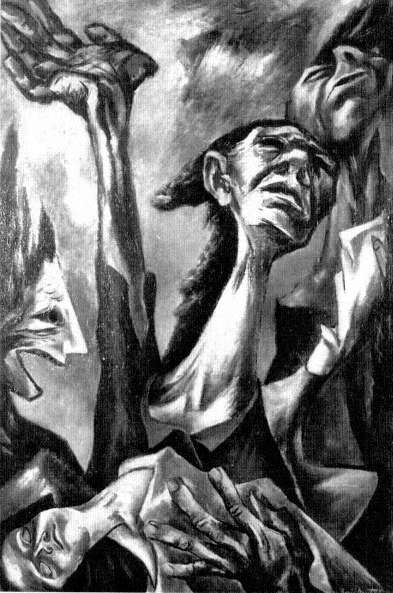
Figure 65
Boris Deutsch, What Atomic War Will Do to You , 1946.
Oil on canvas, 66½ × 46½ in. Judah L. Magnes Museum,
Berkeley, gift of the artist's estate. Photograph by Ben Ailes.
most cases, one suspects, the "discovery" of their genius was predicated upon their dutiful pilgrimage to the city. The many loners hostile to the trappings of self-promotion among Southern California's artists of the pre-1945 era inevitably created a framework particularly conducive to their subsequent obscurity within the context of our national art-historical memory of the twenties and thirties.
Critics, like artists, tend to gain authority among the public the more they are obsessed by absolutist rules about art. Yet anyone who has ever heard two equally good artists with different convictions about the nature and function of art savage each other's work should know that the more absolute a critic's convictions are, the less they should be trusted. The postwar era fostered a narrowly defined dualist sensibility that spoke to the "us-against-them" cultural mentality of the cold war. It could be argued that there has never been a more simplistic and provincial period in American art criticism than the fifties.
The absolutist single-mindedness of the critics of the late forties and early fifties exerted such a powerful hold over the American art scene that many worthy dissident early modernists were banished from our public memory almost overnight. Their rediscovery has been slow and erratic, determined largely by the prevailing fashions in art. Fortunately things are now beginning to take a new turn. Eclecticism is in. The tide of fashion has turned toward an ever-broadening pluralism. This stylistic eclecticism or, as we fondly (but inaccurately) designate it, postmodernism, is now encouraging us to look with renewed interest to the artistic productions of the twenties and thirties, that first great age of postmodernism.
A wide-ranging freedom to choose among styles and expressive options is the key to any creative art environment The diversity of qualities to be found among the works of the lone tangers of Southern California's art scene of the prewar years is testimony to these artists' true independence of spirit, and to their sophistication—for they knew very well what they were building upon and what they were fighting against. What separates their postmodernism from ours, however, is their sense of history, their conscious desire to forge a synthesis between the modern and what had come before. Without historical knowledge, artists are doomed to a parochialism that forces them to slam-dance blindly in a closed circle of options, and to remain stuck, as so many are today, in a world of disconnected sound bites, tape loops, and sampled music, a world of imitation and re-creation and parody—helpless waifs of an "avant-garde" that has nowhere to go because it has no idea where it came from.
Journey Into the Sun:
California Artists and Surrealism
Susan M Anderson
Reminiscing about the 1940s, which he spent in Hollywood, the artist Man Ray said, "There was more Surrealism rampant in Hollywood than all the Surrealists could invent in a lifetime."[1] The peculiar and pervasive fantasy of Los Angeles, its illusion and promise of fame, made the city surrealist by nature. European dada and surrealist artists who visited California during the 1930s and 1940s felt both strangely at home and like fish out of water.
The international artistic movement most shaken by the events of World War II was surrealism. The war scattered the European surrealists and effectively ended the formal movement. Many of these artists subsequently passed through California; some decided to stay and make the state their home, at least for a while. Among the transients were Fernand Léger, Max Ernst, Marc Chagall, Roberto Matta, and Wolfgang Paalen. Besides Man Ray, others who spent considerable time in the state were Salvador Dalí, who invigorated the art scene on the Monterey Peninsula for several years; Hilaire Hiler, who lived in the Bay Area; and Gordon Onslow-Ford, who has resided in Northern California since 1947. These artists became conduits for the transmission of surrealist thought. The legacy they left behind in California is still being explored.
The quest for absolute freedom central to surrealism was also a hallmark of the California Dream. During the 1930s and 1940s artistic freedom was simultaneously real and paradoxical on the West Coast, where there were few long-standing social conventions, artistic traditions, or institutions to provoke rebellion. Artistic production at the time received its main stimulus in San Francisco from art schools and museums and in Los Angeles from a handful of well-managed private galleries.
The West Coast dealer Howard Putzel, together with the New York dealer Julian Levy, organized several shows of European surrealism in Los Angeles and the Bay Area in the mid to late 1930s at the Howard Putzel, Courvoisier, East West, and Paul Elder galleries. Stanley Rose's Centaur Gallery and Frederick Kann's Circle Gallery in Hollywood were also important venues. In the late 1940s Copley Galleries in Los Angeles,
run by the painter William Copley, showed the work of René Magritte, Joseph Cornell, Yves Tanguy, Man Ray, Matta, and Ernst. The Modern Institute of Art, started by the artist Frederick Kann, the actor Vincent Price, and others in 1947, exhibited Ernst, Klee, and Miró during its two years of existence.
San Francisco artists had little firsthand experience of advanced forms of modern art until 1935, with the opening of the San Francisco Museum of Art, directed by the forward-thinking Grace McCann Morley. Morley brought to San Francisco several of the exhibitions that New York's Museum of Modern Art organized under Alfred Barr, including, in 1937, Fantastic Art, Dada, and Surrealism , which led many Bay Area artists to experiment with surrealism.[2]
The only organized response to European surrealism in the United States emerged in Los Angeles in the 1930s, before the refugee European surrealists had arrived. Instigated in 1934 by Lorser Feitelson and Helen Lundeberg, Post-Surrealism, really an American critique of European surrealism, was deeply rooted in the social reality of 1930s America. Critics and artists were searching then for a truly American style, and there was a suspicion of experimentation and European influence. Post-Surrealism, however, succeeded in awakening an interest in surrealist models in the United States; it had far-reaching implications in the history of California art.
California underwent dramatic transformations when war broke out in Europe. The state was propelled into a war economy even prior to U.S. engagement, making Los Angeles and San Francisco major industrial as well as population centers. When California artists were called upon to turn their efforts toward the war, the nativist concerns of the American Scene school lost their grip on California art as well as on the American public. In the early years of the war European surrealism became an important stimulus.
The war acted as a powerful energizing force and as an agent for change, transforming regional artistic models and opening the way for new art forms. To portray the chaos and destruction of their world, many artists in California, now caught up in international modernist currents, chose a surrealist approach.[3] Man Ray, who lived in Los Angeles during the 1940s, inspired the experimentation in new genres and the crossover of popular culture and high art. Hans Burkhardt, Eugene Berman, and Rico Lebrun disseminated an expressionistic, abstract surrealism invoking war's disequilibrium. Charles Howard, who in 1940 returned to the Bay Area from London, introduced to the state an organic, abstract surrealism with the expressive emotional power of the sublime that reflected the spiritual temper of the time. Statewide few artists were well versed in the principles of automatism, however, and consequently they adopted the formal elements of surrealism rather than its methodology or intellectual tenets.
At the close of World War II the interest in international modernism intensified. Artists carried forward the spirit of surrealism and dada, adapting it to the urgencies of the postwar era. They spiritually embraced and visually articulated the rhetoric of the 1930s expressing the need to create a truly American art, but this time within a more
radical framework. European surrealism invigorated postwar American art and helped give birth to abstract expressionism.
The late 1940s marked the beginning of an era of intense experimentation in the San Francisco Bay Area. Beat poets, photographers, filmmakers, assemblage artists, figurative artists, and abstract expressionists would soon coexist and nourish each other. The postsurrealist Dynaton movement, created by the Austrian Wolfgang Paalen, the American Lee Mullican, and the Englishman Gordon Onslow-Ford, added to this incredibly complex artistic mix by awakening interest in Jungian psychology, esotericism, the nonrational, and the new physics. Surrealist ideas were "in the air," making possible an extraordinary diversity of inflection.
Post-Surrealism and the Flux: Lorser Feitelson, Helen Lundeberg, and Knud Merrild
Artistic activity in California during the 1930s and 1940s was a process of reciprocity and encounter between artists of many regions and many nationalities. Art thrives on such mixing, clashing, cross-fertilization, and critical difference. European surrealism blended with indigenous styles, enriching regional art and creating interesting hybrids.[4] One example of this crossbreeding is the Post-Surrealism inaugurated in 1934 by the Los Angeles artists Helen Lundeberg and Lorser Feitelson. Post-Surrealism differed radically from surrealism in affirming a conscious rather than unconscious use of materials and the clarification of rational ideas. It maintained a distinct identity, reflecting and invigorating the locale of its birth.
Lorser Feitelson, educated in New York, came to Southern California in 1927; he was to be one of the most influential pioneers of modern art in the region. In the early 1920s Feitelson had visited Paris, where surrealism was incipient and neoclassicism had taken hold. It was the latter that first attracted him, along with Renaissance and Mannerist art.
In 1930 in Los Angeles, Feitelson was introduced to Walter and Louise Arensberg and their European modernist collection, which included masterworks of dada and surrealism and was a nexus for the intellectual/artistic community of Los Angeles.[5] Around this time, Feitelson started teaching at Chouinard School of Art and at the Stickney Memorial Art School in Pasadena, where he met Helen Lundeberg. Thereafter, Feitelson and Lundeberg formulated ideas that crystallized in 1934 into what they called subjective classicism, new classicism, or Post-Surrealism.
In creating their new art, Lundeberg and Feitelson grafted the neoclassicism Feitelson had picked up in Paris onto the metaphysical element he found in the paintings of de Chirico (which the Stendahl Galleries had exhibited in Los Angeles in 1930). The works that followed proclaim that connection: in their theatrical intensity, their insistence on strange encounters between objects, the clarity with which chosen fragments of reality are represented, and the depiction of deep space. But while de Chirico bathed
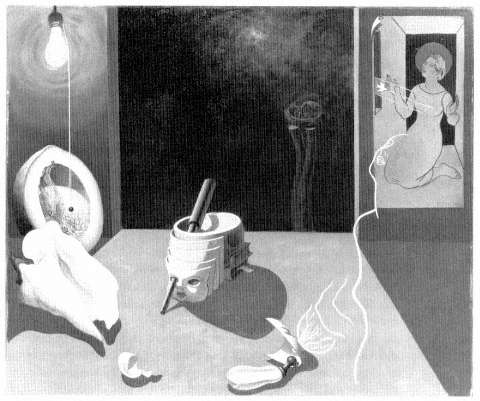
Figure 66
Lorser Feitelson, Genesis #2 , 1934. Oil on fiberboard, 40 ¼ × 47 7/8 in.
National Museum of American Art, Smithsonian Institution, museum purchase.
his enigmatic paintings in warm, late-afternoon sunlight, Feitelson and Lundeberg used pale, cool colors to create an atmosphere conducive to calm and to contemplation.
Feitelson and Lundeberg sought to create a reasoned response in the viewer that was profoundly at odds with Bretonian surrealism. Like the Belgian René Magritte, the Post-Surrealists created puzzles and told stories using objects. But while Magritte's tales were insistently unsolvable, Post-Surrealist narratives were always related to a larger theme and therefore had little to do with surrealist incongruity. Reflecting the spirit of the times, Feitelson and Lundeberg created paintings with a conscious message, an art that would be "accessible to the people." But rather than use subjects reflecting the social and political atmosphere, like artists of the American Scene, they selected metaphysical ideas, focusing on such themes as "cosmic birth."[6]
In Genesis #2 (1934; Fig. 66), Feitelson juxtaposed symbols of life forces analogous
in form and in function: an illuminated lightbulb, the half-round of a cut melon full of seeds, a large conch, an eggshell, a mask, and a female breast. He asks the viewer to contemplate the interrelationship of these differing emblems of existence, from the cosmic to the mineral. One of the most compelling features of the painting is the delicate ghostly outline of a woman superimposed over the scene, simultaneously receiving life and giving sustenance—an image expressive of the dialectic between presence and absence that initiates so much of the narrative in Post-Surrealist work.
Feitelson, a natural leader like Breton, assembled a loose circle of friends who had similar aims. Lundeberg, Knud Merrild, Lucien Labaudt, and Grace Clements were the core group, who exhibited together at the San Francisco Museum of Art in 1935 and the Brooklyn Museum in 1936. Because of the acclaim the exhibition received in New York, Feitelson, Lundeberg, and Merrild were included in Barr's exhibition Fantastic Art, Dada, and Surrealism at the Museum of Modern Art in New York.
Born in Chicago, Helen Lundeberg was raised in Pasadena, where she received her initial instruction with Feitelson at the Stickney Memorial School of Art beginning in 1930. Lundeberg began her career with exceptional technical skill and stylistic maturity: "Like Athena, she appeared on the artistic scene full-grown."[7] It was Lundeberg who wrote the manifesto of the Post-Surrealist movement.
Lundeberg was interested in a poetic contemplation of subject matter that would bring the viewer to a higher understanding of metaphysical ideas and a deeper experience of the world. Throughout her career her paintings have become increasingly more evocative and mystical. Nearly all her work is about the opening of one space into another, the juxtaposition of internal and cosmic arenas. While she did not make a study of Eastern art and philosophy while engaged in her Post-Surrealist work, she created a contemplative aesthetics of emptiness and stillness characteristic of that art. At the same time, her work showed an American predilection for definite outlines, cool precision, and microscopic attention to detail. Cosmicide (1935; Fig. 67) embodies many of Lundeberg's deepest aims. Believing that the shape of a painting could be dictated by its meaning, she began making shaped canvases. Cosmicide is a trapezoid, narrow at the top to accommodate a single planetary body, the moon. Invoking the eternal cycle of life and death, it illustrates the interrelationship of all things: the influence of the tidal action of the moon upon the smallest living creature.[8] (Lundeberg had studied astronomy and biology.) She introduces into the painting a vast dreamlike landscape reminiscent of the California desert or the infinite space of Tanguy, including the typically western symbol of the cactus. Lundeberg (and Feitelson) depicted such themes as eternal recurrence and the relationship between love and death, without erotic overtones.[9]
In Double Portrait of the Artist in Time (1935; Fig. 68) Lundeberg created a pristine and precisely calculated formal structure. She often incorporated her own image into her quiet interior spaces, prefiguring the feminist art that emerged in the 1970s.[10] She described the painting as follows:
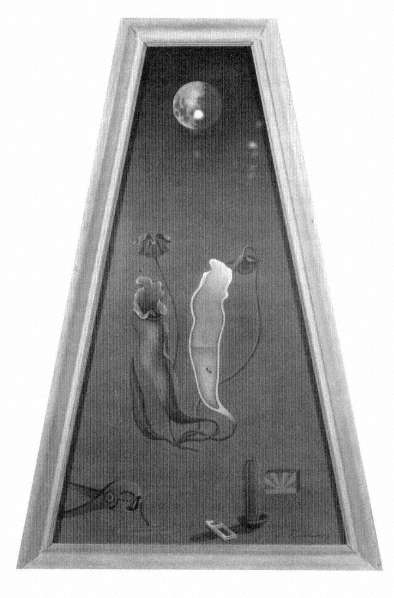
Figure 67
Above: Helen Lundeberg, Cosmicide , 1935. Oil on Masonite, 40 × 24 in.
NAA-Gift of the Peter Kiewit Foundation, Sheldon Memorial Art Gallery,
University of Nebraska-Lincoln.
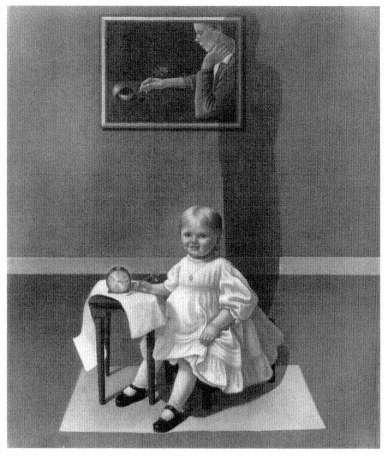
Figure 68
Helen Lundeberg, Double Portrait of the Artist in Time ,
1935. Oil on fiberboard, 47¾ × 40 in. National Museum of
American Art, Smithsonian Institution, museum purchase.
For the portrait of myself as a child I used a photograph which I still have, and though the props are a little different in the painting from the photograph, the pose is pretty much exact. I also used the clock to show that it was a quarter past two which corresponds to the child's age. And instead of presenting myself as an adult before a painting of myself as a child, in Double Portrait in Time I reversed this possibility where the child casts a shadow which is that of an adult who appears in the portrait on the wall.[11]
Another of the Post-Surrealists to achieve national distinction was the Danish artist Knud Merrild, who arrived in Los Angeles in 1923. Progressive in art as well as politics, Merrild was attuned to advanced European modernism and quickly found himself at the center of the art scene in Los Angeles. Man Ray and the writer Henry Miller were close friends of his, and he was one of the few American artists collected by Walter and Louise Arensberg.
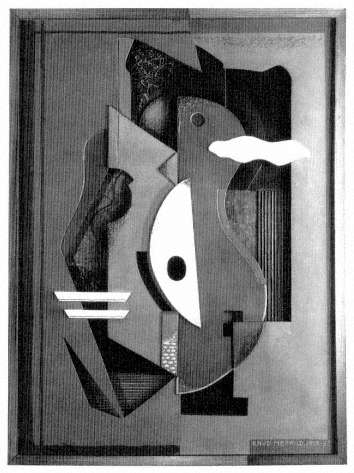
Figure 69
Knud Merrild, Aesthetic Function in Space , 1928-33. Painted wood
construction with painted cutouts of Masonite, painted corrugated
cardboard, and silvered metal, 31 × 22 ¾ in. Private collection.
Photograph courtesy, Steve Turner Gallery, Los Angeles.
In the 1930s Merrild made surrealist paintings and collages as well as relief constructions (some of the earliest assemblages to come out of the region), which owed a debt to Ernst, Kurt Schwitters, and organic surrealism (Fig. 69).[12] His collage Alpha and Omega (1935; Fig. 70) is related formally and thematically to Lundeberg's shaped canvas Cosmicide and Feitelson's 1936 shaped collage-painting Life Begins (Fig. 71), expressing the natural law of regeneration: "a cycle of desire, impregnation, generation and birth."[13] It illustrates the artistic borrowings and interactions common among early Los Angeles modernists.
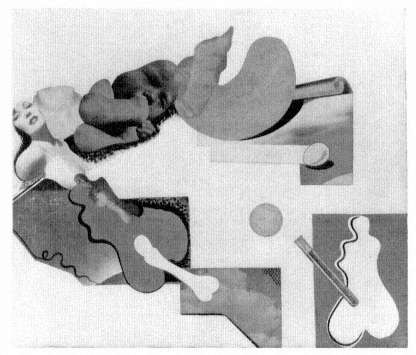
Figure 70
Above: Knud Merrild, Alpha and Omega , 1935. Collage: oil cloth, paper,
magazine and newspaper cutouts, and ink drawing on board, 23 ¼ × 29 ¾ in.
Photograph courtesy Steve Turner Gallery, Los Angeles.
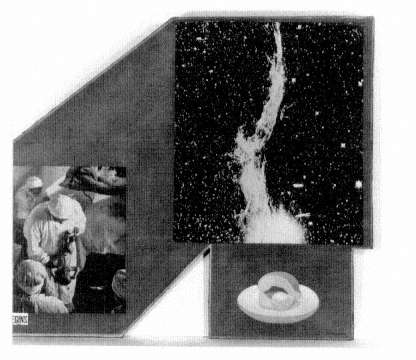
Figure 71
Left: Lorser Feitelson, Life Begins , 1936. Oil and photocollage on Masonite,
22 ½ × 26 ½ in. Photograph courtesy Tobey C. Moss Gallery, Los Angeles.
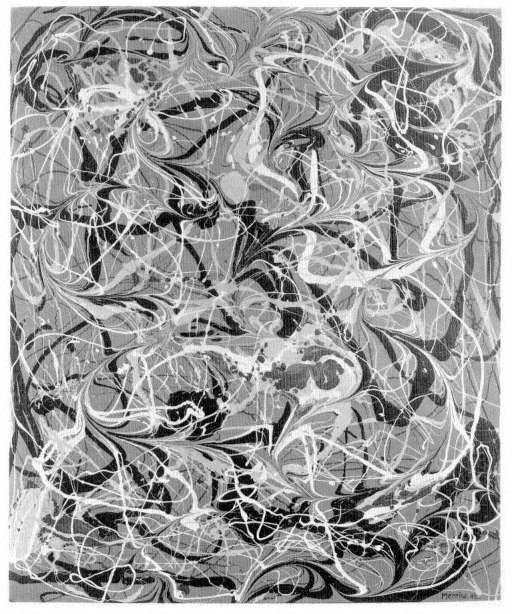
Figure 72
Knud Merrild, Perpetual Possibility , 1942. Enamel on composition
board, mounted on plywood, 20 × 16 1/8 in. The Museum
of Modern Art, New York, gift of Mrs. Knud Merrild.
In the early 1940s Merrild experimented with surrealist automatism, exploring the fortuitous and the unforeseen in his flux paintings. In works such as Perpetual Possibility (1942; Fig. 72) Merrild pooled and dripped house paint onto a fluid surface, which he then tipped, running the colors together to create unexpected effects. These paintings are reminiscent of Onslow-Ford's coulages of 1939 and Pollock's drip paintings of five years later. As Jules Langsner eloquently stated, "The impetus to invention came from the necessity to give form to a considered view of existence. For Merrild, that view was rooted in his belief in the life-giving properties of chance, of growth, of discovery, of susceptibility to that which is new, untapped, of one's own time."[14]
Other artists who periodically exhibited with the Post-Surrealists were students of Feitelson's: Philip Guston (then Goldstein) and Reuben Kadish, who together painted a 1937 fresco for the Los Angeles Tubercular Sanitorium at the City of Hope under Feitelson's supervision.[15] The fresco, which takes alchemy as its subject matter, was one of the few murals completed for the Works Progress Administration (WPA) in Southern California that shows any modernist experimentation at all. Guston and Kadish were also politically active, later becoming members of the American Artists Congress, which provided a forum for leftist political ideas.[16] Even so, Bretonian surrealism, which sought the transformation of social structures through revolution, was far more political and leftist-oriented than Post-Surrealism.[17]
"DADA of Us All": Man Ray in Hollywood
While we have become accustomed to the noir image of 1940s Los Angeles in the literature of such writers as Raymond Chandler, it is clear that there was another side to the story. Recalling his days in Hollywood, Man Ray said:
It was like some place in the South of France with its palm-bordered streets and low stucco dwellings. Somewhat more prim, less rambling, but at the same time radiant sunshine ... one might retire here, I thought, live and work quietly—why go any farther ... I had a wonderful time, this was the first time in my life when I really felt like I was on vacation.[18]
Man Ray, a founder of New York dada and a central figure in the Paris surrealist group, lived from 1940 to 1951 in Los Angeles, where the artist-dealer William Copley called him "the DADA of us all."[19] Although an American, Man Ray was, in many ways, as much an expatriate on these shores as Ernst and Breton. After escaping occupied France in 1940, he drove across the United States and took up residence on Vine Street, opposite the "All Night" Ranch Market. In 1946 he married the dancer Juliet Browner in a double wedding with Max Ernst and the painter Dorothea Tanning. Walter and Louise Arensberg gave them a reception in their Hollywood home. Ernst painted Double Wedding at Beverly Hills to commemorate the event.[20]
Man Ray was born in Philadelphia in 1890 as Emmanuel Rudnitsky. At the age of twenty-five he met Marcel Duchamp and Francis Picabia in New York, two years after Duchamp's painting Nude Descending a Staircase, No. 2 caused an uproar at the Armory Show. As friends, he and Duchamp directed the course of New York dada and founded the avant-garde art group Société Anonyme. When Man Ray went to Paris for the first time, in 1921, he was immediately accepted by the group that would later call themselves the surrealists.
Man Ray was extremely prolific in Los Angeles, producing there in ten years more paintings, objects, photographs, and his trademark Rayographs—many of them elaborations of former work—than he had in the prior thirty. Night Sun—Abandoned Playground (1943) is a disquieting narrative, a fusion of his favorite earlier themes with recent events in his California life, alluding to his difficult passage to the United States from occupied Europe. The painting contains typically western images such as a sun setting over the ocean, a white beach, and a cypress tree, but the tree has toppled against a Spanish-style bungalow, apparently the artist's own home. The molecules floating inside the house no doubt refer to Man Ray's neighbor, the Nobel Prize-winning chemist Linus Pauling.[21] Molecular arrangements also appear in other works from this period, such as the collage Optical Longings and Illusions (1943).
Man Ray exhibited his Los Angeles production of surrealist objects, or assemblages in the spirit of readymades, in a 1948 exhibition at the Copley Galleries. These "Objects of My Affection," as the artist called them, were notable examples of the crossover between popular culture and high art in Los Angeles, a form of proto-pop art. His Optical Hopes and Illusions (1944), a mixed-media object composed of a found banjo frame, ball, and mirror, is an ominous toy that makes no sound, referring to Man Ray's thwarted artistic aspirations and the fantasyland of Hollywood.[22]
La Fortune, III (1946), an assemblage composed of a wheel of fortune and a roll of toilet tissue affixed to an upright plank, similarly implied a wiping away of deceit and decay, a scrubbing clean of social veneers. This piece evoked the surrealist "penchant for chance, for the objet trouvé, and for the double entendre."[23]
In his work Man Ray constructed a dada/surrealist metaphor of the ambiguous relationship between the real and the fictive, making reference to the uncertain nature of Hollywood culture and its destinies. He was one of the few artists of the time to respond to Hollywood so directly in his work and perhaps one of the first to address the dark side of the Sunshine Muse.[24]
Man Ray exhibited and lectured extensively on the West Coast (even broadcasting lectures over the radio) beginning in the mid-1940s,[25] but he considered the 1948 exhibition at the Copley Galleries the high point of his sojourn in California. For the opening, the gallery created a Paris café atmosphere. The list of guests gives an idea of the notable artists, musicians, and film people in his circle: Josef yon Sternberg, Edward G. Robinson, Harpo Marx, Fanny Brice, Lorser Feitelson, Helen Lundeberg, Peter Krasnow, George Biddle, Hans Hofmann, Isamu Noguchi, Eugene Berman, Robert,)
Matta, Knud Merrild, Max Ernst, Dorothea Tanning, Igor Stravinsky, Aldous Huxley, Bertolt Brecht, Thomas Mann, Henry Miller, Luis Buñuel, Jean Renoir, and Otto Preminger.[26]
In addition to his objects and assemblages, Man Ray also exhibited a series of paintings, the Shakespearian Equations , derived from his 1930s photographs of the constructions illustrating algebraic equations in the Poincaré Institute in Paris. These spare depictions, which may have opened the way for abstraction in California, are particularly evocative of Lorser Feitelson's Magical Forms series of roughly the same date.
Journey into the Body: The Art of Charles Howard
In his painting The Progenitors (1947; Plate 10), Charles Howard organized his shapes in rhythmic chains extending over the entire field, with pockets of deep space opening up in the midst of them. These metallic forms from an inner biological realm are bound together as if the system were tentatively structured, not as a matter of function, but as the result of some terrible, cosmic mistake. This painting, which simultaneously expresses chaos and biological limitation, also hints at the possibility of a new order. In Howard's art everything has the power to become something else. It is this sense of potential or transformation that binds his art to that of the surrealists and of Miró.
Howard's art, which incorporated unconscious elements and exploited the automatist approach—though in a restrained manner—declared "very explicitly a balance between reasoned construction and free intuition."[27] His surrealism shared the abstract formalism of the work of Jean Arp and Alexander Calder, which favored the traditions of cubism, constructivism, and De Stijl. Howard achieved an extraordinary fusion of two opposing forces in his work, the one rational and obsessed with order, the other exploring chaos and the depths of the unconscious. It was from this dialectic that, according to surrealist belief and imagery, alternative possibilities emerge.[28]
Howard, an American expatriate who returned to San Francisco from London at the outbreak of World War II, was raised in the Bay Area.[29] In 1932 Julian Levy had presented Howard's work in the groundbreaking exhibition that introduced European surrealism to the United States. He had included only three Americans: Howard, Man Ray, and Joseph Cornell. The following year Howard moved to London, where he was active with the London surrealists from 1936 to 1938.
Though Howard's work shares surrealism's obsession with unconscious material, it is related more to the biological patterns of bodily growth and decay than to the psychological world of dreams. Howard's paintings, which inspire the dim remembrance of primordial experiences such as the moment of birth or a premonition of death, also inspire a feeling of awe arising from heightened awareness of the sensing and feeling self.
This sense of inner sublimity connects Howard's work to traditions in eighteenth-and nineteenth-century English painting.[30] A special state akin to the "marvelous" of
the surrealists, the sublime also contributes to a feeling of awe before the infinite, conveyed in Howard's work.
Movement was also a central concern of the artist. Like his lifelong friend Calder, Howard founded an art that exploited a "kind of mechanistic motion in space which grows inevitably from modern urban life."[31] Yet Howard was restrained in the employment of motion, and the dialectical nature of his art is here most apparent: he created primarily static constructions in which certain forms introduced a subtle sense of movement; in this his work shares much with the paintings of Kandinsky. In other works, Howard created a feeling of intense stillness that seemingly forebodes cataclysmic change. His paintings speak of time suspended, or a sense of déjà vu reflecting the political climate of the World War II era.[32]
Howard went through an artistic catharsis during the early blitzes in London, and his work took on a darker, more emotional quality, became more tense and dramatic. One critic compared his approach then to that of the artist Paul Nash, "who developed a kind of 'found-object' art out of the shapes of shattered buildings and splintered Messerschmitts."[33] In First War Winter , 1939-40 (which Howard completed in San Francisco), there is an explosion of forms, as if an architectural structure were composed of parts on the verge of collapse. Narrow filaments sag toward the center of the composition, creating the impression that everything is being sucked into a vortex.
In 1940 Howard left the chaos of wartime England and moved back to San Francisco, where his work was immediately well received by local critics and the director of the San Francisco Museum of Art, Grace McCann Morley. He acted as designing supervisor of the WPA and in 1945 took part in a lecture series on surrealism at the California School of Fine Arts that included Salvador Dalí, Man Ray, and the surrealist poet Georges Lemaître.[34]
During the war, Howard worked in a shipyard, where the symmetry of ship construction engaged him and where scrap piles provided him with streamlined forms and accidental twists of metal. He also spent hours in the library looking at books on biology. His work began to incorporate a greater sense of the biological and of the metallic and also revealed his increased interest in multispatial arrangements, though he retained an essentially flat two-dimensional space by exploiting the ambiguity of figure and ground.
The First Hypothesis (1946; Fig. 73) was completed shortly before Howard returned to live permanently in England. In it hairlike filaments spill out of an "organ" encased in other forms and positioned along a central axis or totem-pillar. A single, bladelike form protrudes into our space. Reminiscent of the symbol of infinity, it refers to the unknown, or to expansive infinite space and alternative possibilities, ideas implicit in Howard's mature work. As Howard's most eloquent critic, Douglas MacAgy, wrote:
The abyss is a recurrent motif in the arts. It has inspired a range of responses from curiosity through wonder, awe, fear and dread. This abyss, with its origin of light obscured and its illumination lost in a periphery of darkness, may be claimed to present the unknown as a
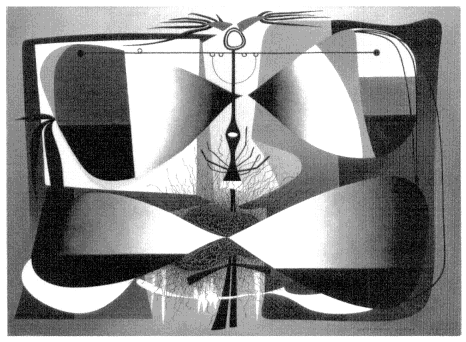
Figure 73
Charles Howard, The First Hypothesis , 1946. Oil on canvas,
16 ¼ × 22 1/8 in. The Menil Collection, Houston. Photograph by Paul Hester.
hidden power. Stability is threatened: projected movement into it might be endless and timeless. To become absorbed by it could mean that dimensions might be transformed, and with the change, a measure of faith. This unknown may be unformed, but it cannot be called formless. In a word it is that archetype of the abyss—Chaos.[35]
Howard fashioned a visceral art in which abstract forms were a potent vehicle of the sublime. He was one of California's most prominent and influential artists during the war. Afterward, when he returned to England, he continued to develop his art, creating in the 1960s ever more austere visions that paired minimalist simplicity with a great complexity, expressing the primal struggle between order and chaos intrinsic to surrealism.[36]
Isle of Possibility: Gordon Onslow-Ford and the Dynaton
San Francisco, long a haven for nonconformists and eccentrics, was in the postwar period a mecca for artists, poets, and other members of a growing counterculture.[37] Here artists with modernist leanings developed a strong sense of community. San
Francisco was also a city poised, like all of California, "between the currents of the great old cultures of the Pacific and the stirring forces of America."[38] This openness to the cultures of Mexico and the Pacific Rim, and to the stream of international modernism, provided the catalyst for the Dynaton.
The Dynaton came into being in the late 1940s. Wolfgang Paalen had been brewing the postsurrealist experiment for five years in Mexico before moving to the Bay Area in 1948. As Lee Mullican recalled, "Paalen felt that there was an intellectual climate in San Francisco where something could really happen. The war had ended. We were all enthusiastic that ... this scene would be a growing center of culture. And the museum was sympathetic to what was happening."[39]
Some years earlier in France, prior to the outbreak of World War II, Gordon Onslow-Ford and the Chilean surrealist Roberto Matta had together developed the idea that the world of perception was only a section of a larger, invisible, order of existence in which everything was bound together into an indivisible whole.[40] When they joined André Breton's surrealist movement during its final phase in 1938, they had already developed their own approach to automatism, which had more to do with time and space than with Freud.[41] Together they reoriented the movement toward the more abstract and automatic foundation from which it had arisen in the early 1920s. This later form of abstract surrealism, which was so influential in the United States in the early 1940s, was more concerned with ideas about higher dimensions and with exploration of a fluid time-space continuum than the earlier version had been. Although surrealism is usually associated with the studies of Freud, it is clear that art at this time developed out of a matrix of influences and ideas, and that later surrealism owed as much to concepts about space and the fourth dimension as it did to psychology.[42]
When he arrived in the United States in 1941, Onslow-Ford became distinguished as surrealism's chief spokesman in the country until Breton came later that year. Onslow-Ford gave the first significant series of lectures on surrealism in the United States, at the New School for Social Research. Along with Howard Putzel, he also organized chronological exhibitions to accompany these lectures. Onslow-Ford was key to the assimilation of surrealist methodology and thought in the years when American art was coming of age.[43]
In 1941 Onslow-Ford went to Mexico, where the Austrian surrealist Wolfgang Paalen had moved two years earlier at the invitation of Diego Rivera and Frida Kahlo. Paalen's reputation had been established in 1936 in Paris, and he was one of the organizers of the Paris International Surrealist Exhibition in 1938, the year he met Gordon Onslow-Ford at the Café Deux Magots. Paalen's real contribution to international art came in Mexico, however, where he was inspired by the primal spirit of native American arts, the new physics, and the thought of John Dewey. In 1940 he helped Breton organize an international surrealist exhibition there.[44]
In Mexico Paalen published Dyn , one of the most avant-garde art journals flourishing internationally during the war. This interdisciplinary (mainly English-language)
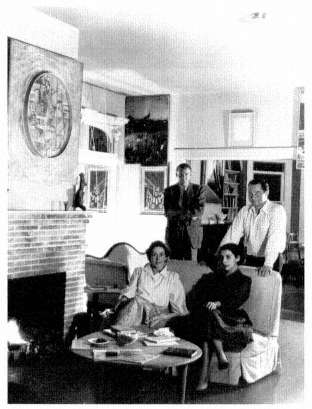
Figure 74
Clockwise from top left : Lee Mullican, Cordon Onslow-Ford,
Luchita Hurtado, and Jacqueline Johnson in the San
Francisco home of Onslow-Ford and Johnson, ca. 1951.
Harry Bowden papers, Archives of American Art,
Smithsonian Institution.
review of art, archaeology, and science circulated theoretical and critical essays as well as illustrations of contemporary masters like Picasso and Henry Moore, and the emerging Robert Motherwell and Jackson Pollock. It especially focused on the native arts of the Americas and on art theory, advancing "an open-ended approach to art based on creativity's boundless potential."[45] Paalen saw automatism as a source of raw material for the artist but not as an end in itself. He published his "Farewell to Surrealism" in the first issue; Onslow-Ford, after officially resigning from the movement in 1943, contributed to the final issue. Dyn had a significant impact on expatriated European artists in the United States as well as the emergent New York School. During the war years it led many artists into surrealist phases, including Lee Mullican in 1943. Others with whom Paalen and Onslow-Ford were in close contact in Mexico were Motherwell and Matta. Motherwell recalled that "what we did ... as then-isolated Western intellectuals in Mexico, was to encourage each other in our various aspirations and with our various bits of knowledge."[46]
Onslow-Ford moved to the San Francisco Bay Area permanently in 1947, taking with him a formidable collection of twentieth-century modernist and pre-Columbian art (Fig. 74). He had a major retrospective at the San Francisco Museum of Art in 1948,
accompanied by the publication of his book Towards a New Subject in Painting . Lee Mullican returned from military duty, and Paalen also moved to the Bay Area in the late 1940s, where each had a retrospective at the San Francisco Museum of Art.
Paalen, Onslow-Ford, and Mullican soon discovered they shared common aims, and in 1949 they lived together for a few months in Paalen's Mill Valley house. In 1950 the artists exhibited together at Stanford University, with lectures by Sybil Moholy-Nagy, Onslow-Ford, and Paalen. Soon thereafter the artists were shown again, this time at the San Francisco Museum of Art in an exhibition they called the Dynaton .[47] In one of his two essays for the exhibition catalogue, Paalen wrote:
Our images are not meant to shock nor to relax; they are neither objects for mere aesthetic satisfaction nor for visual experimentation. Our pictures are objects for that active meditation which does not mean detachment from human purpose, but a state of self-transcending awareness, which is not an escape from reality, because it is an intuitive participation in the formative potentialities of reality.[48]
According to the group, the Dynaton (from a Greek word meaning "the possible") was a transformative art, a fusion of the artists' interests in pre-Columbian and native American cultures, shamanism, non-Western philosophies such as Zen Buddhism, the new physics (particularly wave-particle theory), and extraterrestrial life, all in an essentially meditative framework. The artists of the Dynaton espoused the principles of European surrealism—automatism and the primacy of the unconscious—and the vital quiet in California nature as their points of departure.
Nature was essential to the Dynaton. Paalen poetically referred to the work of each artist in terms of the four elements. "For Gordon the element is water and all it hides and bares, the moon, the neckline of the figurehead and the breath in the shell.... Air is the element for Lee, and all it carries, pollen, feathers, the dreams of birds and spikes of stars and the holy nest of winds ... the ray of sun on the straw." Paalen referred to himself as "the fire, the places where the devil cooks his ware."[49]
Onslow-Ford's Dynaton paintings radiate a sense of the artist's preternatural intimacy with nature. In A Stone That Dreamed (1950; Fig. 75) a vertical surface grid of broken color creates a screen through which pulsating dots subtly move. It is as though reality were coming into focus from behind a veil of illusion. Viewers, actively meditating, situate themselves in the kinetic space of the painting.[50]
According to Mullican, the Dynaton now floats in his memory "as a softened sun."[51] His mandala-like paintings (Fig. 76), reflective of the West's wide-open spaces and possibility for intimacy with nature, invited contemplation. Capturing the essence of vast expanses of sea, land, and sky, Mullican contributed "the sunlit fields and refractions of the West" to the aesthetic of the Dynaton.[52]
Soon after the 1951 San Francisco exhibition, the group disbanded. Paalen returned
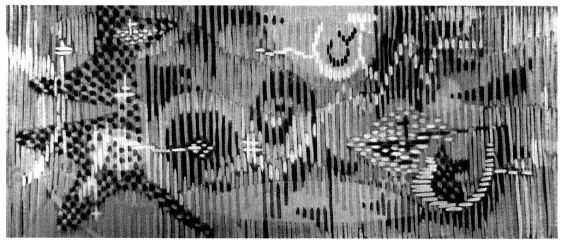
Figure 75
Above Gordon Onslow-Ford. A Stone That Dreamed , 1950. Casein on paper
mounted on board, 36 × 85 in. Collection of the artist, Inverness, California
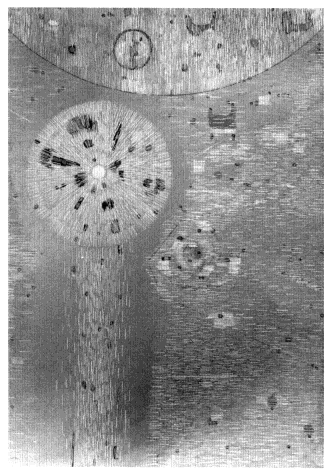
Figure 76
Left: Lee Mullican, Peyote Candle , 1951. Oil on canvas,
50 × 35 in Collection of the artist, Santa Monica, California.
to Mexico and Mullican moved to the Los Angeles area, where he has lived ever since, spending much time in New Mexico as well. Onslow-Ford moved to Mill Valley and later Inverness, where he now resides.
In retrospect, Onslow-Ford feels his contribution to art was only just beginning at the time of the Dynaton exhibition. Six months later he discovered a more direct expression of the deep structures of the mind in what he called line/circle/dot. It was then he felt he had discovered the root of all things and "the depths from which things grow."[53]
Both Onslow-Ford and Mullican (who also feels his own Dynaton paintings belong to a formative stage of his art) still find inspiration in their early breakthroughs with Paalen in San Francisco. The Dynaton artists, in addition to exhibiting an interest in native American culture and meditative states of consciousness, integrated Eastern philosophies into their art, thus exemplifying an early openness to Asian culture. This openness has been a continuing influence on American art and culture since the 1960s, but for an even longer time it has been intrinsic to the art of California, because of the state's location on the Pacific Rim.[54]
Conclusions and Consequences of Surrealism
Surrealist expression in California emerged during the 1930s and 1940s from audacious experimentation and innovation at the boundaries of art forms and genres. Surrealism proved an experimental art that could be exported anywhere, taken up by others and mixed with local cultural possibilities. California artists tinkered with the international model and gave surrealism new meaning.
Surrealism is an art of internal experience and its transformation into a profound form of self-portraiture. Surrealist-inspired California art revealed the artist's encounter with the inner and outer world during a period in U.S. history when traditional certainties, boundaries, and identities were thrown into question.
Although the history of surrealism in California is inextricably tied to the depression and the events of World War II, common experiences of these crises are not always directly visible in the work of California artists. Diverse and individual expressions arose in California art during the 1930s and 1940s; their inner similarities are as striking as their formal differences. Connecting much of the work are metaphors for "interconnectedness," "potential for change," "vastness," "restriction," "elasticity in relationship to space," "dialectic between presence and absence," "the ambiguous relationship between the real and the fictive," and "the fictional nature of the culture." Some of these metaphors are those of modernist art as a whole. Others are more specifically related to California modernism and seemingly point toward a postmodern aesthetic.[55]
It was not surprising that surrealism took early hold in Los Angeles, where Hollywood movie lots often spill out into city streets. Los Angeles was surrealist by nature. Artists then, as now, could hardly evade the effects of this popular culture—a creative
force continuously reinventing itself—on their art.[56] The link between surrealist art and the popular culture of the film industry in the region was articulated as early as 1934 by the San Francisco critic and artist Glenn Wessels, who reviewed a Max Ernst exhibition at the Paul Elder Gallery: "Ernst speaks from that half-world, the subconscious, the world of dreams, the Mickey Mouse world . . . where 'almost anything is more than liable to happen.'"[57]
California surrealist expression developed outside the mainstream of modern art, in the freedom of the western frontier. The frontier lies physically and metaphorically far from artistic rules and institutional strictures, tradition, and imposed ideas. It encourages inwardness, individuality, reflection. Much of California art exhibits an obsession with the natural landscape, its light and space. Post-Surrealism, for example, evoked a sense of freedom, contemplation, and peacefulness that can be attributed to the geographic and climatic conditions of the Pacific coast. Nonetheless, it was not merely a local Los Angeles expression; its concepts were universal. Even so, the work cannot be accommodated in the framework of "international surrealist art," because its focus and priorities were radically different. It exemplifies the inevitable meeting and clashing of cultures, ideologies, and artistic styles that contribute to the stylistic eclecticism or pluralism characterizing much of California modernist art.[58]
A closer study of Man Ray's Los Angeles period and his influence on regional artists is still called for. His work was an anticipation of pop art "in the meticulous rendering of ordinary things unexpectedly isolated for our contemplation—" though invested with an enigma lacking in pop art.[59] Man Ray's California output contributed to the emergence of pop art, because it may have directly influenced the proto-pop expression of artists like Jess, who was living in Southern California and actively visiting galleries at the time.
Clearly in melding European surrealism and the popular culture of Los Angeles Man Ray helped define a regional propensity for creating art that achieved a crossover between popular culture and high art. He also brought to light the Southern California inclination to mix fantasy and the real. To harbor such opposites while simultaneously dissolving the barriers that distinguish them is a feature intrinsic to surrealism, as well as to postmodernist theory. Equally, his Rayographs and other photographic work initiated a special role for photography in regional art, beginning in the 1960s with the artists Wallace Berman and George Herms and including diverse others such as Robert Heinecken and John Baldessari. Man Ray contributed to the strain of Los Angeles art that understood the potential of the photograph-as-object and endorsed photography as a serious element of the art lexicon long before the New York postmodernist work of the artists Sherrie Levine, Richard Prince, Cindy Sherman, or others in the 1980s.[60]
Changes were also visible in the art of Lorser Feitelson beginning in the early 1940s, changes that must have been due to the wartime climate and the influx of refugees from Europe, especially Charles Howard and Man Ray. Feitelson developed his Post-Surrealism until about 1942, when his art went through a transformation and began to
reflect "the realization that certain kinds of events unexpectedly take one beyond the usual way of experiencing things."[61] In this new work, Feitelson developed surrealist abstractions in which he sought to "invent 'magical forms' at once tangible and without parallel in memory, concrete and freighted with interior sensation."[62] Thereafter he developed a spatially ambiguous art in which form and ground were indivisible, and in which shape was preeminent and wholly enigmatic, merely evocative of natural forms.
By 1950 Feitelson had become an exponent of the abstraction termed hard-edge, or abstract classicism, along with the artists John McLaughlin, Karl Benjamin, and Frederick Hammersley. While in Northern California surrealism developed toward abstract expressionism, in Southern California it developed toward geometric abstraction. Like Post-Surrealism, abstract classicism evoked a contemplative peace based in local environmental conditions and the artists' conscious absorption of Eastern philosophies. At the same time, it conveyed a sense of movement, tension, or "slippage" that expresses the mobility and artificiality of Southern California culture, thus embodying at once the two directions visible in contemporary Los Angeles art. Abstract classicism anticipated the Los Angeles finish fetish of the 1960s and the light-and-space art of the 1970s and prefigured the important artistic impulse minimalism.[63]
In the San Francisco Bay Area in the 1940s, artists were exposed to surrealism primarily through the work of Charles Howard, Dorr Bothwell, Jean Varda, Clay Spohn, Stanley William Hayter, Mark Rothko, and the artists of the Dynaton group. It is doubtful whether those artists who championed abstract expressionism, especially at the California School of Fine Arts, would have been so open to the new gestural, abstract idiom without previous exposure to surrealist principles. At any rate, their interest in surrealism waned around 1948, in part because of their exposure to the anti-surrealist sentiments of Clyfford Still.[64]
Still's distaste for surrealist automatism was endemic during the late 1940s. The San Francisco school of abstract expressionism rejected myth-conferring titles and symbols, and its work rarely showed such surrealist commonplaces as swirling arabesques and curvilinear shapes. Moreover, because automatism was not fundamental to the painting process, the work produced was somewhat less linear and gestural than abstract expressionism in New York, more "rugged and earthy."[65]
While surrealist automatism was being discouraged at the California School of Fine Arts, it was invigorating an underground scene in the Bay Area and in Los Angeles that would coalesce into the Beat generation expression of artists like Wallace Berman, George Herms, Gordon Wagner, Jay DeFeo, and Bruce Conner. The Dynaton, a conceptual rather than a perceptual art, provided a bridge between the interest in surface of the San Francisco school of abstract expressionism and the content-driven art of the Beats.
The Dynaton's use of themes and motifs inspired by non-Western art forms and primitive art, its interest in the new science and extraterrestrial life, its allusions to Zen as well as its unorthodox approaches and anti-establishment attitudes paralleled the
interests of the post-Still generation: Asian philosophy, esotericism, Mexican culture, the nonrational, jazz culture, Alan Watts, and Jungian psychology. The Dynaton helped set the tone for much of the art of Northern California in the 1950s, contributing to the emergence of Beat and funk art. Onslow-Ford, Paalen, and especilly Mullican were connected with the underground activity that had begun in San Francisco in the early 1940s.
One of the earliest and most important manifestations of this counterculture was in experimental film. James Broughton and Sidney Peterson, who produced a surrealist fantasy, The Potted Psalm , and Frank Stauffacher, who initiated the Art in Cinema series at the San Francisco Museum of Art, were close friends of the Dynaton artists.[66] Surrealist automatist calligraphy is also visible in the 1950s work of several of the artists who exhibited at the Six Gallery, the focal point for Beat-era artists and poets from 1954 to 1957.[67] Five of the six artists who started the gallery had drifted up from Los Angeles, following the promise of an active and close-knit art community.[68]
The impulse to merge genres and to eliminate traditional boundaries between art forms grew equally out of the dada and surrealism of the artists Knud Merrild, Max Ernst, and Man Ray, who exhibited in Southern California widely during the late 1940s. What emerges from this picture is an untidy but vigorous history of cross-pollinations and complex interconnections. European surrealism has had a powerful influence on the art of California, from the abstract expressionism of the 1940s and the assemblage of the 1950s and 1960s to contemporary expressions.
Visual Music and Film-As-An-Art Before 1950
William Moritz
During the silent film era, when everything had to be expressed visually, the trick effects of Georges Méliès, the zany "surreal" improbabilities of comedies, the experimental decor of The Cabinet of Dr. Caligari , the expressionistic camera movement of The Last Laugh , or the shock editing of Potemkin were all played and found their way into the vocabulary of commercial features. Yet a distinctly modernist, avant-garde, or "experimental" film also emerged, partly through the participation of artists such as Man Ray, Marcel Duchamp, Francis Picabia, and Salvador Dalí, and partly because of the vigor with which filmmakers like Germaine Dulac and Sergei Eisenstein wrote about the viability of cinema as a vehicle for a modernist art that could add the dimension of time (including controlled duration of viewing, complex juxtaposition, and so forth) to the other elements that concerned contemporary painters and sculptors: abstraction, expressionism, significant form, integrity of materials, heightened perception, new technology.
The borderline between "experimental film" and "the movies" thus remained ill-defined: "art films" or "avant-garde films" were more the question, since expressive, experimental techniques distinguished certain films as more artfully, consciously made, more advanced than the run-of-the-mill commercial products, and those "art films"—including animation and live action, long and short, older and more recent films from all around the world—formed the basis of a critical and popular cult of film art that by 1930 was celebrated internationally in cineclubs and theaters, magazines and books.
Since European art films, classic silent films, or the avant-garde shorts of the 1920s were not screened at every theater, the visually literate of Los Angeles kept track of what was showing at the Filmarte Theatre on Vine Street. During the 1930s art films occupied a permanent place on the Filmarte screening schedules—and if you were lucky, Dudley Murphy, the primary filmmaker of the famous Ballet Mécanique , might show his personal copy of that film (with the brief erotic flashes still intact among the
pumping machines), which James Whitney, Harry Hay, and Man Ray saw there.[1] Or in the 1940s, at Clara Grossman's American Contemporary Gallery (the linear descendant of Stanley Rose's bookshop and gallery, located in the Artisan's Patio on Hollywood Boulevard near Las Palmas), you might well sit next to D. W. Griffith or Lillian Gish or Man Ray or the Whitney brothers while watching a classic art film.
California produced a stream of experimental films paralleling those made by the emerging European avant-garde. One of the earliest experimental filmmakers in California was Dudley Murphy, who studied at M.I.T. and served as a pilot in Europe during World War I before coming to Hollywood to work as an art director and apprentice cameraman at the studios—as well as writing movie reviews for the Los Angeles Evening Herald . Inspired by Theosophy, he longed to make "Visual Symphonies" that would combine the best of music, dance, and the visual arts through the unique capabilities of film. In the summer of 1920, he shot his first film, The Soul of the Cypress , on the rocky shoreline around Point Lobos. It was synchronized to Debussy's Afternoon of a Faun and starred his wife, Chase. Critics greeted the premiere of the film, July 10, 1921, at the Rivoli Theatre in New York, with lavish praise: the critic for Film Daily noted how "it breaks away completely from the stuff that has been repeated so often, and makes a decided step forward both in the artistic sense, and in pictorial qualities"; the critic for the New York Times named it among the best films of the year, saying it was good to see that "the camera can still charm by purely photographic effects."
Murphy made two more "Visual Symphonies" in California—Aphrodite (shot on the beach at La Jolla and Los Angeles, with Katherine Hawley, a dancer of the Duncan/ St. Denis schools) and Anywhere out of the World (again with Chase, at Palm Springs)—and then three in New York. In 1923 he went to Paris, where he worked on the experimental short Ballet Mécanique (which was partly funded by Fernand Léger). Afterward, he returned to Hollywood, where he made a dozen features and several musical shorts, including St. Louis Blues with Bessie Smith, Black and Tan with Duke Ellington, and Emperor Jones with Paul Robeson. These commercial films (and two features he shot in Mexico during the 1940s) show imaginative modernist touches in montage and dance sequences despite the occasional banality of their studio scripts. In 1941 Murphy helped pioneer "soundies," three-minute films of jazz and popular songs that were shown on small screens attached to juke boxes—a predecessor of MTV.
Alla Nazimova's screen version of Oscar Wilde's Salomé (Fig. 77) counts as not only one of the earliest but also one of the most notorious art films produced in California. Nazimova's popular success onstage and in movies gave her the financial means to make this personal film, which she directed and scripted. She also performed the role of Salomé. Her lover, Natacha Rambova, designed extravagant black-and-white costumes and sets that suggested the Aubrey Beardsley illustrations for the original edition of Wilde's play. Nazimova carefully assembled a cast of homosexual actors (as befitting a work by Oscar Wilde) and encouraged them to perform with stylized, abstracted
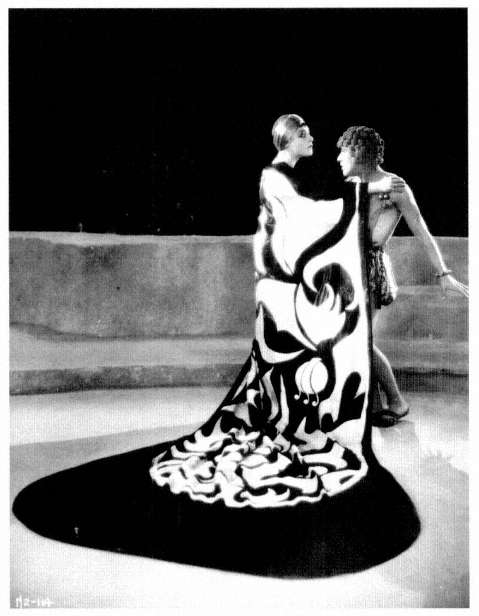
Figure 77
Alla Nazimova as Salomé and Samson DeBrier as the Page in Nazimova's Salomé (1922).
Photograph courtesy of the Academy of Motion Picture Arts and Sciences.
gestures and poses. The film was shot during 1922 in a small independent studio just a block away from the huge set for the walls of Babylon from D. W. Griffith's Intolerance (1916) that was still standing then.[2] At its December 31, 1922, premiere, both critics and audiences found Salomé a decadent, quasi-humorous curiosity, and it has remained a camp classic, its images appearing on 1960s psychedelic rock posters and contemporary greeting cards.[3]
Exactly how radical the abstraction in Nazimova's film was can be judged from comparison with the Theda Bara version of Salomé from 1918. While Bara's decor and costumes also attempt to give the flavor of Beardsley, they are hopelessly cluttered with Victorian "orientalism," and while the acting of Bara's players seems stagey, it also aspires to conventional realism—Griffith's Intolerance would supply a close parallel. By contrast, Nazimova's production boasts a spare elegance as well as fanciful extravagance that defies any specific historical reference and suggests (for example, in the cluster of white spheres that float about Nazimova's head in one scene) an abstract timelessness. In their expressionistic performances, Nazimova's actors display iconic moods rather than simulate realistic psychology.
Nazimova's Salomé is best understood in the context of the art film: on one side The Cabinet of Dr. Caligari (which premiered in Germany in February 1920, in the United States in April 1921), which adapts avant-garde stage styling to create a stunningly eccentric movie experience, credible in its own terms, and on the other side later experimental films (involving such diverse filmmakers as James Broughton, Jack Smith, Kenneth Anger, the Kuchar brothers and Andy Warhol), which use elaborate, deliberately stylized decor and acting to explore forbidden sexuality. Perhaps, then, it is no accident that Samson DeBrier, the protagonist of Kenneth Anger's 1954 film Inauguration of the Pleasure Dome , played the anguished page boy in Nazimova's Salomé , under the stage name Arthur Jasmine.
The Los Angeles painter Warren Newcombe developed a special process for using painted backgrounds in films and worked as a special effects expert, first for D. W Griffith and David O. Selznick, then at MGM, where he won an Academy Award in 1948 for his work on Green Dolphin Street .[4] In 1922 and 1923 he shot two imaginative short films, The Enchanted City and The Sea of Dreams , both of which employed the Newcombe process: all the backgrounds were paintings. The New York Times , February 6, 1922, praised The Enchanted City (Fig. 78), a futuristic fantasy, for its "impressive" camerawork, "compositions of masses and lines, expressively shaded and lighted." The reviewer complains, however, that the "fantastic story lacks vitality" and recommends that "you just look at the different scenes as you would view pictures in a gallery," because "they have a strong appeal to the eye." In the context of later experimental films (for example, those of Gregory Markopoulos or Joseph Vogel), perhaps the "story" was less important than the painterly values of images.
That these film artists established relationships with the commercial movie world is hardly surprising: 35mm filmmaking was cumbersome and expensive—and to a certain
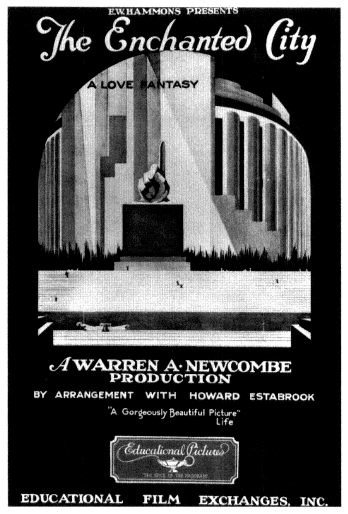
Figure 78
Original poster for Warren Newcombe's Enchanted City (1922).
Photograph courtesy of the Academy of Motion Picture Arts and Sciences.
extent kept as a trade secret by commercial enterprises—so most people would need to learn the craft professionally, and once they had demonstrated their mastery of film with an imaginative, dazzling short, they would find it hard to resist offers to work in the industry. Several artists went into commercial filmmaking after making a single experimental film: Charles Klein (The Tell-Tale Heart , 1928), Dr. Paul Fejos (The Last Moment , 1928), Charles Vidor (The Bridge , 1929).
Robert Florey and Slavko Vorkapich, the makers of perhaps the most famous American experimental film of the 1920s, The Life and Death of 9413—A Hollywood
Extra (Fig. 79a-d), also enjoyed long careers in Hollywood. Florey came to Los Angeles from France in 1921 to be a Hollywood correspondent for European film magazines but quickly became involved as an assistant in studio films.[5] Vorkapich, a Yugoslavian, was studying painting in Paris when he saw Griffith's Intolerance and decided cinema was the art form of the twentieth century; he came to Hollywood, where he worked as an extra. He eventually sold one of his oil paintings for enough money to buy a camera, which he and Florey used to make Hollywood Extra . Florey wrote, directed, and acted in the film. Vorkapich designed the models and trick effects, edited the film, and shot much of the footage, although the live actors were filmed by Gregg Toland, who would later be cameraman for Citizen Kane . The twelve-minute film, a genuine little masterpiece, cost less than one hundred dollars. Using expressionistic miniature sets and dramatic moving lighting, imaginatively combined with live-action shots of Hollywood and stylized comic acting, Florey and Vorkapich effectively convey the plight of the hundreds of people who flock to Hollywood hoping for stardom. The brilliance of Hollywood Extra lies in its use of cinematic potential, not only in blending live action with trick shots, but also in conceptualizing rhythms (the actor's repeated climb up the staircase to success, like the washerwoman loop in Ballet Mécanique ) and camera viewpoints (the low-angle shots against a black void to suggest the power of producers and critics, used again later in Citizen Kane ). The comic acting and Florey's genuinely witty, ironic touches—the absurd masks, "blah-blah-blah" as the only spoken words, the CASTING and NO CASTING TODAY signs at the gates of Heaven—linger satisfyingly in the viewer's mind.
Following the great success of Hollywood Extra in June 1928, Robert Florey quickly made two similar expressionistic shorts, Loves of Zero and Jonathan the Coffin Maker , before becoming a feature director at Universal, Warner Brothers, and Paramount. Slavko Vorkapich became one of the great Hollywood editors, creating montage
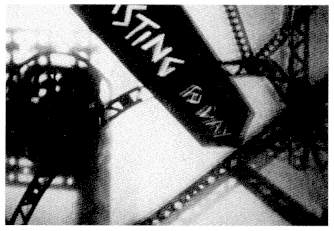
Figure 79
Above and next page: The Life and Death of 9413—A
Hollywood Extra (1928), by Robert Florey and Slavko Vorkapich:
Vorkapich's model sets; Jules Raucourt as 9413, with his
Actor's face; Waiting for the call; The death of 9413.
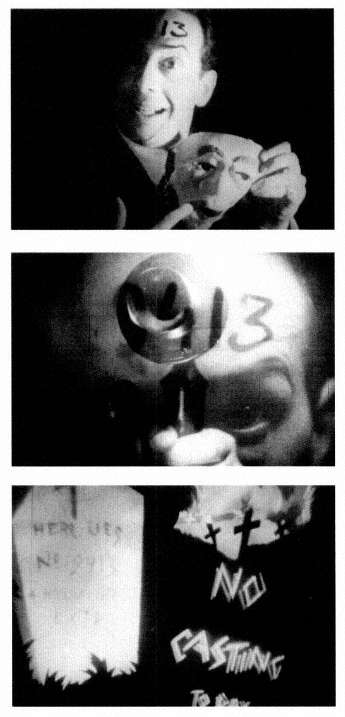
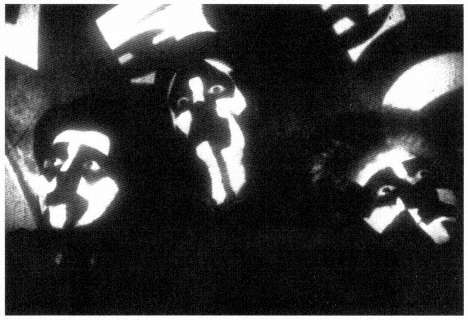
Figure 80
Boris Deutsch's Lullaby (1929): The Demons.
sequences for many MGM features. In 1940 he collaborated with John Hoffman on two experimental short films, Moods of the Sea and Forest Murmurs , which synchronized beautiful nature photography with classical music through dynamic editing. Hoffman, a Hungarian-born MGM editor responsible for such montage sequences as the famous earthquake in the 1936 film San Francisco , had also made a lyrical landscape film, Prelude to Spring . He later directed features, including the 3-D production Bwana Devil .
In the wake of the much-publicized low-budget Hollywood Extra , the painter Boris Deutsch also made a low-budget personal art film in Los Angeles. He was born in Riga, studied painting in Kiev and Berlin, and fled across Russia in 1916 to the United States, where he worked in a Hollywood studio from 1919 until 1922.[6] Although hired at first as a designer, he gradually acquired a familiarity with the whole filmmaking process that allowed him to make, early in 1929, the fifteen-minute film Lullaby (Fig. 80) privately, for less than five-hundred dollars, some of it borrowed from the Russian refugee actor Michael Visaroff, who also played the villain in the film.[7]Lullaby depicts the psychological trauma of a Jewish woman (well acted by Deutsch's wife, Riva) employed as a servant in the house of demanding and abusive Christian Russians. The servant is charged with keeping the baby quiet during a drunken party, and when she
is slow to serve at table as well (and loath to uncover her hair, following Jewish custom), she is beaten. As the tension mounts, she is seized by a momentary urge to kill the baby but flees the house instead.
Deutsch uses the moody expressionistic visuals and symbolic touches characteristic of the art film to convey the heroine's psychological state. During her crucial bout with hysterical madness, images of her face are intercut rhythmically with abstract patterns in writhing turmoil and with the faces of demons, expressionistically painted in the style of experimental Yiddish theater.[8] And as she flees her house of employment, through Deutsch's special-effects photography the twisted buildings of the village seem to weigh down on her and assume the face of her tormentor. Deutsch also develops the cinematic potential of many scenes, by intercutting the similar faces of the Virgin Mary in an icon (painted by Deutsch) and the servant, or by shooting the accordionist in some nearly abstract diagonal compositions. Unfortunately, the only known print of the film is in poor condition—even the end title is spliced on from another source, so it is not clear that the print is complete. But enough fine touches are visible to establish that Deutsch's work prefigures the "psychodramas" of California experimental film of the 1940s.
While European art film styles and techniques permeated experimental films in Los Angeles, a brilliant 1937 satire, Even as You and I (Fig. 81a-c), definitively rejected that influence—at the same time that Los Angeles painters such as Helen Lundeberg, Lorser Feitelson, and Knud Merrild, with their postsurrealist manifesto, celebrated their independence from European trends.[9] The 1936 exhibition of dada and surrealist art at New York's Museum of Modern Art splashed fantastic images across the pages of American newspapers and magazines: the newly founded Life magazine, in its fourth issue, December 14, 1936, gave it a four-page spread (with color), including Meret Oppenheim's fur teacup and Dalí's Persistence of Memory . And Time put Dalí on the cover of the December 14, 1936, issue.
Far from the world of limp watches and fur teacups, the Hollywood Film and Foto League, in a decaying mansion that provided cheap lodging, working space, and social activities for dozens of young leftist artists, sometimes screened Soviet films and promoted documentaries about poverty and workers' problems.[10] Three artists who often met there (and at the Filmarte Theatre)—the Works Progress Administration (WPA) photographers Roger Barlow and LeRoy Robbins and the agitprop actor Harry Hay—were struck by the incongruity of the surrealist fine arts juxtaposed in a magazine with an advertisement for a Pete Smith contest for the best short film, the prize for which was a trip to Hollywood. They decided to make a spoof film chronicling what might happen if innocent amateurs tried to enter a "fine art" short surrealist film in this contest. The three men play naive versions of themselves in the frame story about the contest and filmmaking, and they collaborated on episodes in the film-within-a-film, The Afternoon of a Rubber Band , a pungent send-up of avant-garde clichés, including balloon heads from René Clair's Entr'acte , pistol games from Hans Richter's Ghosts
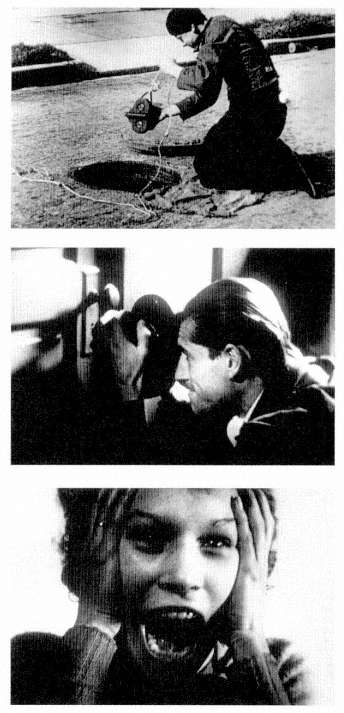
Figure 81
Even as You and L by LeRoy Robbins, Roger Barlow, and Harry
Hay (1937): Harry Hay lowering his camera down a manhole;
Roger Barlow shooting through a keyhole; the terrified observer.
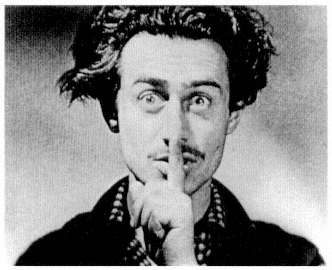
Figure 82
Even as You and I : Hy Hirsh as the Idiot Savant.
before Noon , and the rival editing theories of G. W. Pabst (the cannibalization of a baby implied by clever cutting together of many brief shots) and Sergei Eisenstein (a steam-roller running over a snail puffed into an epic confrontation through paced intercutting of actions and reactions).
In the film another friend of theirs, Hy Hirsh (a cameraman and still photographer who had been working in the Hollywood studios; he would have a distinguished career as an experimental filmmaker in the 1950s), played the role of a grinning idiot savant who periodically admonishes the audience to be quiet (Fig. 82)—a bit they had seen in one of the Soviet films that played frequently in Los Angeles. The hilarious satire in Even as You and I contains a serious implication: that the European masters like Salvador Dalí and Luis Buñuel may have "done it all," leaving no room for fresh experiments, aside from parody.
Harry Hay and LeRoy Robbins, however, collaborated in 1938 on a second film, Suicide , in which Hay played an emotionally tortured actor who, confusing his own emotions with those of various characters he has played, contemplates killing himself. Hay recalls that some of the shots were single long takes in which he had to portray several different thoughts and feelings overtaking the actor. Other scenes showed him in the makeup and costumes of stage roles, but he is not sure how they were blended, since he was in New York when the film was completed and did not see it projected. Perhaps in making Suicide , Hay and Robbins found a fresh formula for expressing this personal psychological drama, and thus showed a way out of the Los Angeles
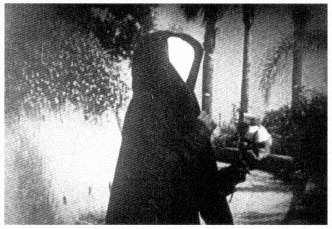
Figure 83
Meshes of the Afternoon , by Maya Deren and Alexander
Hammid (1943): Florence Pierce as the Nun with the mirror face.
experimental film's aesthetic cul-de-sac. But unfortunately, all copies of the film may be lost.
Lacking copies of Hay and Robbins's Suicide , we must credit another artist with finding the way out of the cul-de-sac: a remarkable woman named Maya Deren, who was born in Russia but came to Syracuse, New York, at age five when her psychiatrist father took a job there.[11] In the 1930s, after graduating from the University of Syracuse, she became deeply involved in leftist politics, married and divorced, and then became interested in anthropology. A fascination with the mythic/ritual aspects of human behavior led her to Haitian Vodoun as a living religion and to Katherine Dunham's black dance troupe, which incorporated traditional rituals into their art (Dunham had done her master's thesis on Haitian Vodoun and dance).[12] Deren traveled with the dancers in 1941, when the troupe moved from New York to Los Angeles, where, at a party given by the art dealer Galka Scheyer, she met a Czech immigrant filmmaker, Alexander Hammid (originally Hackenschmied), whom she married in 1942. Hammid had been active in experimental filmmaking in Prague around 1930 and had made a subtle and fascinating film, Aimless Walk , which followed a young man who wants to get out of the city for an afternoon. At each point when he equivocates about going farther, he splits into two figures, one of which goes on while the other observes and turns back.
Although the refugee Hammid had no print of this film to show, his enthusiasm for personal, imaginative filmmaking encouraged Maya Deren to undertake a film that in many ways is similar: Meshes of the Afternoon , which bears the title card "Hollywood 1943." Meshes visualizes the feelings and thoughts of a young woman (played stunningly by Deren herself) who at a turning point in her life and relationships pursues a mysterious nun with a mirror hiding her face (played by the New Mexico painter Florence Pierce; Fig. 83). We see the protagonist as three different women performing the same
everyday actions, and each time a sequence recurs, we become more sensitive to the mythic/ritual aspects of these simple deeds and objects. The three women differ in essential ways: one is so light that she seems to float upstairs, another is so heavy that she moves in lugubrious slow motion, and the third is so inept or imbalanced that she staggers intermittently.
While Meshes uses the camera tricks, dramatic lighting, and symbolic gestures of the European avant-garde and refers overtly to the surrealist Freudianism of films like Cocteau's Blood of a Poet and Dalí-Buñuel's Chien Andalou , Deren and Hammid manage to surpass their European prototypes in both technical excellence (their camerawork and editing are brilliant) and conceptual ingenuity, for Deren achieves true ambiguity and moodiness that continually suggest more—approximating Jung's quasi-mystical theory of the archetype rather than the simplistic Freudian symbolism of the surrealists.
After finishing Meshes , Deren returned to New York, where she created two films, At Land and Ritual in Transfigured Time , that form a trilogy with Meshes . She also made three other films, wrote numerous articles about film as an art form, toured tirelessly with her films, and helped to establish a circuit of distribution and exhibition for experimental short films.
Deren's work in Los Angeles had dynamic repercussions, for she encouraged several young men there, including Kenneth Anger, Curtis Harrington, and Gregory Markopoulos, who had been toying with "amateur" film and vaguely hoping for careers as directors in Hollywood, to begin making 16mm experimental films that were artworks in and of themselves. Anger's Fireworks (1947), Harrington's Fragment of Seeking (1946) and On the Edge (1949), and Markopoulos's Psyche (1948) all treated aspects of homosexuality in a frank yet lyrical fashion that exposed experiences of both terror and beauty. In the manner of Maya Deren, they all made imaginative use of cinematic devices to suggest a surreal dream world. And each man played the protagonist in his own "psychodramas," as this type of film came to be known.
All three filmmakers enjoyed international acclaim for their uncompromising, experimental work—an alternative version of "Hollywood" that was poetic and imaginative, honest and uncensored. Anger and Markopoulos would both make experimental film their life's work, but after a half-dozen successful shorts, Curtis Harrington became an independent Hollywood feature director with such distinguished credits as Night Tide, Games , and What's the Matter with Helen? Harrington's features brought to seemingly conventional genre films touches of surrealistic irony and bizarre juxtaposition—astonishing, vivid images that confront a mass audience with an uncanny, unexpected mirror image of themselves rather than superheroes, ravishing beauties, and grotesque villains.
One of the finest artistic achievements of modernist California, the cultivation of the preeminent school of "visual music," developed at the same time as live-action experi-
mental film. Indeed, visual music has a history that parallels that of cinema itself. For centuries artists and philosophers theorized that there should be a visual art form as subtle, supple, and dynamic as auditory music—an abstract art form, since auditory music is basically an art of abstract sounds. As early as 1730, the Jesuit priest Father Louis-Bertrand Castel invented an Ocular Harpsichord, which linked each note on the keyboard with a corresponding flash of colored light.[13] Many other mechanical light-projection inventions followed, but none could capture the nuanced fluidity of auditory music, since light cannot be modulated as easily as "air." The best instrument for modulating light took the form of the motion picture projector.
In any case, the movie industry provided a major reason for the growth and flourishing of visual music in Los Angeles. Movie musicals, especially those lavish semi-abstract Busby Berkeley numbers,[14] are a form of visual music, and the industry supplies ready access to technology. Furthermore, during the 1930s and 1940s a plethora of talent passed through or settled in Los Angeles in hopes of gleaning some benefits, contacts, or fulfillment from the boomtown. The rise of fascism in Europe quickened the influx of artists.
It may be hard for us to imagine the immigrant artist community of those decades. In March 1939 Paul Hindemith played as guest violist with the Los Angeles Philharmonic Orchestra under the baton of regular conductor Otto Klemperer. After the performance a lively crowd assembled backstage, including such famous figures as the movie director William Dieterle, the composers Ernst Toch and Arnold Schoenberg, the novelists Vicki Baum and Thomas Mann, and a dozen more, all merrily chatting in German. Suddenly Klemperer cried out (in German), "Are we, then, actually in Berlin, not in Hollywood?" Also present at this historic occasion was one of Hindemith's best friends, Oskar Fischinger (Fig. 84), the foremost influence on the development of visual music in California.
Born in Germany in 1900, Fischinger began making abstract films in Frankfurt in 1922, and by 1926 he was performing multiple-projection "light shows" in his Munich studio.[15] In the late 1920s, he began sychronizing nonobjective imagery to popular records; the resulting films were shown in theaters as advertisements for the records—the first music videos. After a successful series of sixteen of these black-and-white Studies (some were screened in the United States as well as in Japan and South America), he made the first full-spectrum color films in Europe: Circles (1933) and Composition in Blue (1935). At the same time, he also produced the famous walking cigarette commercial, which was copied internationally. He was able to immigrate to Hollywood in 1936 under contract to Paramount (for Allegretto , released in 1943) and in 1937 produced for MGM the abstract film An Optical Poem , which was distributed as a short in theaters everywhere. In fall of 1938, Fischinger was hired to design and animate portions of Disney's Fantasia , and his films were screened weekly for a year to the entire staff of Disney Studios, where they made a lasting impression.[16] Although Fischinger quit Disney after a year because staff committees changed all his designs and ideas, his touch
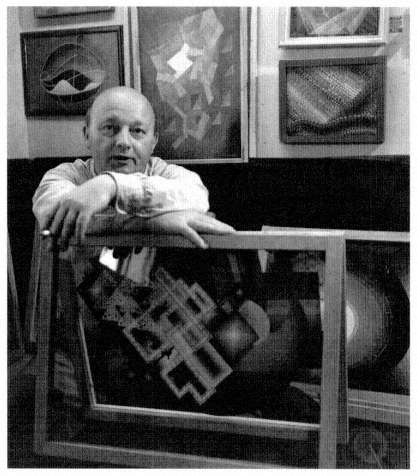
Figure 84
Oskar Fischinger with the original paintings for the film
Motion Painting No. 1 , 1949. Photograph by William G. Hewitt, Jr.
is still visible in the opening Bach episode of Fantasia . Examples of Fischinger's work were thus shown to a broad American public.
Fischinger himself, however, found it difficult to work in the factory environment of the studio, and he encountered even more difficulty raising money for independent film projects, so he turned increasingly to easel painting as an outlet for his creative energy. In Germany he had purposely refused to paint since he believed that kinetic abstraction—visual music—would be the art of the future. But he did not begin oil painting as a novice, for he had made thousands of paintings as the basis of his anima-
tion films, many of which prefigure the serial work of artists like Josef Albers and Frank Stella. Fischinger also knew many painters from Germany—including great artists like László Moholy-Nagy and Lyonel Feininger and the not-so-great artist Rudolf Bauer. (The art dealer Karl Nierendorf, a good friend of Fischinger's, took him to visit the pompous Batter's studio, named Das Geistreich, "Realm of the Spirit," near Berlin, and they shared a good laugh on the way home.)
In 1938 Fischinger was invited to New York for two one-man shows of his intricate, layered oil paintings (at the Boyer and Nierendorf galleries) and a film screening at the Fifth Avenue Playhouse. In New York he met Baroness Hilla Rebay yon Ehrenwiesen, curator of the Solomon Guggenheim Foundation and founder of the Museum of Non-Objective Painting (now the Guggenheim Museum). During the difficult war years (Fischinger was still an "enemy alien" and so could not work in any media-related job) Rebay helped support Fischinger both by giving him grants and by purchasing his films. Screened regularly at the museum, these films were seen by a whole range of future New York School abstract painters—not least among them Jackson Pollock, who was employed there. A number of Fischinger's canvases were also exhibited at the museum. But his relationship with Rebay was tortured, to say the least, and he suffered mental anguish at her teasing, tantrums, and insults as often as he gained peace enough to work.[17]
On his meager income Fischinger finished two more film masterpieces: Radio Dynamics and Motion Painting No. 1 (Fig. 85). Radio Dynamics , an intentionally silent film meant as a contemplative, meditational aid, contains both hypnotically pulsating mandalas and brilliantly flickering single-frame images. As the title implies, Motion Painting records the growth of a specific oil painting, with one frame of film shot each time a brush stroke was made. The film is distinguished not only for this novel idea but also for the intrinsic fascination of the developing design, which moves through soft amorphous shapes to hard-edge geometric forms and culminates in a serene, irresistible mandala. Although Motion Painting won the grand prize at the International Experimental Film Festival at Brussels in 1949, Rebay failed to understand its dynamic structure or even its innovative documentation of a painter's working process and gesture. She simply hated the film and refused to extend Fischinger any further aid. Discouraged, and unable to obtain financial backing from other sources, Fischinger withdrew from active film production.
As much as Fischinger was harassed and denigrated by Rebay's tirades, he was sustained and encouraged by the remarkable Galka Scheyer, who allowed him to study the superb Klees, Kandinskys, and other abstract paintings that passed through her hands—and made sure he had full access to other caches of abstract art in Los Angeles: the magnificent collection of the Arensbergs (now in Philadelphia) as well as those of Ruth Maitland, Merle Armitage, Marjorie Eaton, and others. She also sent younger artists to visit Fischinger, including the fledgling John Cage, who credits Fischinger with crucial formative influence on his conceptual music theory.[18]
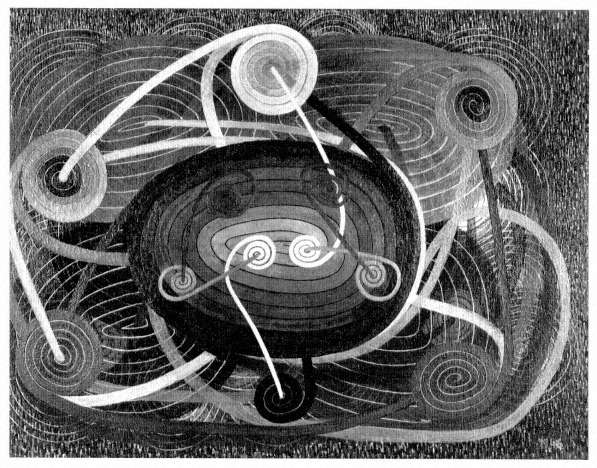
Figure 85
Oskar Fischinger, Motion Painting No. 1 , 1947.
Fischinger's films also screened regularly in Los Angeles—at the Art Center School, Otis Art Institute, and Chouinard Art Institute, the three best art colleges in the area, where Lorser Feitelson, Helen Lundeberg, Helen Wurdeman, the ceramist Al King, and the photographer Frank Judson sponsored Fischinger and became devoted friends.[19] Between 1946 and 1950 Al King also screened Fischinger's films at the California Color Society, where other painters fell under Fischinger's spell, among them the movie star Harold Lloyd, whose 1953 exhibition of "Landscapades" at the Frank Perls Gallery showed a marked turn toward abstraction.[20] Fischinger also exhibited at the Stendahl Art Galleries and the American Contemporary Gallery, among others.
At the Stendahl show in the fall of 1939, the Whitney brothers encountered Fischinger's work.[21] James (then eighteen) and John (twenty-two) had just returned from Europe, where they were extending their studies in painting and music, respectively. John (like John Cage) had attended the Claremont Colleges, and in Paris John Whitney had met René Leibowitz, who introduced him to the twelve-tone principles of Arnold Schoenberg (who, ironically, had been teaching at the University of Southern California since 1934). Although John Whitney never studied directly with Schoenberg himself, the composer's progressive theories fascinated both the brothers, who in their first eight films offered visual equivalents of his tone rows and permutations. Their first four films, shot in 8mm, were made in their studio in Pasadena from 1940 to 1942. These lovely silent works are astonishingly accomplished for first films by young men. They have the vigor and delicacy of fine chamber music, and perhaps their maturity stems in part from the Schoenbergian rigor they chose for their exemplar and process.
Although the brothers had been inspired by Fischinger to make films, they were somewhat bothered by the tight relationship between known music and the visual imagery in Fischinger's films—something that bothered Fischinger as well. His early films, from the 1920s, were either silent or had new music composed for them. He became involved with tight synchronization partly because of his commercial ties with record advertising and partly because he found that audiences would more easily accept abstract visual art if it were linked to known music (abstract auditory art) they already approved of. After the international success of Fischinger's synchronized films producers, distributors, and audiences demanded more. But Fischinger longed to have his visual music appreciated as art separate from (albeit equivalent to) auditory music, and from 1941 to 1943, worked on an intentionally silent masterpiece, Radio Dynamics . Moreover, although Rebay's commission for the 1947 Motion Painting specified that it should be synchronized with Bach's Brandenburg Concerto no. 3, Fischinger constructed the visual imagery as a loose parallel, with no note-for-note correspondence, and often screened the film as a silent movie. It is unfortunate and ironic that the Whitney brothers were too polite to discuss synchronization with Fischinger, who might have found such an aesthetic debate beneficial and encouraging.
The Whitney brothers proved with their 8mm Variations that they could compose successful silent visual music, and in the last film of this series, Variations on a Circle (1942), James Whitney showed that he could create a little masterpiece comparable to Radio Dynamics .
John Whitney's memorable contact with René Leibowitz made him long to compose auditory music as novel as their visual imagery. He invented a system of pendulums that could be calibrated to draw directly on the soundtrack area of the film precise oscillations that would play back as pure tones (Fig. 86). With this system the Whitneys could compose music and abstract visual imagery simultaneously. During 1943 and 1944, John made Film Exercise No. 1 and Film Exercise No. 5 , while James made Film Exercises Nos. 2 and 3 and No. 4 , which combined pendulum music with geometric
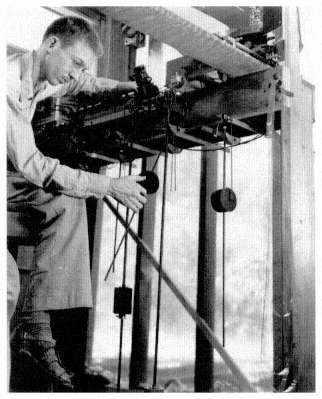
Figure 86
James Whitney composing music with the Sound
Pendulum system. Photograph by Lou Jacobs, Jr.
shapes cut out of paper matte boards so that the camera could film, from the resultant openings, pure light rather than reflections of a drawn artwork. The effect was shocking and "electrifying": the visual imagery had the eerie glow of neon lights, and the sound introduced many ears to the pure sine waves, aggressive tonal attacks, and the extravagant range of sound placements and seamless glissandi that a decade later would become familiar as electronic music. With these pioneer electronic sound scores of their own composition, they also won a first prize at the Brussels Festival in 1949.
While working on the Exercises , the brothers visited the Frank Lloyd Wright buildings designed for Aline Barnsdall on Olive Hill in Hollywood. The photographer Edmund Teske, an artist-in-residence at a guest cottage there, had already met them at a screening in the American Contemporary Gallery, and he encouraged them to join him as artists-in-residence, since other cottages were available. In this central location,
they quickly became artistic celebrities, since the buildings attracted such neighbors as Man Ray and the sculptor Tony Smith, who instantly recognized the extraordinary quality of the young men's work and became frequent visitors and friends, as well as such casual, curious visitors as Bertolt Brecht. James Whitney's and Teske's fascination with spiritual disciplines brought them to the Vedanta Center, where they became friends with the British expatriates Christopher Isherwood, Gerald Heard, and Aldous Huxley. Their Olive Hill salon also served as a screening place for such experimental filmmakers as Maya Deren, Curtis Harrington, and Kenneth Anger.
In 1944, with the Exercises completed, James traveled to New York to see if Baroness Rebay might also include their work in the Guggenheim collection and possibly fund a new film. Rebay did purchase prints of the Exercises , and both the 8mm Variations and the 16mm Exercises were screened several times in New York during 1944 and early 1945. James's first audience included such old friends as Tony Smith, John Cage, and Sidney and Harriet Janis, as well as such diverse celebrities as Tennessee Williams and Marcel Duchamp—luckily, since as soon as Film Exercise No. 1 began, the Baroness flew from the room screaming "What's wrong with the projector?" and forced the projectionist to shut off the film, and the showing resumed only when the distinguished audience intervened. Jackson Pollock (a drinking buddy of Tony Smith's) was at this screening, and the Guggenheim prints of the Whitney films were shown regularly at the museum thereafter, so they were, like Fischinger's films, accessible to the future New York School abstract painters, who would have appreciated their aggressive colors and action as well as their uncompromising sound.
Although Baroness Rebay offered to continue the Whitneys' stipend, they found her manner and aesthetic opinions oppressive and declined it. Charles Dockum, on the other hand, like Fischinger, had no recourse but to endure Rebay's foibles, since he absolutely needed the Guggenheim support to continue his work. Born in Texas in 1904, Dockum was forced to move to Prescott, Arizona, after college, because of his delicate health. There, in 1935, he constructed his first small color organ, a seminal version of his later MobilColor Projectors. And there he met (through the photographer Fred Sommer) the man who became a lifelong friend and artistic influence: the Ukrainian-born painter and sculptor Peter Krasnow, who had lived in Los Angeles since 1922. Krasnow introduced Dockum to Galka Scheyer after Dockum moved to Los Angeles in 1940. With an improved MobilColor Projector, Dockum performed at the California Institute of Technology and the Pasadena Playhouse (where the Whitney brothers and Sara Kathryn Arledge met him), as well as at the Art Center School and the University of Southern California, where Frank Judson, a friend of Krasnow's, was head of the Cinema Department (where Gregory Markopoulos and Curtis Harrington studied).
In February 1942 Dockum wrote the Guggenheim Foundation, requesting a grant to prepare a more complex and effective MobilColor Projector.[22] At first Rebay was reluctant. Thomas Wilfred, an older and more established color-organ artist, had attempted to interest her in one of his instruments, but she had not liked it because she
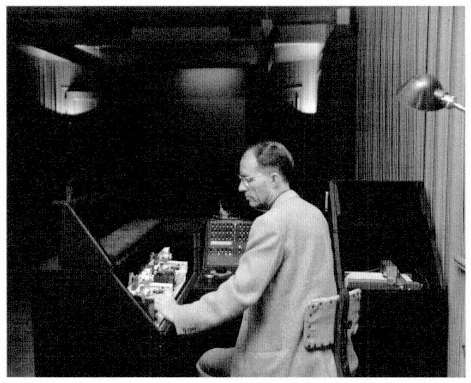
Figure 87
Charles Dockum playing his Guggenheim MobilColor Projector for the last time,
in 1953, at the Guggenheim Museum of Non-Objective Painting, New York.
felt the soft polymorphous flow of Wilfred's subtly nuanced imagery was not precise and controlled like the hard-edge geometric paintings of her favorite painter, Rudolf Bauer. Although Wilfred explained that he did carefully design the imagery and could program both his clavilux projectors and his internal projection Lumia boxes to repeat exact compositions, Rebay wanted none of his sensuous delicacy. Fortunately for Dockum, Rebay's arch-rival, the Museum of Modern Art, purchased one of Wilfred's major Lumia compositions for permanent display in their galleries, thus piquing the baroness's urge to possess a color organ. She paid for Dockum to bring his MobilColor Projector to New York, where he spent the month of June 1942. Rebay reported that an audience of "expert" painters and filmmakers was "enchanted" by one of his performances—so again Dockum's work may have been seen by Jackson Pollock and the New York School.
Rebay awarded Dockum a stipend to build a MobilColor Projector for permanent installation at the Museum of Non-Objective Painting (Fig. 87). But with her he fell
into the same depressing turmoil Fischinger and the Whitneys had experienced. She asked him several times to spy on Fischinger to find out if he was really working on the Bach Brandenburg Concerto project. The two artists became friends, although Fischinger adamantly refused to let Dockum into his studio. (He was in fact having trouble with the Bach project and was not working on it every day.) In September 1942, when Dockum tried to interest Rebay in the abstract sculpture of Peter Krasnow, she haughtily replied that she and "several very great artists" did not like his work at all. She informed him that sculpture was a second-rate art form anyway, and he should not really associate with an "average" person like Krasnow, but rather strive to "impress a master like Bauer."
Rebay also monopolized much of Dockum's time, having him write letters and perform other useless tasks. She had him spend considerable time drawing up elaborate plans for Frank Lloyd Wright to incorporate into the new museum building, but Dockum's suggestions were never used. Fischinger had similarly been charged with designing film projection rooms and studio spaces where animators could work, but none were ever built; Fischinger's demand for projection onto an overhead dome, however, contributed to the final shape of the museum building, even though fire regulations prohibited the ground-floor horizontal projection booth that would have allowed films to be screened on the dome.
Dockum's Guggenheim episode has a more tragic ending than that of either the Whitneys or Fischinger. Dockum spent the ten prime creative years of his life constructing the Guggnheim MobilColor Projector and composing a series of pieces to be played on it. When the museum directors found that the instrument would not really play continuously without supervision, they determined that it could not be exhibited and should be dismantled. Some of the lighting elements were used for track lighting in the galleries; other parts were donated to Yale University. The instrument legally belonged to them, so Dockum could do nothing—but his compositions, created specifically for that mechanism, could be played on no other and thus were useless, "destroyed."
Ted Nemeth and Mary Ellen Bute, who had produced a series of abstract films in New York beginning in the mid-1930s, attempted to film the Dockum compositions once before the instrument was dismantled. Part of Dockum's artistry, his very reason for working with a color organ rather than film, involved the subtle modulation of color from nearly invisible hints to blinding, saturated intensities; he also layered colors, playing upon the resulting push-pull effects and optical mixtures. These subtle details could hardly be captured on film, especially since the light needed for a good film exposure can exceed what seems dazzlingly saturated during a live performance in a darkened room because of the complicity of the spectator's eye. The Bute-Nemeth documentary, even if much of the color and nuance are lost, nonetheless shows that Dockum's MobilColor compositions involved simultaneous movement in three different directions, and an effective precision in the layering.
Back in his studio in Altadena (the suburb of Los Angeles where James Whitney was born), Dockum set about building another MobilColor Projector, but at the time of his death in 1977, he had composed only three pieces, a total of some fifteen minutes' playing time, for his new instrument. The serene luminous beauty of these works cannot be seen without a twinge of regret for the art that the art world fails to support.
The end of World War II brought a flurry of activity to the experimental film and visual music scene—so much so that an official MGM Studio memo to Jean Hersholt, dated May 14, 1946, lists three venues for art cinema in Los Angeles: the American Contemporary Gallery, the Great Film Society, and Paul Ballard's Film Society.[23] Within a year there would be two more—Creative Film Associates (run by Curtis Harrington and Kenneth Anger) and the Experimental Film Society (where Maya Deren and Sasha Hammid appeared for a screening of their films April 13, 1947)—and then three more: the Society of Cinema Arts (1948), Bob Chatterton's Film Society, and Raymond Rohauer's Film Society, which in 1950 would take over the Coronet Theatre (where Stan Brakhage, later famous as an experimental filmmaker, worked as projectionist) and in 1957 the Riviera/Capri Theatre, both as cinemas showing a repertory of experimental and art films.
The first experimental film made in San Francisco was probably The Potted Psalm , a surrealistic comedy made in collaboration by two writers, James Broughton and Sidney Peterson, who in 1946 were suffering from writer's block and turned to cinema as a recourse.[24] Their film premiered as the finale to Frank Stauffacher's first experimental film series at the San Francisco Museum of Art.
Stauffacher's series of Art in Cinema festivals began in October 1946 and continued through a sixth series, in 1950.[25] When the initial series brought the Whitney brothers and Oskar Fischinger to San Francisco, two young painters, Jordan Belson and Harry Smith, were inspired to begin abstract filmmaking, and their subsequent distinguished careers helped to confirm the existence of a California school of visual music (which itself engendered a number of minor filmmakers such as Robert Howard, Hal McCormick, Elwood Decker, Ralph Luce, Leonard Tregillus, Dorsey Alexander, Martin Metal, Denver Sutton, and Curtis Opliger). Stauffacher had sent Harry Smith to Los Angeles to talk Fischinger and the Whitneys into coming to San Francisco for the first Art in Cinema, and Smith was so smitten with their work that he began to make his own. He drew directly on film stock since he did not have a camera, animation stand, or optical printer. His first five films, all hand-drawn (they include some footage Smith shot with Hy Hirsh's camera moving quickly past lights at nighttime), were closely allied to the new bop music; they premiered at subsequent Art in Cinema festivals, accompanied by live jazz ensembles. Smith painted large abstract murals at the nightclub Bop City (Fig. 88) and screened his film there as a "light show" accompanying such musicians as Dizzy Gillespie and Thelonius Monk. Jordan Belson has withdrawn his earliest films from the 1940s, which were greatly admired at that time;
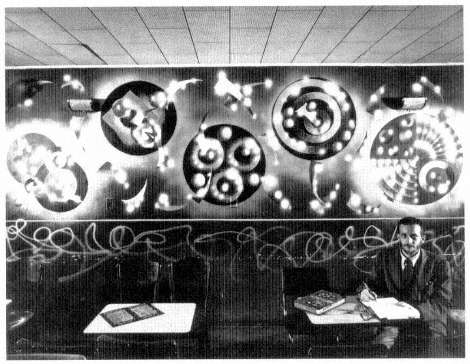
Figure 88
Harry Smith, in front of his abstract murals at Bop City jazz nightclub, San
Francisco, ca. 1949. Photograph by Hy Hirsh, courtesy Jordan Belson.
Fischinger, after seeing his first film, Transmutation , at Art in Cinema, recommended Belson for a Guggenheim Fellowship. After his spectacular Vortex Concerts of the late 1950s, which sychronized electronic music with abstract imagery projected on a planetarium dome, and after seeing some of Wilfred's sensuous Lumia compositions, Belson became more sophisticated in his films, which as a result better expressed his spiritual aims.
Similarly, Maya Deren's trilogy, shown at Art in Cinema, inspired a raft of new film psychodramas. In Northern California, Sidney Peterson and James Broughton continued their filmmaking separately and began to offer an experimental filmmaking course at the California School of Fine Arts (now the San Francisco Art Institute). James Broughton's Mother's Day (1948) was particularly successful, capturing the ironic ambiguity of the adult's nostalgic remembrance of his childhood and the sexual-social politics foisted upon children that mark them for life.[26] Hy Hirsh worked on some psychodramas (Horror Dream and Clinic of Stumble , both in collaboration with Sidney
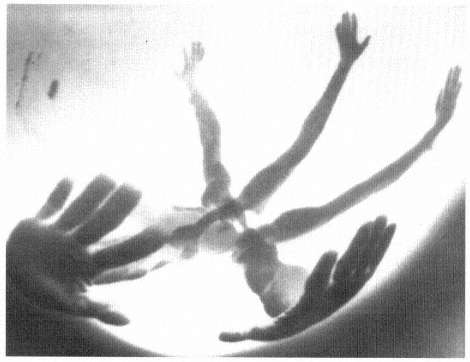
Figure 89
Sara Kathryn Arledge's Introspection (1941 and 1946).
Peterson) before turning to visual music after 1950, and Chester Kessler prepared a remarkable quasi-animated version of Kenneth Patchen's Journal of Albion Moonlight , entitled Plague Summer . Nor were all the new films psychodramas. Frank Stauffacher, for example, produced three fine lyrical landscape films (or city symphonies, as such films were called by the German experimental filmmaker Walther Ruttmann): Sausalito, Zig Zag , and Notes on the Port of St. Francis . In Southern California, in addition to work by Kenneth Anger, Curtis Harrington, and Gregory Markopoulos, the painter Joseph Vogel in 1947 made All the News and House of Cards , for which the Whitney brothers optically printed his paintings as the background for a "psychodancer."
In 1941 in Pasadena (where the Whitney brothers worked) Sara Kathryn Arledge had begun an abstract dance film, Introspection (Fig. 89), which involved dancers in black tights with only one body part in color so that against a black background it seemed as if arms or torsos or clusters of superimposed legs had taken on a life of their own and could dance unconstrained by gravity. Unfortunately, her lead dancer, Jim
Mitchell, was drafted into World War II, so she abandoned the project. Living in San Francisco in 1947, Arledge was reinspired by Art in Cinema, and she finished the film, which premiered May 2, 1947, during the second series. In the summer of 1947 she also published a key essay, "The Experimental Film: A New Art in Transition," which treats Fischinger, the Whitney brothers, Maya Deren, and Charles Dockum in the context of the earlier avant-garde film.[27] The program notes to the first series of Art in Cinema, including invaluable statements by Deren, Fischinger, and the Whitneys, were also published as a catalogue by the San Francisco Museum of Art in 1947.[28] In the same year, the film historian Lewis Jacobs also published "Experimental Cinema in America" in the new journal Hollywood Quarterly (now Film Quarterly ).[29] a new American experimental film movement, heavily based in California, had come of age and would flourish during the coming decades in the work of Christopher Maclaine, Larry Jordan, Bruce Conner, Bruce Baillie and Canyon Cinema, Gunvor Nelson, Robert Nelson, Chick Strand, Pat O'Neill, and many others.
California experimental film and visual music clearly inspired new underground, independent, personal, and/or avant-garde work in film in both New York and Europe. But another influence, which I have already alluded to, may link New York abstract expressionist gestural painting to Southern California. Jackson Pollock first studied art at Manual Arts High School in Los Angeles, 1928-30. His teacher there, Frederick Schwankovsky, had a powerful mystically oriented personality, which displayed itself in frequent lectures, radio broadcasts, newspaper articles, and exhibitions in Los Angeles.[30]
Schwankovsky's devotion to Theosophy and Krishnamurti formed an integral part of his artwork and his teaching. In his brilliant painting Modern Music (Fig. 90), from about 1914, we can see a relationship with the hermetic color-music theories of other theosophically inspired painters (e.g., František Kupka, in his Piano Keys—Lake , 1909). But even a novice, with no knowledge of that tradition—like Pollock, perhaps, when he saw the painting (it remained in Schwankovsky's possession until 1940)—can appreciate the sense of dynamic color expressing inner perceptions and emotions. The woman playing the piano while pentangles of color arise from the keys might well be Schwankovsky's wife, Nelly, who would play certain notes on the piano while "Schwanny" (as Pollock affectionately called him) would paint the corresponding colors, a living visual music performance.
Schwankovsky published a booklet, which he distributed to his students, explaining the mystical qualities of colors and the correspondences between colors, musical notes, emotional propensities, and astrological signs.[31] He generously introduced his students to as much mystical theory as possible: he drove Pollock to Ojai to hear Krishnamurti speak and took groups of students to visit Manly P. Hall's Philosophical Research Society library of rare hermetic incunabula and grimoires. At the same time, Schwankovsky introduced his students to a variety of art techniques, encouraging experiments mixing oils, water, and alcohol. And in his scenic design classes, which built sets for local theatrical productions, he taught the students (including Pollock) to lay canvas on
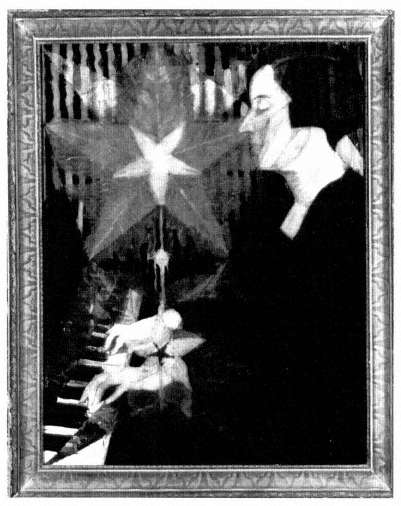
Figure 90
Frederick Schwankovsky, Modern Music ,
ca. 1914. Oil on canvas, 26 × 20¼ in. Laguna Art Museum,
gift of the artist, 1940.
the ground and dance around it, dripping and splattering paint to create starscapes and tropical lianas.
What Pollock learned from Schwankovsky in California made him see things differently in New York. During the early 1930s, while Pollock studied at the Art Students League, he often went to visit Thomas Wilfred's studio (named Institute of Light), where he sat for hours watching the gradual trajectories of colored light in Wilfred's Lumia compositions, swinging his head around to follow as if he recognized the tra-
jectories as Wilfred's gestures. In 1943, when he was working for Baroness Rebay at the Museum of Non-Objective Painting, he saw the Fischinger films, which were screened regularly, and probably Dockum's MobilColor Projections as well. When James Whitney had screenings at the museum in late 1944 and early 1945, Tony Smith (who before leaving Los Angeles had done some remarkable poured and dripped paintings, possibly in rapport with Knud Merrild's flux paintings) took his new buddy Pollock to see them. These repeated, reinforcing exposures to the kinetic abstraction of visual music (mostly from California), in which gestures of light splash, ooze, and layer across the large screen, must have contributed to Jackson Pollock's crucial change from semirepresentational easel painting to large nonobjective canvases created by expressionistic gestures of the painter.
California visual music influenced a number of other artists. Oskar Fischinger, for example, inspired the sculptor Harry Bertoia to make sounding brasses—abstract sculptures with movable parts that create musical sounds when they touch—which he would assemble in a large space and play symphonically by dancing among them to set off various harmonious patterns. And visual music covertly reached a mass audience in the form of United Productions of America (UPA) cartoons.[32] UPA was founded in the mid-1940s largely by artists who had worked for Disney on Fantasia and thus had been "indoctrinated" by Fischinger's work at the studio. Some of these artists shared Fischinger's interest in abstract painting—Herb Klynn, Jules Engel, and Fischinger, for example, had a three-man show together at the American Contemporary Gallery in 1947. The artists formed UPA as a cooperative animation studio with the express purpose of making films that would combine modern art, contemporary literature, and new music. In 1948 they received their first Academy Award nomination, and in 1950, when Gerald McBoing Boing , with art direction by Jules Engel, won an Academy Award, UPA was world famous for modernist animation presented in a visual and auditory style that expressed the subject matter at hand, whether it was children's stories or classic literature (The Tell-Tale Heart ), social satire ( The Jaywalker, Fudged Budget ), contemporary art (two films about abstract expressionism, Blues Pattern and Performing Painter , animated by John Whitney in collaboration with Fred Crippen and the Oscar winner Ernie Pintoff), or biographies of famous artists (Sharaku, Raoul Duly , and Henri Rousseau , all written by Sidney Peterson). Much of the worldwide flourishing of artistic animation in the 1950s and 1960s owes a debt to the modernist strivings of UPA, which in turn derived from visual music and film-as-an-art in California before 1950.
Modernist Photography and the Group f.64
Therese Thau Heyman
In California, modernism gained its first impetus among groups of like-minded artists who gathered to propound their ideas. Traveling exhibitions, publications, and catalogues kept the relatively remote Californians in touch with advanced art ideas from Europe. Among artists, photographers were at the fore in shaping the state's distinctively modern image. This fact will surprise no one who has taken time to consider the essential modernism of photography as a medium, or has taken the opportunity to reflect on the close association of the medium with this particular place. Photography played a decisive role in California culture beginning in the Gold Rush days, and it has continued to do so throughout the twentieth century. Still, the history of photography in the United States underwent a transformation in the early 1930s, and this change was recognized and named by a group of California photographers who sought a new, essentially modernist, perspective through their art.
John Paul Edwards, a pictorialist photographer in the thirties, recalled the spirit of change that distinguished these years: "It was in August 1932 that a group of photographic purists met informally in a fellow-worker's studio for a discussion of the modern movement in photography."[1] For Edwards and his colleagues, like Edward Weston, modernist ideas, although intriguing, were identified mainly with fine arts issues that related to other media. Debates about modernist painting, for example, tended to revolve around representational issues of clear, flat color and the picture plane. By contrast, photographers saw reality as palpably modern. Still-life objects appeared architectural, even heroic, in scale.
The New Deal, Reporting, and Straight Photography
In late 1932, even before Franklin D. Roosevelt assumed the presidency, advisers were framing programs to lift the country out of the debilitating economic depression. The New Deal, promised during Roosevelt's campaign, represented a new philosophy of
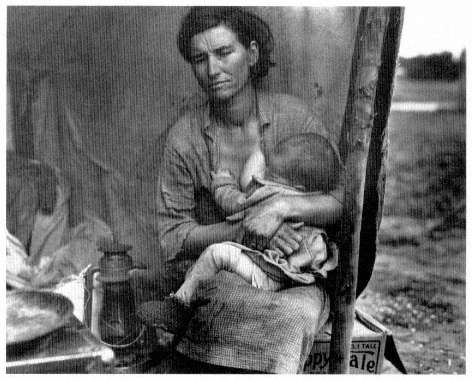
Figure 91
Dorothea Lange, Migrant Mother, Nipomo, California , 1936. Courtesy
The Oakland Museum, Dorothea Lange Collection, gift of Paul S. Taylor.
government and drew the administration directly into the theoretical and aesthetic preserve of contemporary life. An important step toward ending the economic decline was the creation of agencies to assist thousands of displaced workers and rural families.
To gain public and congressional support, proponents of any aid program had to state its rationale clearly and memorably. Urban voters and elected officials had to be educated about conditions in rural areas where they did not venture. Roosevelt turned for help to two Columbia University academics, Rexford Tugwell and Roy Stryker, who were assembling cultural histories and were beginning to realize that the almost century-old medium of photography could transform written government reports into dynamic evidence. Photography, intensifying the impact of facts, could perhaps provide the novel means to gain sympathetic and immediate political attention. Photography was considered to be a truthful record, an independent eye viewing an undeniable reality.
The photographs that eventually accompanied reports of the Farm Security Administration (FSA) in the late 1930s were direct, clear, and in many respects like the work of the photographers who had formed Group f.64 in the San Francisco Bay Area the year of Roosevelt's election. Although the FSA work was decidedly not "art," its elements of composition and selection were essential to effective reporting. This photographic work was accomplished at a time when it was assumed that the photographer found—that is, did not invent—the reality whose image he captured, an approach that soon came to be called "documentary photography." Most people believed that photographs could constitute accurate records of events and conditions, and they had sound reasons for their belief (Fig. 91).
Photographic veracity had a long-established tradition in the United States. Nineteenth-century photographers had created a picture of the American West that confirmed the stories of mountainous scenes inspiring wonder and awe. Their views verified the astonishing news that gold had been discovered in Northern California and validated for distant families the safe arrival of hordes of adventurers who had gone west to make their fortune.
By the turn of the century, the government-commissioned photographic surveys of federal land holdings were complete, published, and widely available. Photography had become a populist phenomenon, practiced by a select and growing amateur group that accepted these 20-by-24-inch glass-plate exploration records and thousands of pocket-sized portraits as the plainspoken and truthful language of pictures. Photography preserved memory, created records, validated personal genealogies, and stopped time in ways heretofore not accessible to the average person. When in the late nineteenth century the invention of the handheld camera gave photography to the populace at large, its place in the American social fabric was already ingrained.
Photographers began to expand the basic syntax of representation and validation to create an elegant form of romantic photographic language, one they hoped would be fully recognizable as fine art (Fig. 92). Their painterly visions, embodied in soft-focus, manipulated prints and tonalist studies, suggested quasi-literary narratives. They hand-colored surfaces and used inky pigments on textured matte papers to achieve self-consciously artistic images conveying personal and interpretive content. Their images created a busy interchange among camera-dub juries.[2] In the West large numbers of pictorialist photographers (Fig. 93) continued to take prizes at Bay Area salons as Roosevelt was preparing to take the oath of office. In the next few years, however, a revolution in photography started to brew, one that was more widespread and potent than has been recognized.
Pictorialist thinking and theory were at their most articulate in the mid-1920s. William Mortensen, a leading pictorialist, later explained, "The business of a work of art is to make an effect, not to report a fact." Creating effects was pictorialism's high calling. Mortensen went on: "Photography must learn to avail itself of selection to the same comprehensive degree that older arts do: by this it must stand or fall as art. Otherwise... the camera has no more artistic potentiality than a gas-meter."[3]
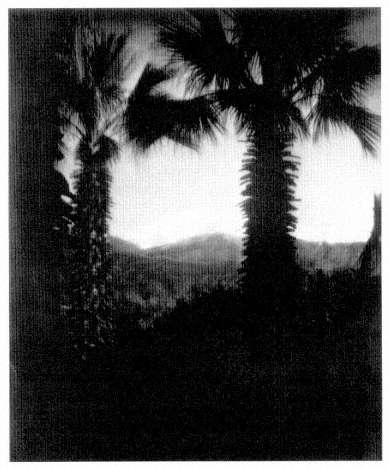
Figure 92
Karl Struss, In the Southland, Mt. Baldy, California ,
ca. 1921. The Oakland Museum, gift of the Knott Fund.
Such claims, outrageous to some, fired a debate that soon became acrimonious, and Bay Area photographers who engaged in it did not simply return to recording facts. They countered old-style pictorialism with a revolutionary style—"seeing straight." The lines were drawn: one observer noted that Edward Weston had "dared more than the legion of brittle sophisticates and polished romanticists ever dreamed."[4]
Eight or nine years before Group f. 64 was formed, Weston had turned away from pictorial practices, proclaiming his change in aesthetics in a series of briefly stated technical steps in his daybooks. He minced no words in this 1930 entry:
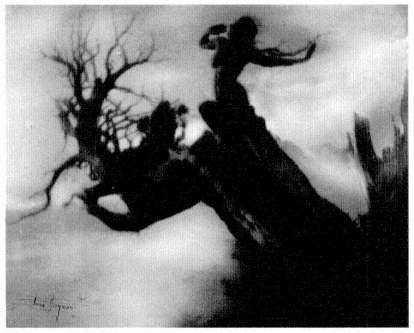
Figure 93
Anne Brigman, The Storm Tree , 1912. The Oakland
Museum, gift of Mr. and Mrs. Willard M. Knott.
I wrote an article, published this July with examples of my work in Camera Craft , a photo magazine which offers its readers just what they want .... I tempered my words, fearing the editor might not stand up under full blast. But seeing some unusually awful reproductions in the same issue by one Boris, with a laudatory article by the editor, I spent an hour writing him my mind. These cheap abortions which need no description other than their titles, "Pray," "Greek Slave," "Orphans," "Unlucky Day," have nothing to do with Art, nor Life, nor Photography. So I not very gently explained. But why did I waste my time? I know the Editor's policy, his outlook from his writing and magazine in general: backing my work and opinions, his publication would fail!
I am in a mood to stir things up![5]
As a reformed pictorialist, Weston often led the attack against shimmer and simper, crusading to attain the "straight" image Willard Van Dyke came to call "pure photography." Earlier in 1927, Weston had promised:
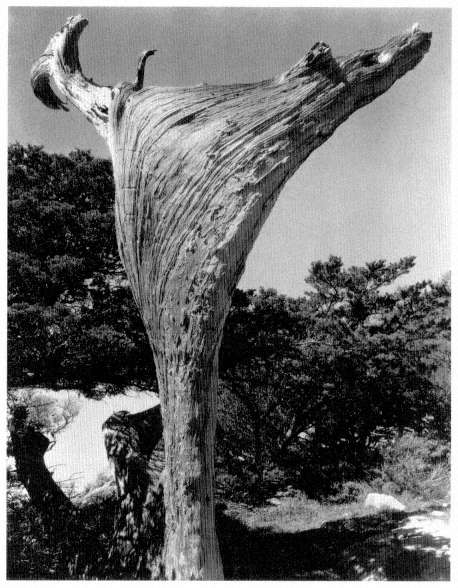
Figure 94
Edward Weston, Monterey Cypress , 1932. The Oakland
Museum, Prints and Photo Fund purchase. © 1981 Center
for Creative Photography, University of Arizona Board of Regents.
Sometime I want to give an exhibit printed on glossy paper. This shall be my gesture of disapproval for those who try to hide their weakness in "arty" presentation. [This long-held plan received fresh impetus after he viewed the International Salon of Photography at Exposition Park in Los Angeles.] Unable to definitely use Form these pictorialists resort to artistic printing....
That exhibit, excepting two or three prints, if reprinted on glossy paper, stripped of all subterfuge, would no longer interest even those who now respond ....
Those "pictorialists" were deadly serious, I grant,—so serious that the result was often comic. I took Brett, hoping to find material for discussion: there was nothing to discuss .... After noting the numbers of four photographs that had some value I referred to the catalogue, finding that each one was by a Japanese. Perhaps my exhibit in the Japanese colony has borne some fruit,—I could feel my influence [Fig. 94].[6]
None of the move away from pictorialism occurred in isolation from the other arts during these years. Important exhibitions of Bauhaus abstract art at the Oakland Art Gallery included a Lyonel Feininger solo show (April-May 1930), a show of German posters (September 1930)—which apparently included photographic material—and a Blue Four exhibition (1931). Galka Scheyer,[7] who identified herself on gallery letterhead as the "foreign representative of the Oakland Art Gallery," actively promoted German expressionist painters in the Bay Area; and in 1930 Rudolph Schindler also spoke at the Art Gallery on the relationship of architecture to the Bauhaus show.
The nexus from which change proceeded in Bay Area photography may well have been the activities of Galka Scheyer. She visited Weston in Carmel on more than one occasion in the late 1920s, and in 1930 he noted that she was a "dynamo of energy"; her insight was "of unusual clarity"; she had "an ability to express herself in words, brilliantly.... She is an ideal 'go between' for the artist and his public."[8] But we cannot know whether to attribute to Scheyer the full awareness of a new aesthetic for photography. Weston, in any event, saw himself in the forefront of a revolution. "Yesterday [March 7, 1930] I made photographic history: for I have every reason and belief that two negatives of kelp done in the morning will someday be sought as examples of my finest expression and understanding."[9]
Weston's diary entries allowed him to date his artistic growth, confident of his own originality, and he took on the pictorialists at every turn: "I have already made a showing, and hope that my next exhibit will be on glossy paper. What a storm it will arouse from the 'Salon Pictorialists.' . . . Now all reactions on every plane must come directly from the original seeing of the thing, no secondhand emotion from exquisite paper surfaces or color: only rhythm, form and perfect detail to consider."[10]
The Origin of Group F.64
Group f. 64 was initiated by Willard Van Dyke and his friend Preston Holder (Fig. 95), of whom Van Dyke wrote:
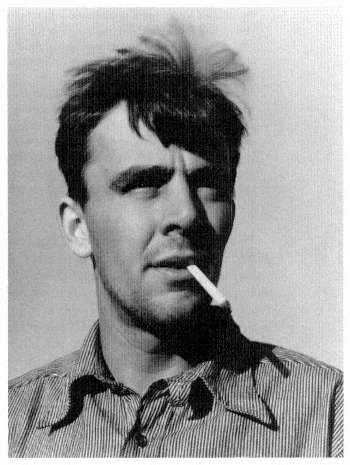
Figure 95
Willard Van Dyke, Preston Holder , ca. 1934.
Collection of Barbara M. Van Dyke.
[He] saw things much the way I did. I had gone back to the University [of California at Berkeley] after five years [in 1931] to take a few courses that interested me. A student in one of the courses happened to see a few of my photographs in a local bookstore... and introduced himself. We became close friends, drank wine and read Hart Crane and Robinson Jeffers together. Of course we both had blue-papered covers of James Joyce's Ulysses and carried them everywhere as a protest against the Philistines.[11]
Holder soon acquired a camera, and the two men took trips:
After one afternoon of art and wine... Preston suggested that we ought to form a group of like-minded Western photographers and begin to exhibit our work together. I was excited about the idea; it appeared to me that this would provide an opportunity to make a strong group statement about our work .... I, for one, felt that it was time for the Eastern establishment to acknowledge our existence.[12]
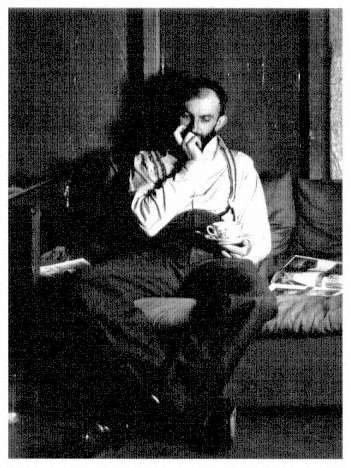
Figure 96
Willard Van Dyke, Ansel Adams at 683 Brockhurst , ca. 1933.
The Oakland Museum, Prints and Photo Fund purchase.
Van Dyke knew that Alfred Stieglitz had been patronizing to Weston when Weston went to New York in 1922. He also believed that Weston's photographs were superior to Paul Strand's, that Imogen Cunningham's plant forms and nudes were very fine, and that Ansel Adams (Fig. 96) was beginning to understand the Sierra Nevada. Not long after the talk with Holder, when Weston was in town and a party was arranged for him at the 683 Brockhurst gallery in Oakland, Van Dyke brought up the question of forming a group. In addition to Weston, Van Dyke, and Holder, the party guests included Ansel Adams, Sonya Noskowiak, Imogen Cunningham, Mary Jeannette and John Paul Edwards, and Henry Swift.
"Here [at 683 Brockhurst] we named the f.64," Van Dyke remembered. "Photography opened a whole new world to me. I was so excited that there were other photographers around this area who saw things much the same way." Several names were tried in the liquid party atmosphere of that first discussion:
We got together one night ... and I presented the idea of our working together. I said besides that I've got a wonderful name for it, U.S. 256 [after the old rapid rectilinear lens that Weston used to get the maximum depth of field and to make his negatives appear sharper]. Well there was this kind of blank look around the room and then Ansel who was the scholar of the group, said, "Oh, you mean in the uniform system 256 equals f 64. But don't you think f 64 would be a better name. Nobody is going to be using the uniform system much longer and besides that beautiful f followed by a 6 and 4," and he drew it out, like that and you could suddenly see the cover of the catalogue or the announcement and the graphics were there and Ansel won.[13]
James Alinder's lively interview with Preston Holder in 1975 includes that photographer's memory of the naming of the group. He describes a drunken ferryboat ride with Van Dyke from San Francisco back to Oakland, during which they talked about how the f would produce nice Bauhaus-inspired graphics. Holder said the group should be called "f/64, because that's what you want to stop down to anyway and that's a good rationale for it, a catchy name and a good symbol."[14]
The Group's Exhibition Statement
Despite the diverse activities of the leading members of Group f.64, they crafted a strong unifying statement, as did other avant-garde art movements. Their six-paragraph proclamation is notice of a revolution. It appeared at the group's first exhibition at the M. H. de Young Memorial Museum in San Francisco and was issued in the name of the group to make its ideas directly available to museum visitors and, more pointedly, to photographers—especially pictorialists, whose style was then still publicly accepted—and to their critics. It was purposely framed in plain language, with few technical terms. It was a rallying cry to the
great number of serious workers in photography whose style and technic does not relate to the métier of the Group .... The members of Group f.64 believe that Photography, as an art-form, must develop along lines defined by the actualities and limitations of the photographic medium, and must always remain independent of ideological conventions of art and aesthetics that are reminiscent of a period and culture antedating the growth of the medium itself.
It is likely that the statement was written and produced by Van Dyke, with help on the wording from Holder. A clue to authorship is the Americanization of "technic," since Van Dyke uses this form in letters to Weston. Van Dyke, particularly in his early writing, shows a clear, precise style that avoided the doctrinaire yet was audacious.[15]
Weston's few references to the group occur in a short chapter that the editor of his daybooks, Nancy Newhall, entitled "F64"; many readers have been led to these two
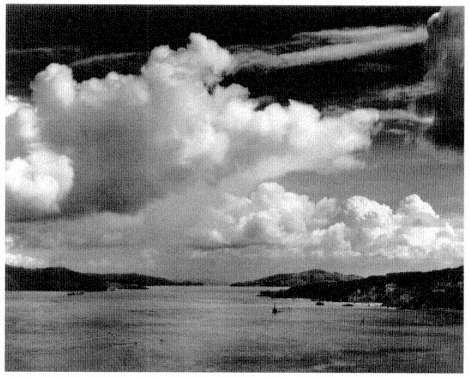
Figure 97
Ansel Adams, The Golden Gate before the Bridge, San Francisco,
California , 1932. The Oakland Museum, gift of the Estate of Helen Johnston.
© 1995 by the Trustees of The Ansel Adams Publishing Rights Trust. All rights reserved.
pages. There Weston noted, "Some have expressed astonishment that I should join a group, having gone my own way for years." This short entry has led many later authors to assume that at this time Weston was more preoccupied with personal achievement than with the goals of Group f.64. In his introduction to his solo show in New York in 1932, Weston cautioned, "Too often theories crystallize into academic dullness—bind one in a straitjacket of logic,—of common sense, very common sense."[16] With that, he explained that in an uprooted society the camera can be a means of self-development. If there was one idea that held the group together, it was this belief in the power of photography as a means of personal expression.
As to how well individual members accomplished this goal, opinion varied. Years later, Adams (Fig. 97) remembered: "In the wild heat of formation . . . mutual excitement, wonderful things happen. And then the thermostat goes on. The f 64 group made a great contribution, [an] affirmation of certain basic facts in photography that
would not have been needed if the general level of photography had been high enough."[17] Adams saw Group f. 64 as "an organization of serious photographers without formal ritual of procedure, incorporation, or any of the limiting restrictions of artistic secret societies, Salons, clubs or cliques." The group would accept "any photographer who in the mutual favorable opinion of all of us, evidences a serious attitude, a good straight photographic technique, and an approach that is basically contemporary," admitting that "friendly but frank disagreements exist among us."[18] Surprisingly, Adams named seven photographers who had been considered for membership, among them Consuelo Kanaga and Dorothea Lange (who was not invited to join); in his own gallery show he did not include Sonya Noskowiak.
The Exhibition
The group of photographic friends came together as a loose organization sometime after a solo exhibition of Edward Weston's work opened at the M. H. de Young Memorial Museum in San Francisco's Golden Gate Park in December 1931. The seven original members were Ansel Adams, Imogen Cunningham, John Paul Edwards, Sonya Noskowiak, Henry Swift, Willard Van Dyke, and Edward Weston. They arranged to exhibit their work collectively at the de Young, inviting four other like-minded artists to participate: Preston Holder, Consuelo Kanaga, Alma Lavenson, and Brett Weston.
The exhibition, which opened on November 15, 1932, and was on view for six weeks, was composed of eighty photographs: each of the seven group members showed nine prints (Adams had ten), their guests four apiece. The museum's checklist was arranged by artist, suggesting that the gallery spaces were similarly arranged. Seen together, the images established a varied but mostly singular point of view. For the most part, objects were seen up close, framed by the sky or another neutral background. Nothing was moving, and there was great attention to the finely detailed surface textures of the subjects. There was little in the photographs to suggest either the modern industrial world or the troubles of the times.
Most accounts of Group f. 64 note that it was primarily social and short-lived; that it exhibited only once; that after that first venue the group disbanded and the works were not seen together again; and that the audience was therefore limited to those who saw the show at the de Young Museum between November 15 and December 31, 1932. Yet interviews with these now-famous photographers, their own notes and letters, and newspaper reviews beginning with the exhibition reveal a different history. Hurried notes, a few initials in exhibition lists, and recently discovered letters refer not to one show but to a series. Los Angeles, Portland, Carmel, Seattle, and still other cities are mentioned as venues where the photographs were seen before they were finally returned to the lenders in late 1935. Even with the newly discovered letters from Weston to Van Dyke and Adams's notes, it is still not possible to know precisely how the first show was augmented when it traveled. Reviews suggest a larger show of one hundred works in Portland.
The storm of written protest that soon arose in the pictorialist and camera-club press also suggests that the exhibition had multiple venues; one showing at the de Young would hardly have provoked the number of articles that were eventually published. Furthermore, the group's statement of purpose called for frequent shows. It is therefore more likely that the group owed its impact and the published responses to the photographs and premises of the group to the appearance of the show, or versions of it, in other West Coast cities where photography was an important and current amateur interest.
The San Francisco Chronicle reviewed the exhibition at the de Young Museum on November 27, 1932. Neglecting either to assess the significance of this initial exhibition or to discuss the group's statement, the reviewer nonetheless praised the "beautiful work on view .... These photographers, like other talented brethren of the lens, are admirable portrait artists, imaginative creators of abstract patterns, who look for charm in boats, in scenery, in every small growing thing that is nourished at the bosom of Mother Earth."[19]
An annual report of the Seattle Museum of Art lists a Group f.64 exhibition from October 4 to November 6, 1933.[20] This exhibition apparently went on to the Portland Museum of Art; two printed discussions reviewed f. 64 work as well as that of a complement of Oregon photographers exhibiting at the same time. In November 1933 a reviewer noted in the Spectator that "from the viewpoint of the artist, the display of prints in the downstairs galleries at the Museum of Art is one of the most interesting exhibitions of photographic art ever shown at the museum .... The work of Edward Weston particularly shows fine technical composition and artistic viewpoint .... The entire group seems to feature the objective representation of carefully selected form."[21]
In addition to these northern venues, portions of the Group f.64 exhibition appeared at the 683 Brockhurst gallery and at Mills College in Oakland,[22] at Ansel Adams's Geary Street gallery in San Francisco, and at the Denny-Watrous Gallery in Carmel, as well as in Los Angeles. There is mention of a possible New York venue. Weston, who had shown work in New York, wrote to Van Dyke on January 27, 1933, questioning the wisdom of going there with an exhibition "that may be a bad move or gesture for me to make this year don't you think that the group is a bit hasty in wanting to show this year?"[23]
A New Direction
A confirmed pictorialist, the reviewer Sigismund Blumann, writing in Camera Craft in May 1933, provided the first considered review of Group f.64's premier exhibition:
The name of the organization was intriguing. The show was recommended to us as something new, not as individual work might go but as a concerted effort specifically aimed at exploiting the trend. We went with a determined and preconceived intention of being
amused and, if need be, adversely critical. We came away with several ideals badly bent and not a few opinions wholly destroyed The Group is creating a place for photographic freedom.
... [Y]ou will enjoy these prints. You will be impressed, astounded.[24]
Although Blumann revealed that he preferred the familiar and the romantic view, he clearly recognized a new force abroad in photography.
Blumann's encouraging words were countered, however, by other voices. Albert Jourdan, a little-known and quite bitter photographer from Portland, Oregon, condemned the straight photography movement as unoriginal. In his aptly titled essay "Sidelight #16: The Impurities of Purism," he dismissed Group f.64.[25] He recounted his own initiation into pure photography in 1931, describing how "the carcass" of the "Latter Day Purist" movement, which originated in Germany, was brought "across the Atlantic and the continent, [given] a few shots ... and, very recently, proclaimed ... a 'definite renaissance,"'—an account he concocted out of whole cloth because some German photographers' works were on view in Oakland in 1930. In Jourdan's view, "Moholy-Nagy is one originator of Pure photography, along with other Bauhaus members," all of whom, Jourdan noted, worked before Weston. While it is not surprising that the transmission of European and East Coast ideas to the West Coast would take time (in painting it often did), European photographers recognized that several Americans had taken the lead sometime between 1913 and 1920. That it took Weston eight or nine years to "convert" hardly seems reason for Jourdan to impugn his work or his goals.
Probably because contemporary events overshadowed the activities of artists, most histories have overlooked the subsequent versions of the initial Group f.64 exhibition. Despite the group's marked activity during 1932 and 1933, the newspapers, generally preoccupied with the seriously depressed economy, gave only the briefest attention to announcements about art. Publicity for Group f.64, therefore, may not have been what one would expect. To compound the problem, the newspaper the Carmelite had gone out of business, making it more difficult to give the Denny-Watrous exhibition adequate notice in Carmel, where Weston was based.
In addition to their involvement with Group f.64, members were actively pursuing their own careers. In 1933 Ansel Adams went to New York and had a momentous meeting with Alfred Stieglitz, the acknowledged leader of fine art photography and owner of the influential gallery An American Place. On the West Coast, Willard Van Dyke and Mary Jeanette Edwards had taken on the demanding task of establishing their gallery at 683 Brockhurst in Oakland as a center and forum for West Coast photographers, in an attempt to bring national and specifically East Coast attention to their work. And during the months before the de Young opening, Edward Weston was engaged in the production of his beautiful new book The Art of Edward Weston , which
was on press in late September 1932 and available for signing when the Group f.64 exhibition opened in San Francisco in mid-November. California Arts and Architecture magazine carried a prominent picture endorsement for the book in its November 1932 issue—just the kind of publicity the group would have wanted for its show.
Perhaps the most likely reason for the curious silence about the later six versions of the Group f.64 exhibition can be traced to Lloyd La Page Rollins, then director of the de Young Museum. Although he was the sponsor of Group f.64, the museum's board of directors did not support his championing of photography, and Rollins ran into trouble because of the space photography had come to occupy in the galleries. It seems that he had replaced many of the not-very-distinguished paintings the board had donated to the museum with new photography exhibitions. The board asked him to resign in April 1933, just five months after the opening of the Group f.64 exhibition.
Although the f.64 show was sent to its subsequent venues and was listed in Camera Craft as an exhibition available for travel, both promotional materials for the touring museums and dedication to the project were probably in short supply once Rollins had resigned. In his daybooks Weston had earlier explained that the show would go to the de Young "out of consideration for Rollins," who had requested that the group not open its own gallery to compete with his program. After his departure, however, the issue of competition was moot. Necessity now required a gallery to promote "straight seeing." The first in the Bay Area to take up this challenge was 683 Brockhurst.
The Group's Aesthetics
If we analyze the de Young checklist of the Group f.64 show, we find images of still life; bits of landscape, posts, bones, and sky; a few industrial buildings; portraits; and nudes or figure studies. The subjects were ordinary, yet most had a commanding presence when photographed. The emerging aesthetic proved broader than the group's manifesto, more generous in its means; filters, dodging, and arranging still lifes were all accepted in one case or another.[26] Isolated instances of technical manipulation evidently met the group's ideal of an art form obtained by "simple and direct presentation through purely photographic methods."
Although Group f.64 distanced itself from the pictorialist tradition, at least four of its members had produced fine pictorial work in the 1920s, and three continued to do so until 1931. Their established friendships, moreover, clearly went back to the pictorial days. Roger Sturtevant, a close friend of many Bay Area photographers, remembered a congenial opening in the mid-1920s when Edward Weston was in San Francisco. It drew many photographers, who were themselves photographed there in a series of hilarious pantomimes. Weston and Anne Brigman posed in costume as the father and mother of photography, with the "children"—Roger Sturtevant, Johan Hagemeyer, and Imogen Cunningham—framing them in adulatory, prayerful poses. Roi Partridge, Imogen's husband, took the photographs.[27]
683 Brockhurst
Willard Van Dyke, a central figure in founding Group f.64, continued to provide a focus for Bay Area photography. In 1928, two years after he left the University of California at Berkeley, Van Dyke assisted in making and showing lantern slides for lectures by the much-honored but unconventional tonalist photographer Anne Brigman. Her studio at 683 Brockhurst Street in Oakland was a center of creative activity and a meeting place for artists.
Brigman's ardent love of nature surfaced even in domestic decisions:
When the barn at 683 Brockhurst was remodeled, as a studio, a problem arose in building the bathroom. The only logical place to put it had a lovely tree happily growing in that exact spot ... of course there could be no question of removing the tree. All the carpenters had to do was build the walls around it, provide a hole in the roof for its trunk, and then hang the shower from one of the lower branches. A true daughter of Zeus, Annie never interfered with nature.[28]
Van Dyke and his friend Mary Jeannette Edwards, whom he wanted to marry, had taken over this studio by 1930, intending to establish a gallery for photography. Brig-man had gone to live in Southern California to be near her sister and rented it to them for twelve dollars a month. Van Dyke stated that while he and Mary Jeannette certainly did not consider themselves in competition with Stieglitz, they felt that by establishing a gallery for photographers, they could provide "an atmosphere on the West Coast that could be useful to Western artists. I think . . . our first exhibition, on July 28, 1933, was a retrospective of Edward's [Edward Weston's] work. The prints were displayed in chronological order . . . from 1903 when he began . . . to his most recent photographs."[29]
Although the couple changed little of the charming character of 683, its board-and-batten walls presented an aesthetic problem in the exhibition of photographs. A photographer friend of Mary Jeannette Edward's father, a talented designer, helped to solve it. Van Dyke describes the process: "First he covered the whole surface with monk's cloth ... that he pasted over the wood. Then he brought enough tea paper to cover the surfaces . . . with the gold or silver metallic material. Then he sponged water paint in colors of violet and blue over the tea paper and wiped it lightly before it dried. This left a colored, textured surface with flecks of glowing metal shining through." The gallery in this renovated space, as its stationery stated, was "devoted to contemporary expression in black and white."[30]
Camera Club Notes, a column in Camera Craft , in reporting on the opening exhibition, hailed "this charming little gallery . . . opened by two young people with a splendid enthusiasm for photography. For a long time we have felt that the Pacific Coast is a particularly fertile field . . . that here are many of the finest photographers."[31]
Weston's new landscapes caught the attention of the reviewer, who then listed the gallery owners' future plans for shows by Adolph Dehn, a lithographer; twenty-five prints by Ansel Adams, "well-known for his sympathetic photographs of this city and for his splendid prints of the high Sierra"; and works by Willard Van Dyke and Imogen Cunningham. Van Dyke closed the season with a juried show of what he defiantly called the "First Salon of Pure Photography." He remembered that "Weston laughed at the word, 'pure,' but we all were astounded at the response."[32] The hundreds of works submitted for consideration indicated that many photographers shared the group's ideals, suggesting too that after the period of innovation and diffusion f.64 had had an effect. Many photographers had accepted the premise of unmanipulated image making.
Edward Weston made it possible for Van Dyke to justify continuing in photography and opening the gallery. When Van Dyke told him he had been offered a job as district manager for an oil company, Weston replied, "To work at something just to have financial security could be compared to the life of a cow that spent its whole life filling its belly." Extrapolating from this thought, Van Dyke recalled, "He knew that I had talent but if I decided to go on and develop it, I had to realize it would require sacrifice and uncertainty." Weston referred to this as the decision to "turn down the bitch goddess Success."[33]
Women in Group f.64
The members and associates of Group f.64 were generally well educated in the ways of commercial photography by the early 1930s. They were mainly self-taught, although two were experienced darkroom assistants to more mature photographers (Noskowiak for Weston, Mary Jeannette Edwards for Lange). Their ages in 1932 ranged from forty-nine (Edwards) to twenty-one (Brett Weston), but most were in their thirties or earl), forties. They all tended to accept the authority of Edward Weston's years of photographic experience. And, notably, women were strongly represented among them.
The study of Group f.64 invites speculation about why so many women were empowered through their association with a predominantly male friendship group that might have ideologically subjugated women as darkroom assistants and mere receptors for male creativity.
Very likely the acceptance of women into the group was made possible after World War I by the emergence of the "New Woman," demanding the right to work and vote. As early as 1913 eager women writers explained admiringly that Anne Brigman and Laura Adams, a successful San Francisco portrait photographer, could be independent in photography, as this work was "suitable" for women, needing no large capital outlay, no long schooling or learning beyond the usual education of women. Women's "intuition" was cited as justifying their special talent for portraiture, particularly—it comes as no surprise—of children.[34]
Imogen Cunningham, on her own after European study and schooling in chemistry, began an innovative and provocative series of male nude studies of her husband, Roi Partridge, who was pictured faunlike in settings of the Washington hills and mist-covered lakes. For financial support she also pursued studio portrait work, photographing children and their families, while continuing to keep in touch with the magazines and shows that led the way toward modernism (Fig. 98).[35] Cunningham's direct, no-nonsense personality led to her willful decision in 1934 to go to New York despite Roi's disapproval. The trip resulted in divorce. (Anne Brigman had taken a similar trip, with similar results, in 1910.) Cunningham continued executing portrait commissions to support her twin sons and a slightly older son, all under the age of nine. Perhaps because she assumed these responsibilities, her male colleagues considered her a professional, a fine art photographer, an equal, and a friend. In 1928 Weston sent her a gloriously complimentary letter, telling her that her photographs were the best in the San Francisco salon.[36] Possibly her sense of fun and her sharp wit gave her powerful weapons in any struggle for parity with men in the group. Cunningham was always treated with respect.
Sonya Noskowiak's initial position in the group was as a dependent. Her progression from receptionist in Johan Hagemeyer's Carmel studio, where she met Weston, to Weston's general helper, darkroom assistant, and then model, mistress, and companion is well known. The daybooks chart the circumstances of their relationship as well as Weston's egocentric appreciation of Noskowiak's photographs in January 1930, almost her very first: "A negative of Neil's hands, the back of a chair, and a halved red cabbage. Any one of these I would sign as my own. And I could not give higher praise. She is a surprise."[37]
Consuelo Kanaga was an unusual participant in the f.64 exhibition of 1932. Young, naive, and working on her own for newspapers, she was dependent on her patron and sponsor, Albert Bender, who was also important to the careers of many members of Group f.64. She knew them but was shy, reluctant to become involved. In her letters to Bender she repeats her reservations and doubts.[38] Even her early pictures were of social themes. For example, she made black-and-white photographs illustrating blacks and whites holding hands (Fig. 99). Her 1928 portrait Frances , of a sweet-looking black
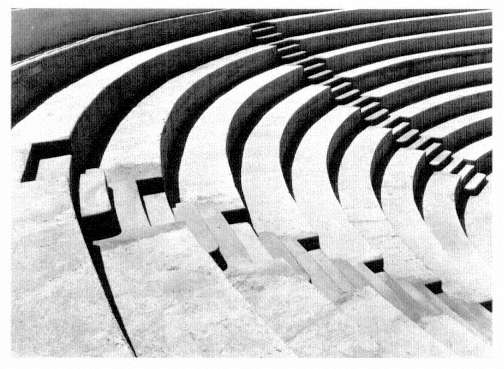
Figure 98
Opposite, top : Imogen Cunningham, Mills College Amphitheater ;
ca. 1920. © 1978 The Imogen Cunningham Trust.
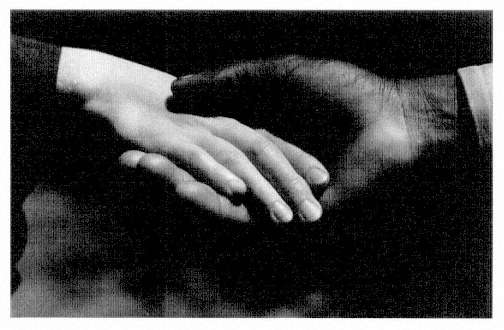
Figure 99
Opposite : Consuelo Kanaga, Untitled (Hands) , 1930. The Brooklyn Museum, gift of
Wallace B. Putnam from the Estate of Consuelo Kanaga through the Lerner-Heller Gallery.
child, was considered out of the ordinary, as the Bay Area black population was then small. Unlike Arnold Genthe, who sought the exotic and alien "other," Kanaga pictures Frances as a child who happens to be black. Kanaga's picture conveyed an innocent message of racial understanding in which potential conflicts are easily resolved. Kanaga was interested in the way black-and-white photography could make social statements; only in passing did she consider photography a fine art.[39]
When Alma Lavenson went to Carmel in 1930 to meet Weston, he urged her to reconsider the soft-focus atmosphere of her prints.[40] She was self-taught, and like the others in Group f.64 she had learned the craft thoroughly. She renovated a childhood playhouse as a darkroom and created photographs by first visualizing them in her mind. She accompanied friends who painted and etched scenes at the Oakland waterfront, photographing that active port. Its warehouse buildings and ships' riggings became a favorite f.64 subject.[41] From the outset, Lavenson's pictures were successful in competitions.[42] Although she did not know other photographers at first, she did subscribe to camera magazines, and she had good equipment; her family, through a successful mercantile business, was well able to afford it. With letters of introduction from Albert Bender, a family friend, she met Imogen Cunningham, Consuelo Kanaga, and Edward Weston. Although her contact with Weston was most significant for her photography, Cunningham had greatest influence on Lavenson's activity as a photographer: "I met her in 1930, somehow or other we became close friends and we remained close friends until she died forty years later. I photographed with her and we travelled together. . .. She never criticized my work, she never praised it."[43]
These remarkable women were acknowledged as peers by their Group f.64 male contemporaries. Only later did a silence come to surround their work—a silence created by exhibition curators, art dealers, and photographic historians in the 1950s. Although Lavenson and Cunningham continued to live and photograph in the Bay Area, they were not singled out for solo shows until their careers were validated by their remarkably long lives. As Cunningham noted, she and other women photographers in their fifties were invisible; only when she reached seventy did she become a celebrity.[44]
Art and Life
The basis of the group's manifesto began with light; its chemical action on sensitized surfaces described the process of photography. Light was the only legitimate medium for photography, and much of the success of an artist photographer lay in controlling it. In the West, light meant sunlight, filtered sunlight—in Weston's case, cheesecloth was stretched like a tent roof over the open porch outside Hagemeyer's studio. Here Weston obtained a beautiful high, strong light and made the portraits that earned him his living. Charis Wilson, who later became Weston's wife, remembered that the light there pleased him, and he photographed such local notables as Robinson Jeffers and Lincoln Steffens.[45] The cheesecloth over the porch was equally good for still lifes. Every
time Weston waited for a sitter to arrive, he turned to setups. Most of the images from 1930 to 1932 that Weston included in the Group f.64 show were made on this porch.[46]
Weston's controversial 1931 set-up image, Rock and Shell Arrangement , appeared to alter the scale of reality, for the shell filled the mouth of an enormous mountainscape. Weston insisted on including the photograph in Merle Armitage's book The Art of Edward Weston and in the de Young's Group f.64 exhibition. It provoked furious letters, which Weston ignored, from those who expected pictures to be "true to nature." Westons friend Ramiel McGehee said to him: "It is a stunt and if the book was mine, I would neatly with a safety razor blade remove the print from the book. It's the first time I've known you to make nature talk a language not her own."[47] Weston denied the "stunt": "I don't have to please the public" (a brave statement but hardly consistent with his pleasure in good reviews). Weston explained the motive for publishing the picture: "It deeply moved an intelligent audience as I was moved when I first saw its presentation on my ground glass." This image is a still life set out-of-doors. In using the word "arrangement," Weston signaled to the viewer what the picture was: his own placement of elements. He noted, "I did not add that word as an apology, rather to forestall criticism from naturalists that thought I was 'nature-faking.' "[48]
As the decade continued, the problems of the depression became more widespread, affecting artists and photographers already accustomed to existing on meager commissions and few sales. In San Francisco, and even in Carmel, critics questioned the premise of art. They accused the members of Group f.64 of failing to consider economic or social problems in their photography, which continued to center on things seen for their beauty. As Weston noted in February 1932, he knew that he was on uncertain ground, and that there were "right thinkers" who would have preferred that art function as a missionary to improve sanitary conditions; in 1933 he added, "I am 'old fashioned' enough to believe that beauty—whether in art or nature, exists as an end in itself. . .. If the Indian decorating a jar adds nothing to its utility, I cannot see why nature must be considered strictly utilitarian when she bedecks herself in gorgeous color, assumes magnificent forms."[49]
The matter may have seemed clear to Weston, but Van Dyke and others found compelling the argument that photography could describe social concerns. Van Dyke wrote a long and appreciatively perceptive article on Dorothea Lange, whose work he included in a show at 683. He accompanied Paul Taylor and other photographers on a significant visit to the self-help cooperative United Exchange Association (UXA) in Oroville, California. A trained agricultural economist, Taylor was an effective advocate for liberal economic views and the necessity for new jobs. Drawn to the photographers involved in 683, particularly Dorothea Lange, whose innate sympathy and direct vision in photography matched his own, he provided the clear example of what photography could accomplish if it were made to function politically, as it did when Lange's photographs led to the funding of a migrant workers' camp.
Despite their differences of opinion on photography as a political tool, Adams and
the others kept in close contact with Lange and Taylor. Later Adams developed many of Lange's Farm Security Administration negatives for her in his Yosemite studio, both Lange and Adams disagreeing with the FSA policy of insisting that photographers send their film to Washington for processing.
Weston's and Adams's strongly held belief in art for art's sake was often condemned, however. Weston wrote in his daybook that his kind of photographing could be compared to the work of a "Bohemian dabbler . . . frittering away on daubs and baubles to decorate the homes of our great democracy, using art as an excuse to loaf, to be supported like poodles, and petted by sexually unemployed dowagers—art patrons!"[50] Willard Van Dyke, socially aware and impressionable, had changed his outlook. He and Paul Taylor applied for a Guggenheim grant for a film on the UXA but were turned down. Ironically, in 1937 Weston received the first such grant awarded to a photographer—to photograph landscape.
The Legacy of Group f.64
Many factors, including the departure of several members from the Pacific Coast and Carmel, caused Group f.64 to break apart.[51] Weston went to Santa Barbara to be with his son; Willard Van Dyke (Fig. 100) left for New York and a career making movies (beginning with The River ). Although Mary Jeannette Edwards stayed at 683 Brockhurst, it is clear that she felt deserted. Returning some prints to Weston, she remarked in a letter, "I think the only course open to the group is not to show as f.64, but as a group of Western Photographers. There is such diversity in work and point of view."[52] In August 1935 she added, "Now I realize that my little 683 must be given up, as soon as I am economically able to make the move."[53]
Did the photographers who continued to be active evolve new ways of seeing and composing their photographs? Or did their increasing fame rest on the growing understanding of the general and museum-going public that photography, the pervasive language of the times, was uniquely significant? Ansel Adams evolved as a photographer, building on his extraordinary vision and technique, his passionate feeling for California land, and his ability to enlarge the meaning of landscape photography as central to environmental concerns. Weston applied his straight photography to a broader landscape on his Guggenheim trip and, in a darker view, to the final pictures of Point Lobos, but illness overcame him before major change could develop and be resolved in his work. The photographs he showed at the f.64 exhibitions constituted, as he thought, many of his most successful pictures.
Group f.64 provided a rallying place for like-minded photographers to gather, state their aims, and exhibit their carefully composed black-and-white images (Fig. 101) in defiance of the then reigning pictorialist tradition. That the proponents were young, bold, and optimistic about their chosen medium was important to the group's success. As an informal Oakland meeting place and gallery, 683 Brockhurst encouraged the
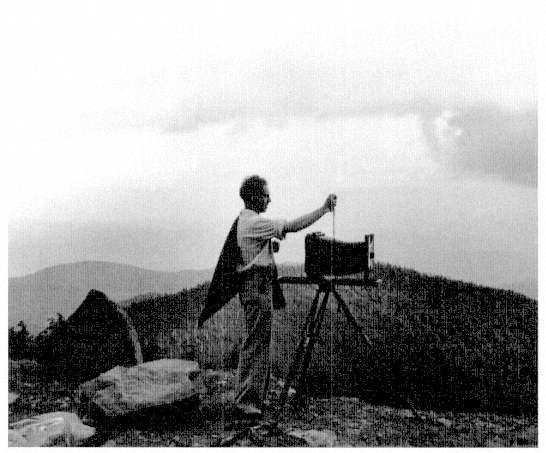
Figure 100
Peter Stackpole, Willard Van Dyke with View Camera , 1930s.
The Oakland Museum, gift of Douglas Elliott. Photograph courtesy Peter Stackpole.
revolutionary Bay Area modernist aesthetics that resulted in straight seeing and "pure photography."
Individually, four f.64 members combined their shared vision, adapting straight, clearly seen images for diverse purposes, from picturing California's stark beauty to addressing social issues. More remarkable, from this group of eight, four of the best-known and most celebrated photographers of the period emerged—Edward Weston, Willard Van Dyke, Imogen Cunningham, and Ansel Adams. One can postulate that although each of them was committed to making photographs, their collaborative effort, their entwined relationships, and their spirit of rebellion clearly benefited the
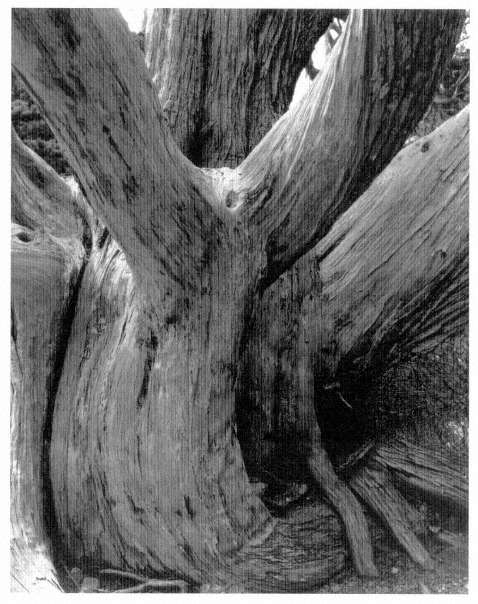
Figure 101
Sonya Noskowiak, Cypress, Point Lobos, Carmel, California , 1938.
The Oakland Museum, Photography Fund purchase.
younger members. The f.64 photographers gave an intriguing name and a specific location to a modernist movement that for the next forty years characterized American fine art photography. Cunningham captured the irony of their love of photography with humor and a determination to undermine pompous aims when she observed, "You have to be really crazy to stay in it, the way a photographer is treated . . . .You really have to be a mad person to stick to it. We did all seem to stick."[54]
Despite the pervasive and elegant modernism of a photography grounded in seeing straight and in a purist's modernist idiom, younger photographers changed, experimenting by revisiting mixed media and by striving for pictorial effects in their work. Perhaps manipulation, hand-coloring, and collage—all despised by the modernists of the 1930s—came to be acceptable once more as natural to artistic expression. Modernism in California first narrowed its focus to the purely photographic and then, by the 1950s, broadened it once more to encompass the wide range of media and images that could be imposed on paper.